ALLIGATOR
BEHAVIOR part 8c: DENS, BURROWS, HOLES--page 3 page 1 2
This
page was born 02/02/2022 as an expansion of the page
started
12/08/2013. Rickubis designed it. (such as it
is.) Last update: 07/13/2023
Images
and contents on this page copyright ©2013 -2023 Richard M.
Dashnau
Alligators
alter their environment in various ways.
They can make "gator holes", or "burrows" (which are sometimes
called
"dens".) During my time at the park (more than 20 years in
2022),
I've been able to see some of
these structures. While there are many references to alligator
burrows,
or dens, I can find little information on the actual shape and
size of
them. I've found
some information in the book "Life
Traces of the Georgia Coast ", by Anthony J. Martin,
phD., and
his companion
website of the same name.
The alligators make their structures
to alter the environment to their advantage. Gator burrows can
serve
as shelter from extremes in temperature (both hot and cold);
as a
receptacle
for water (it can maintain some moisture within); and even
as a temporary shelter from fire. An alligator den is usually
excavated
under
the water. It goes straight for about a meter
(3.28 ft), then can turn
right or left. The burrow continues until an end chamber -
sometimes
above the water table, sometimes not - that is wide enough for
the
alligator to turn around.
Dr. Martin has measured at least one
den that was 4.6 meters (15 ft) long! He and his associates
used tape
measures and ground-penetrating radar to take these
measurements.
Most
of my other pages are arranged with the newest posts on top (
I figure that most folks are interested in current
events.).
But
these den observations make more sense arranged
chronologically,
so...that's how they are arranged on this page. Starting in
2019, I had
the good luck to be able to watch the behavior of female
alligators
with pods and dens.
I
could take many pictures, so I've expanded to multiple pages.
The
observations of the mother, pod, and den that begin here are
actually a
continuation of observations of a
mother gator and pod that is associated with one of the nests
described
on this alligator
babies page, which
describes alligator nests and babies starting in June 2021.
On 11/28/2021; when
I arrived at BBSP. The
day
was cold, damp, and Grey; but there was no breeze, so 40 Acre Lake
was smooth. These two pictures show the view to my East and the West.
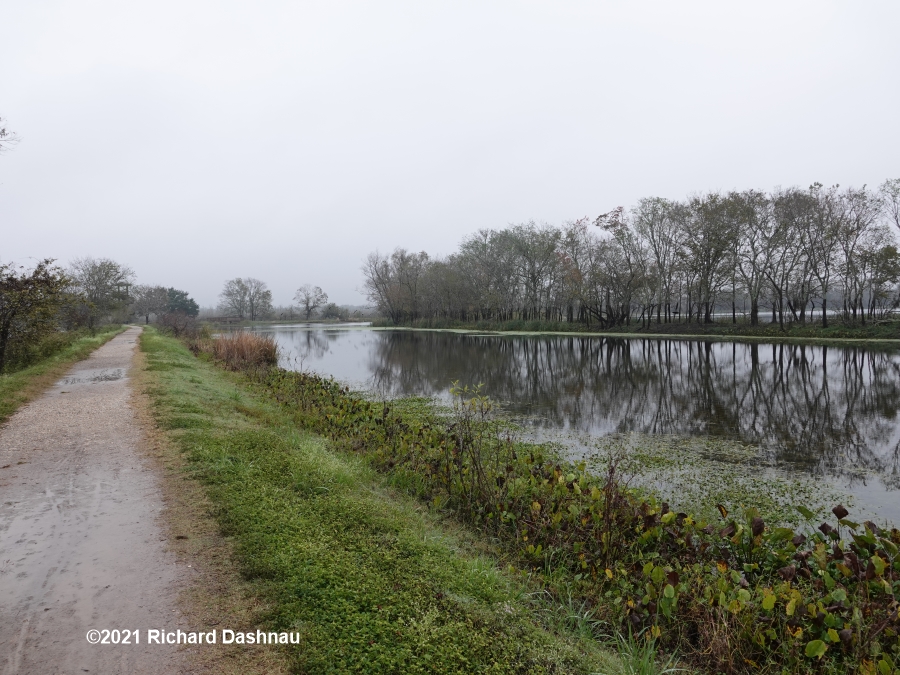
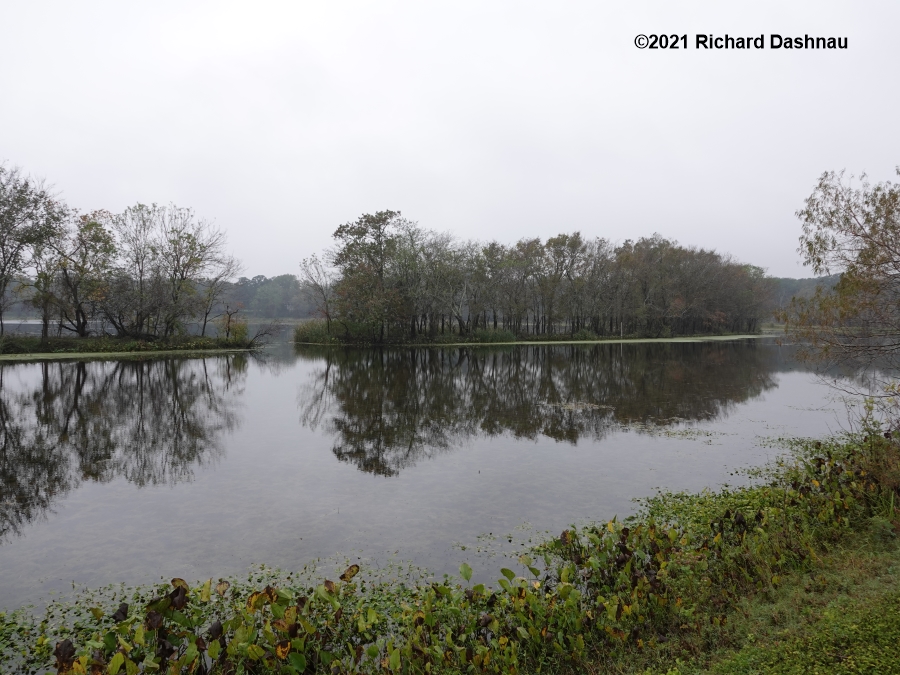
At
8:15 The pod of baby gators and their mom was still in
place, though
they were still under cover. Mom gator had mud on her head,
so I think
she's still burrowing at that spot.
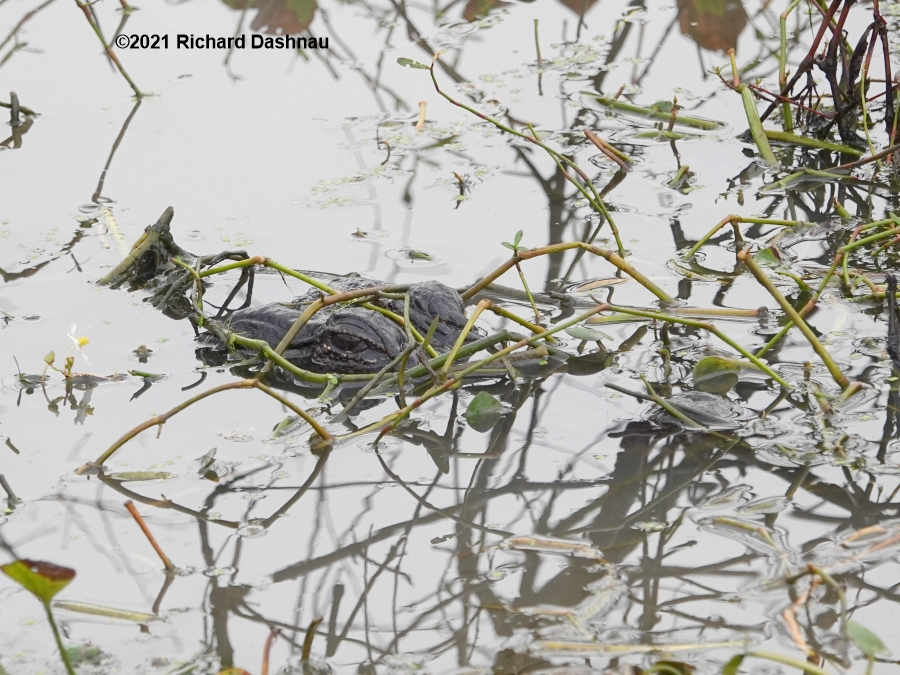
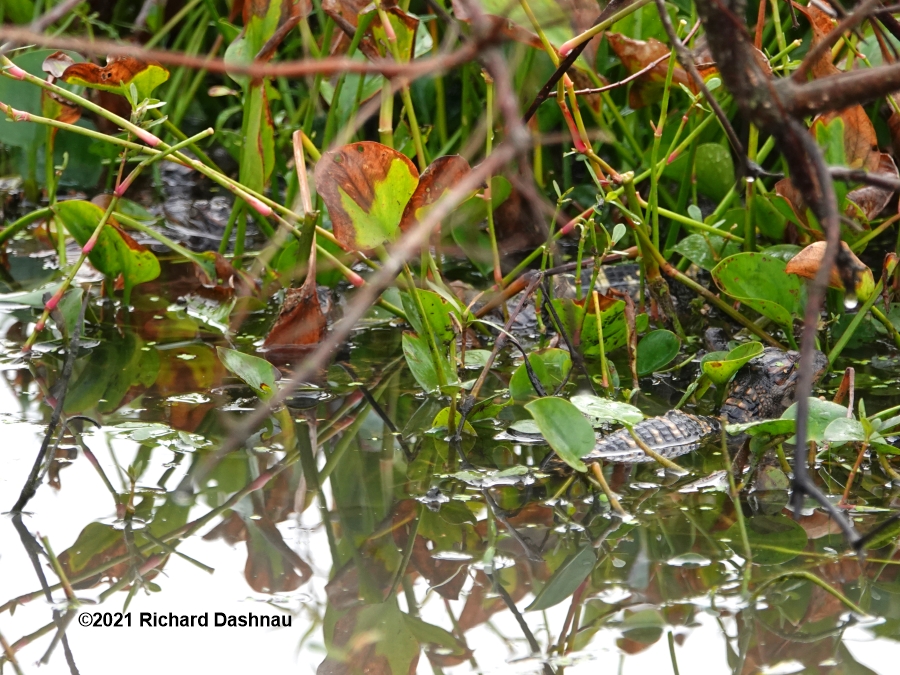
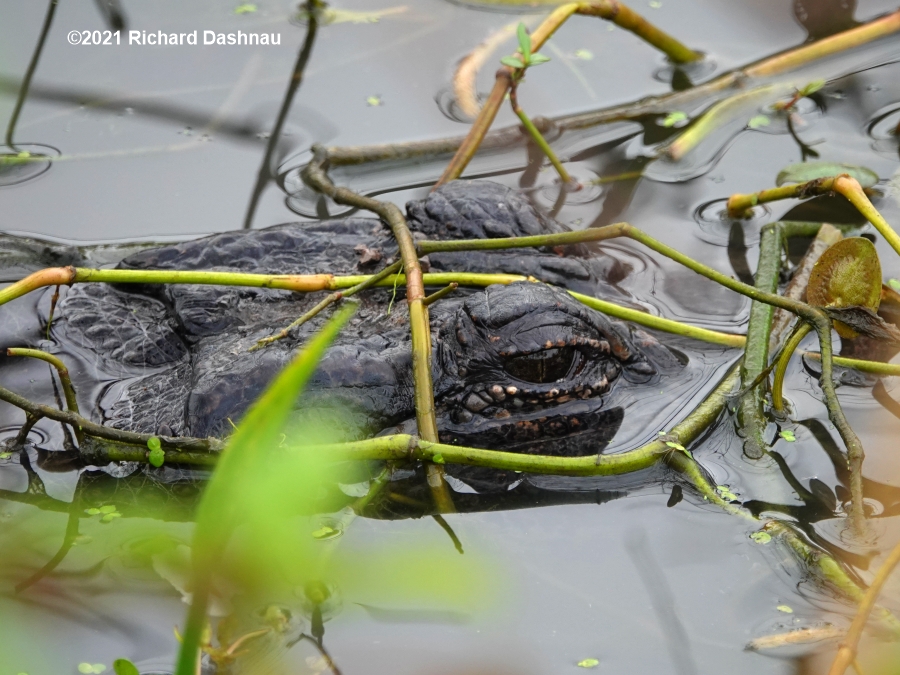
I
had to get back to the Nature Center, so had to
leave. I
took a few more pictures of the mother gator. Thermometer
said 48 deg.
F. I could see traces of mud on her snout, also.
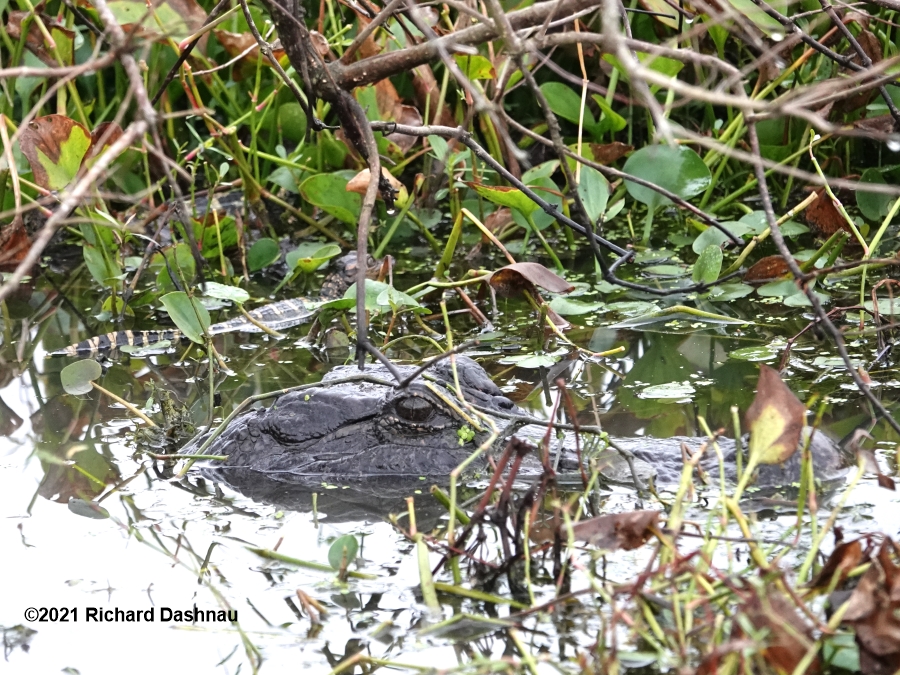
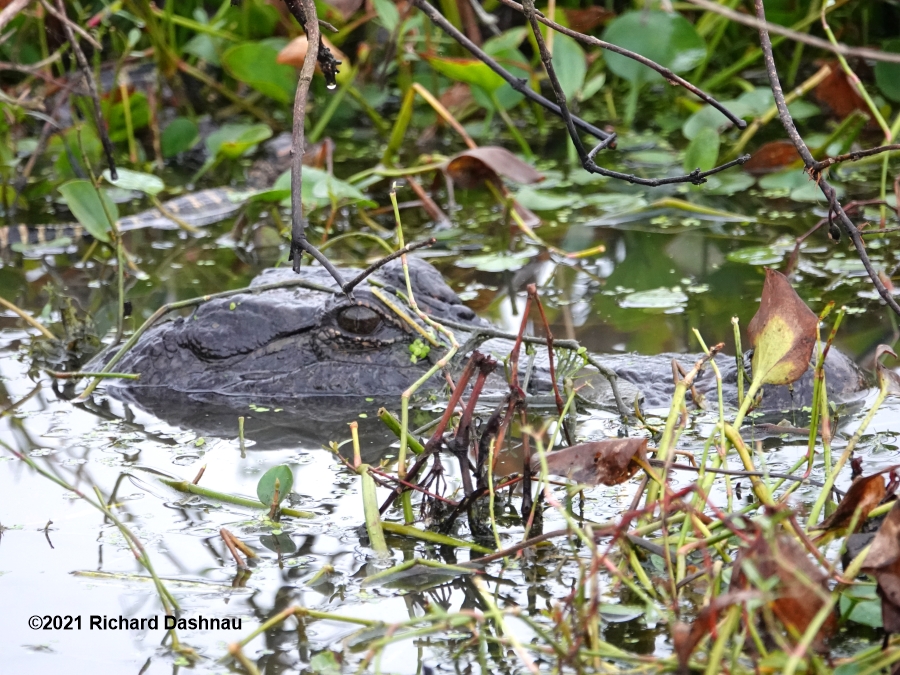
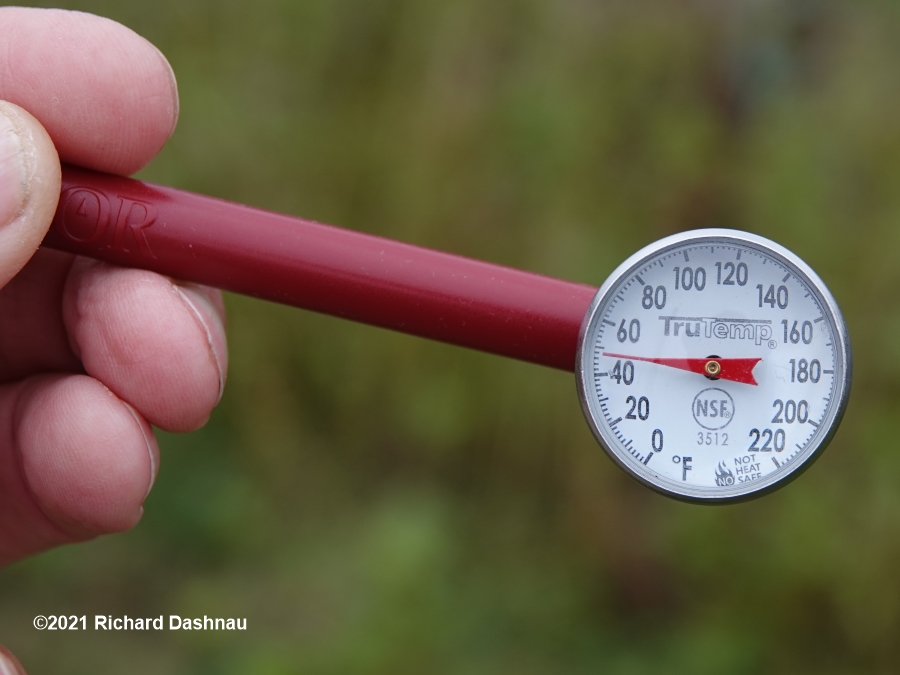
I
returned to 40Acre lake at
1:30.
I
stayed near the baby alligators and their mother for about 45
minutes,
interpreting for visitors (mostly about the baby gators).
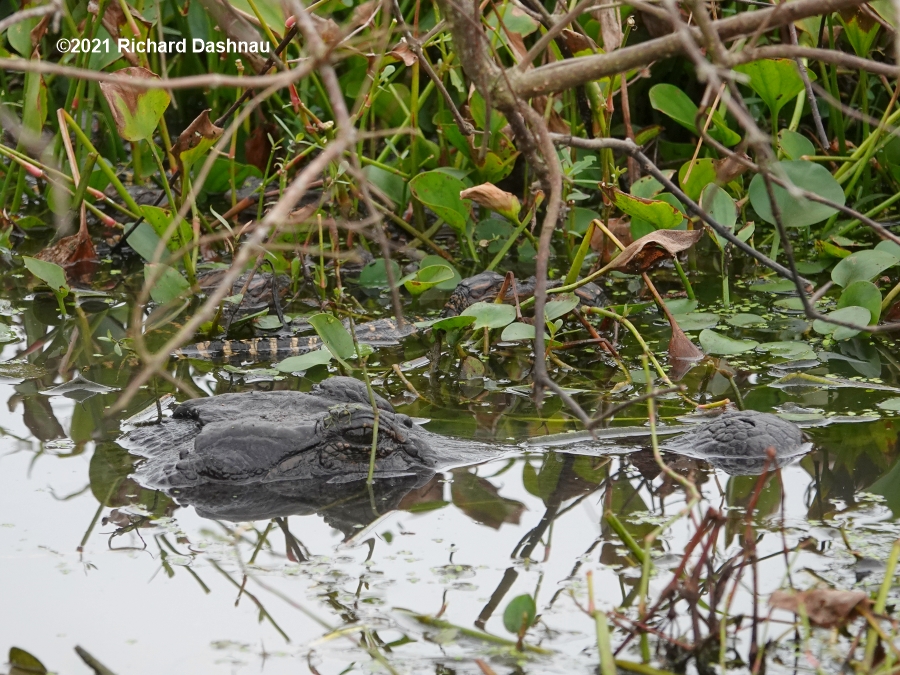
12/05/2021 I
didn't take a temperature reading today. But,
temperature
data
that I can find online shows that the temperature at Hobby
Airport
(about 30 miles Northeast)
was near 70 degrees F at 9am. The mother gator was near
her
den, and the babies were already out on the bank at
8:20am. The mom
gator submerged at about 8:30, so
I watched the babies.
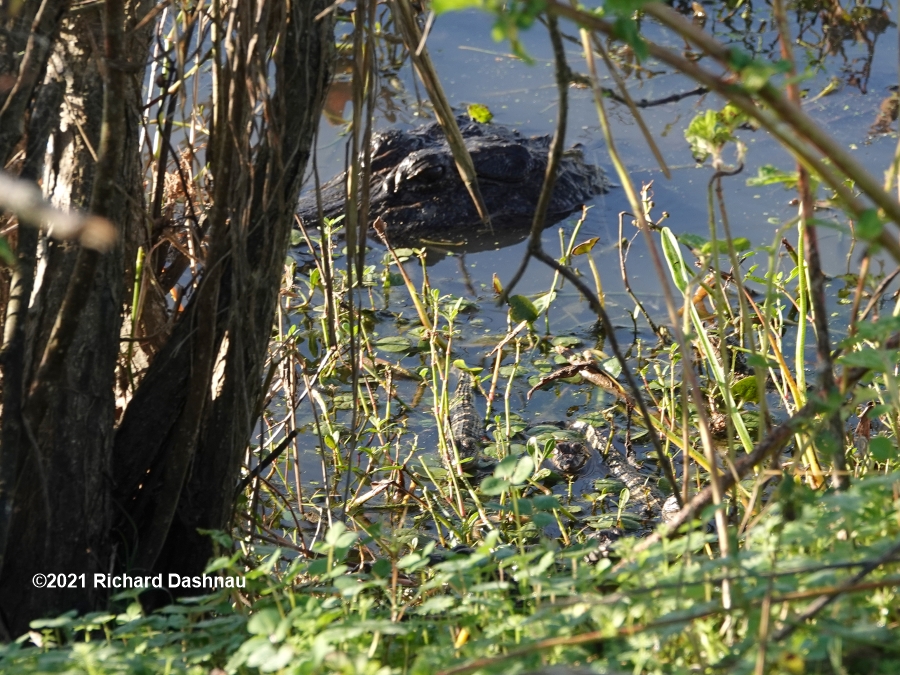
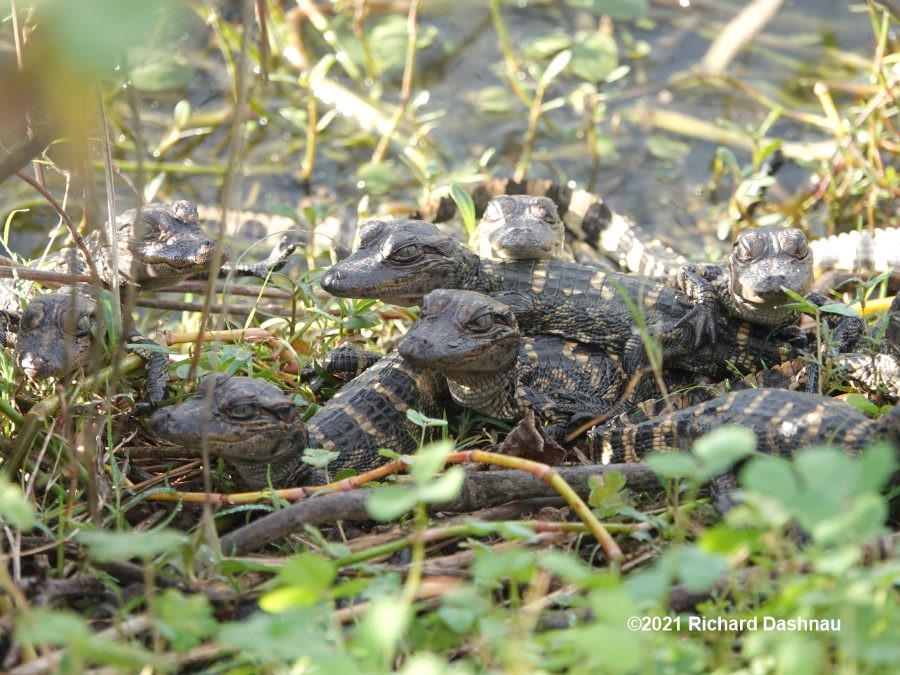
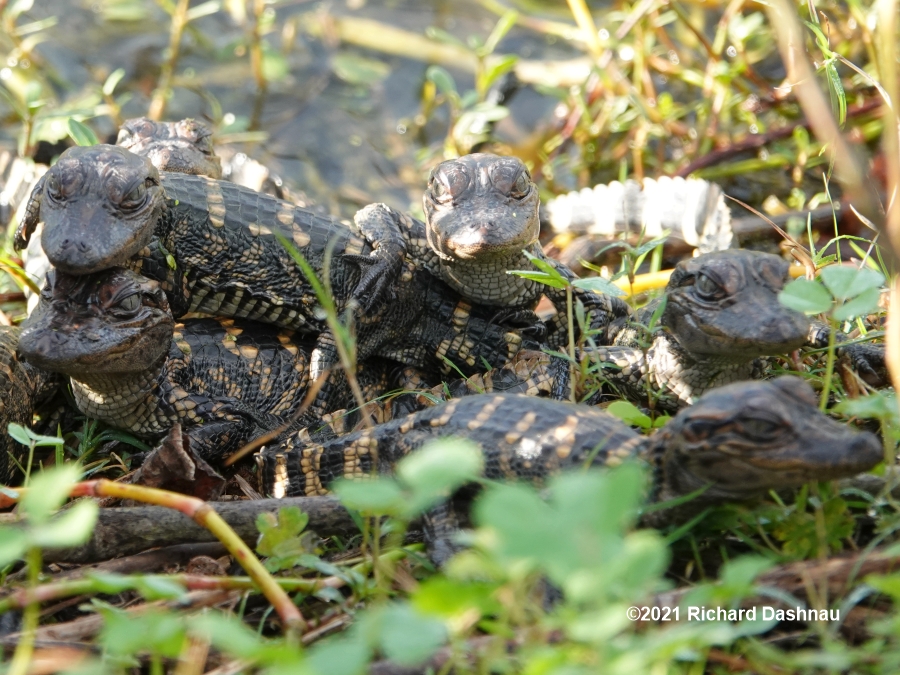
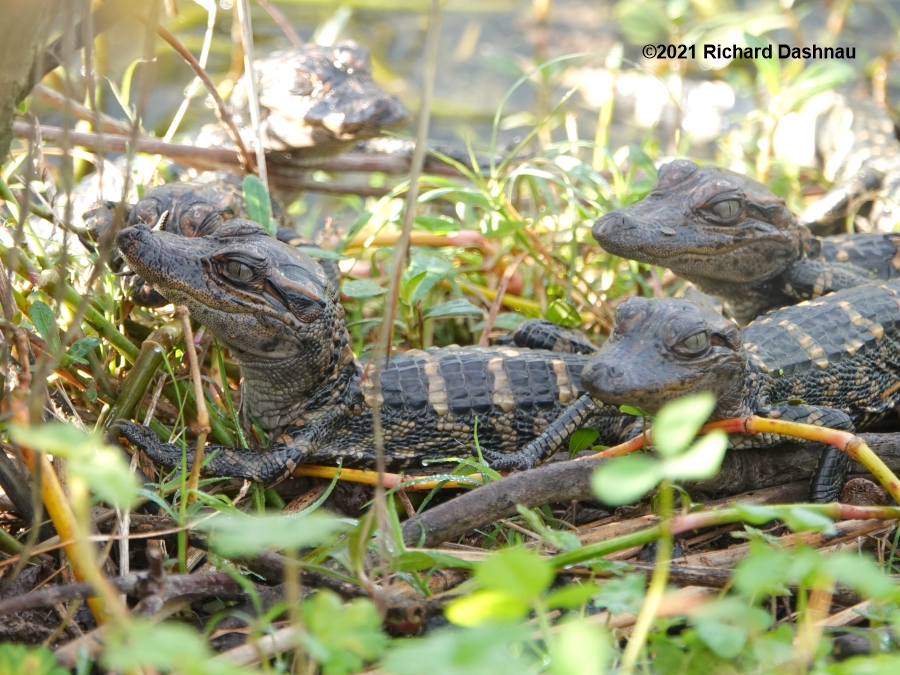
The
mother
gator appeared at 8:43 (about 20 minutes later). Since the
water
was clouded with silt, I couldn't see where she'd been. But,
her nose
was covered by a clump of
mud, and her snout and head were smeared
with it. She must have been digging in her den. She made
"chomping" motions, and seemed to be trying to wash out her
mouth.
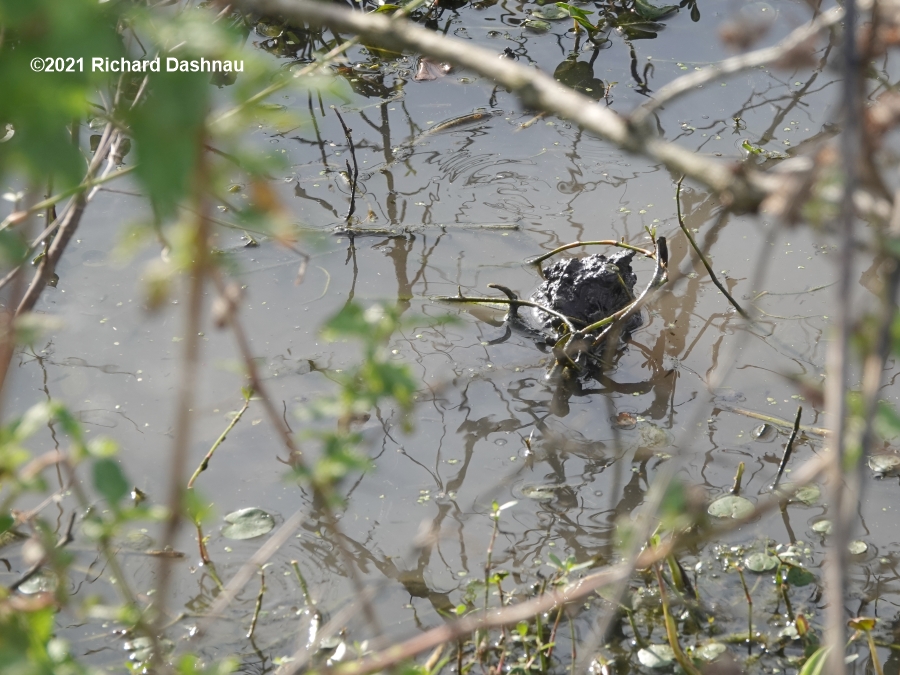
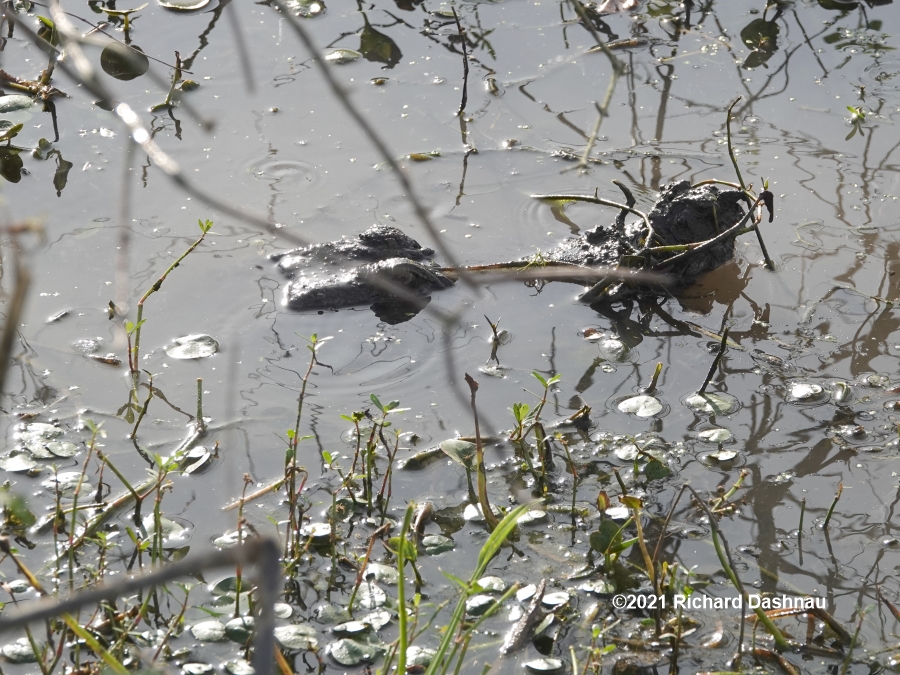
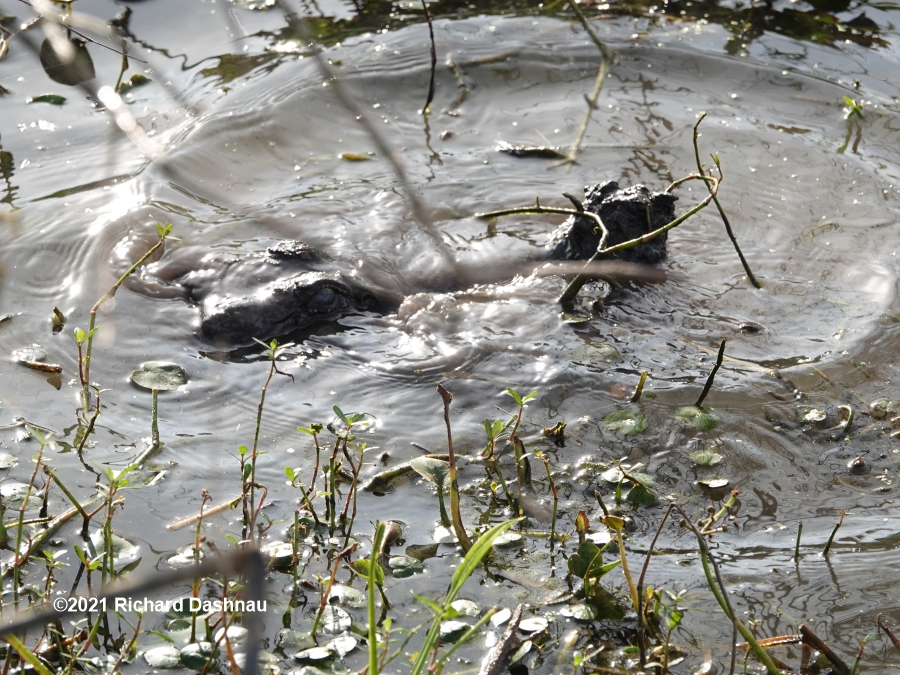
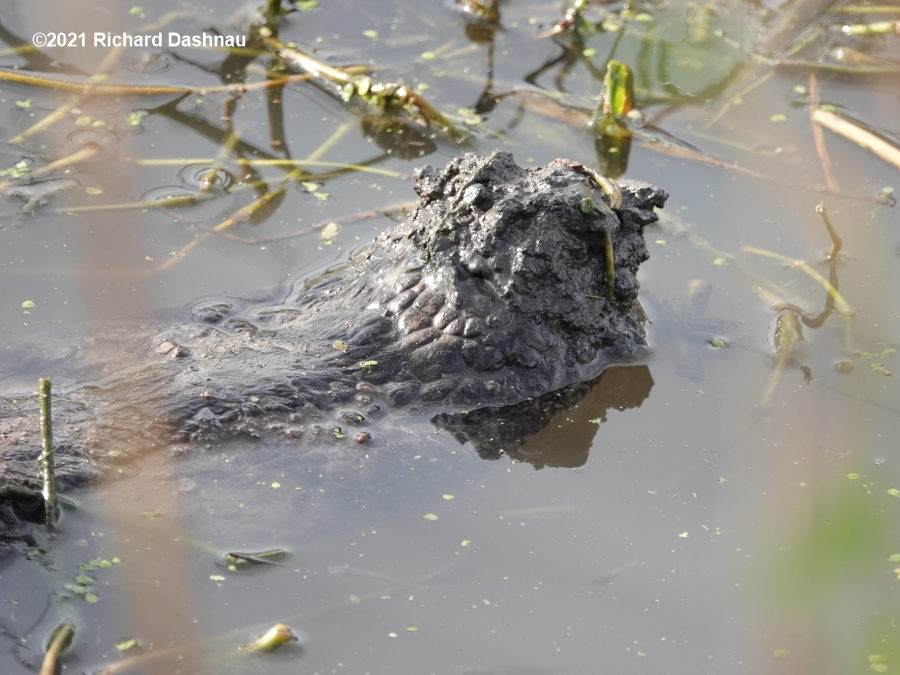
She
waited
near the pod for a while. Then, at about 11:30, she moved
through her trail, and moved out into the lake. She swam out
towards
the islands.
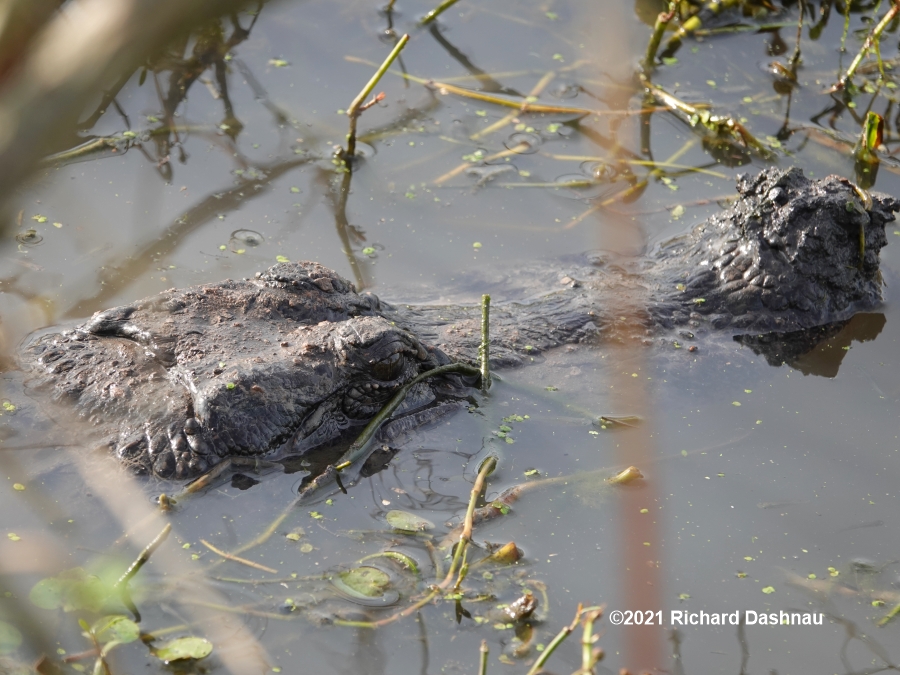
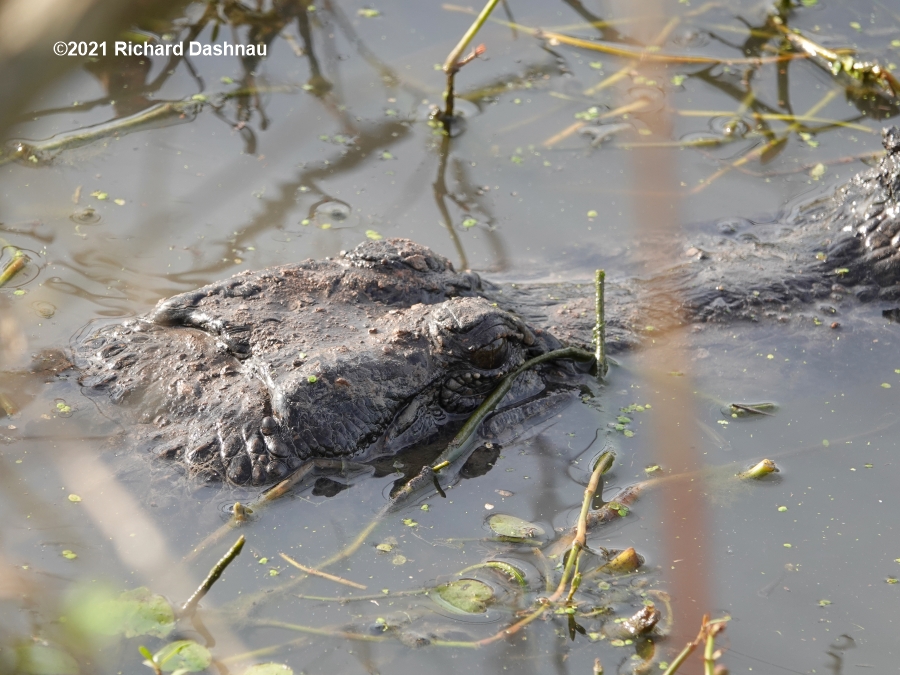
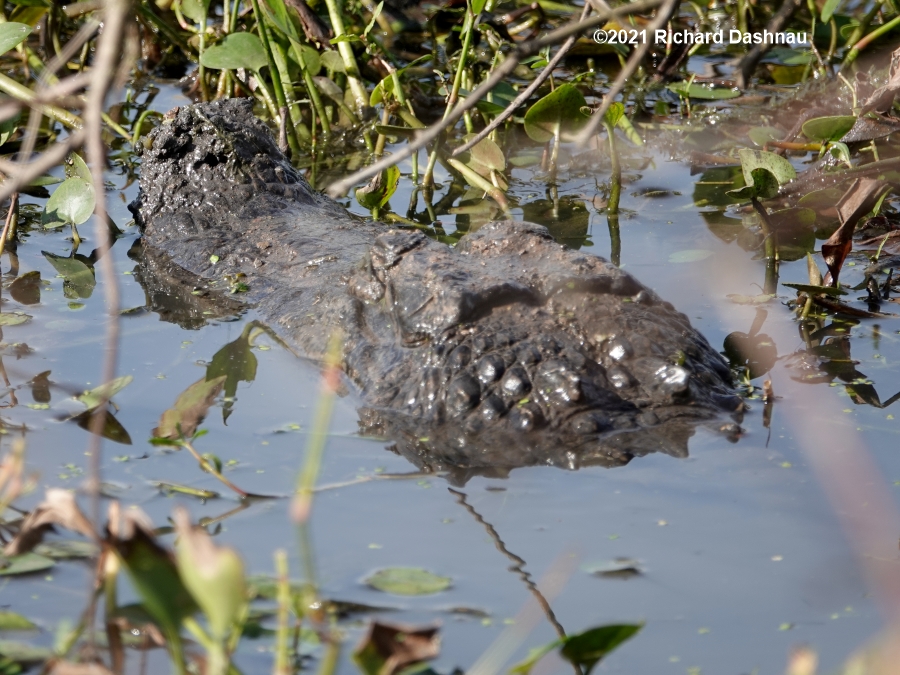
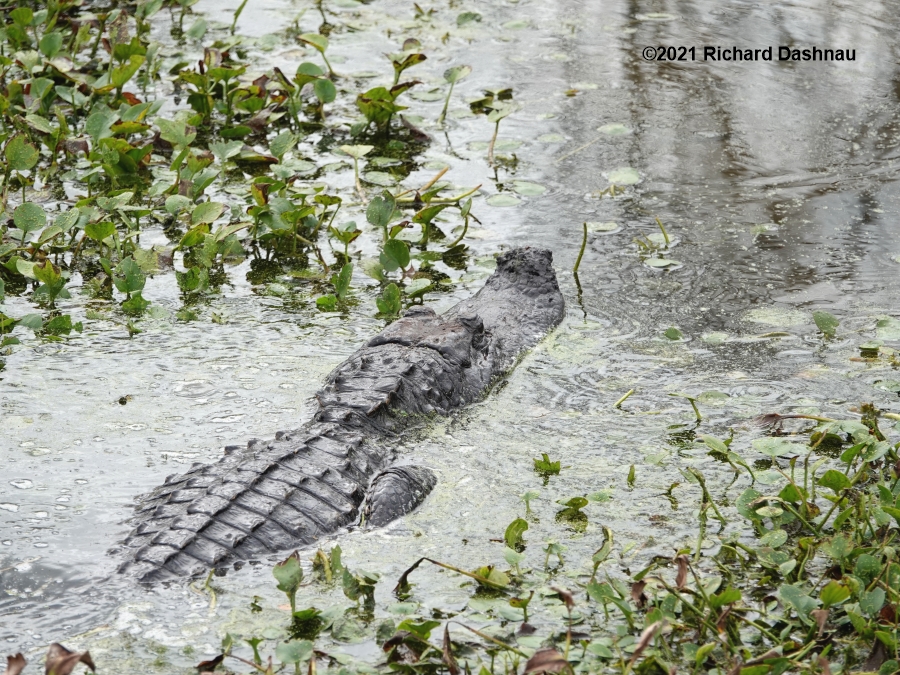
The
pod
remained where it was. In a situation like this, a
predator
(like a Great Blue Heron or other wading bird; or something
like an
Otter, or Raccoon) would have found a
jackpot meal. But
those predators would have to get lucky to find the babies.
Also,
they'd scatter if threatened, but a few might get caught. That
wasn't
likely today with me
standing there...babysitting. At 1:24
(almost 2 hours later!), I noticed an alligator swimming
around the
East end of the islands. I thought it might be mom returning,
but it
could
have been another. But, I was right.
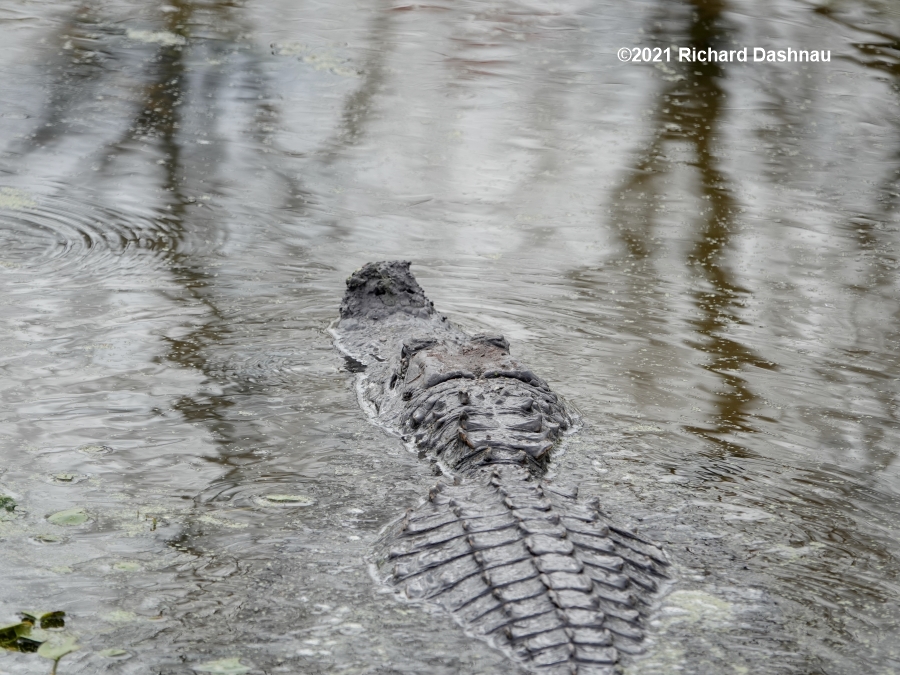
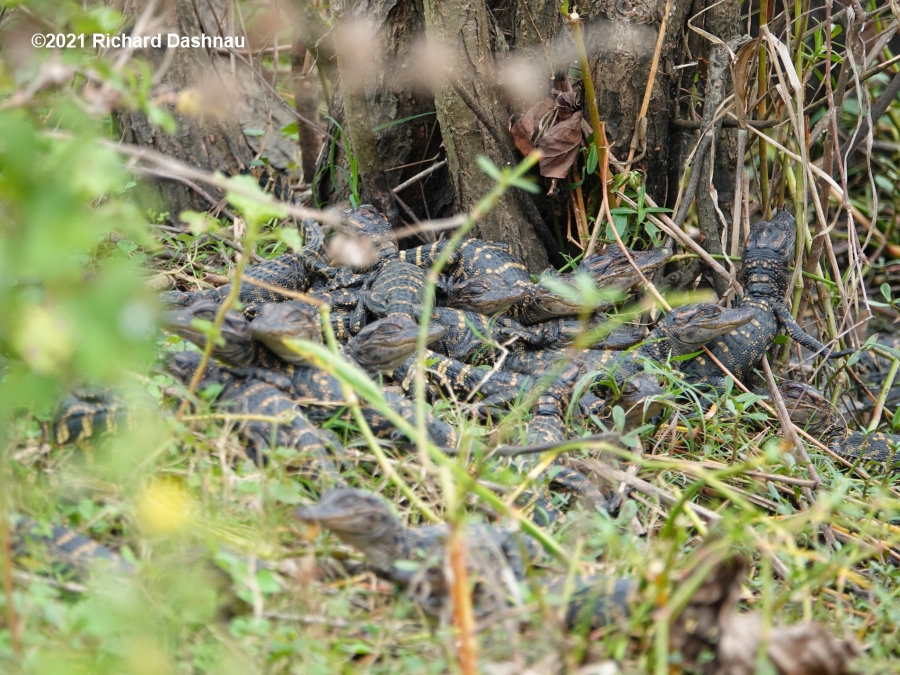
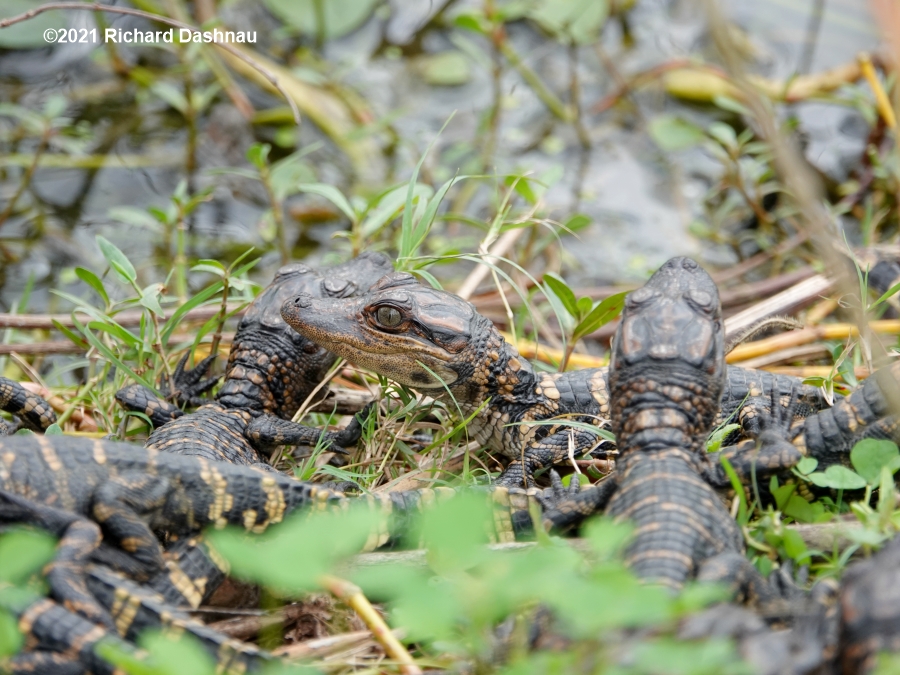
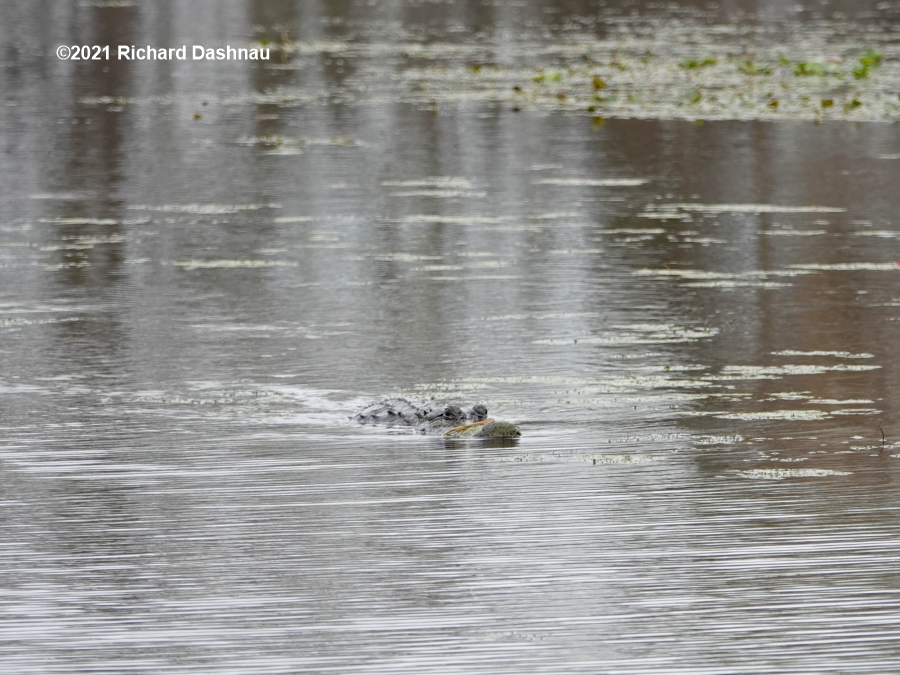
Mom
swam
to the entrance of the trail to her nest.(I wonder how she
navigates. Her face and eyes are at the water's surface. Yet
she always
makes her way to the entrance
of the trail.) As she paused at her trail, a group of
Common
Gallinules and American Coots came up to watch her!
A few of them walked right up to her snout. The gator
submerged,
then
she turned and swam back out, this time heading West as the
birds
watched her go (at 1:35). I captured some of this on
video,
which
I may post later.
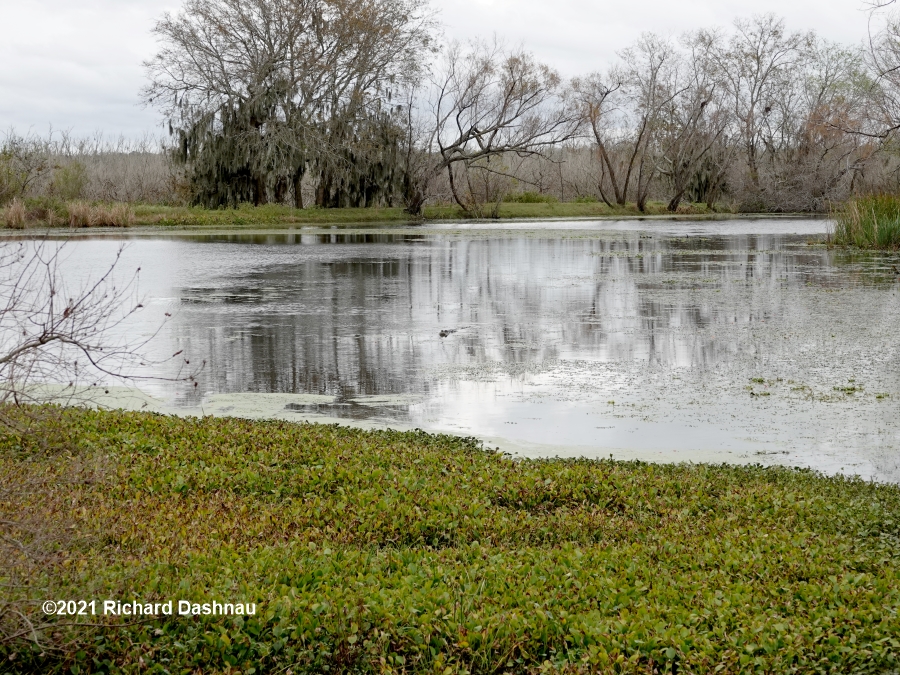
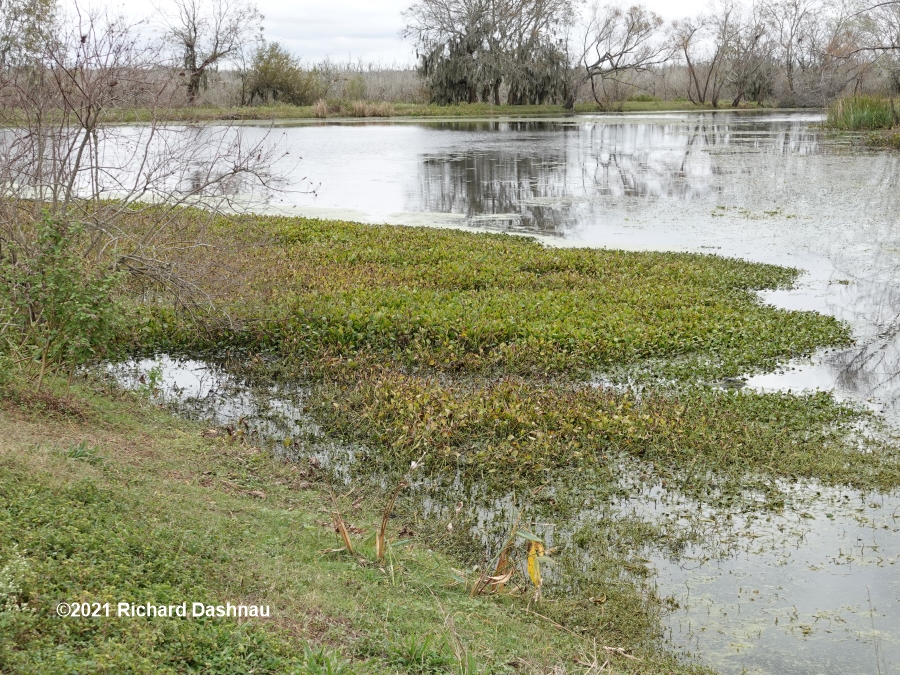
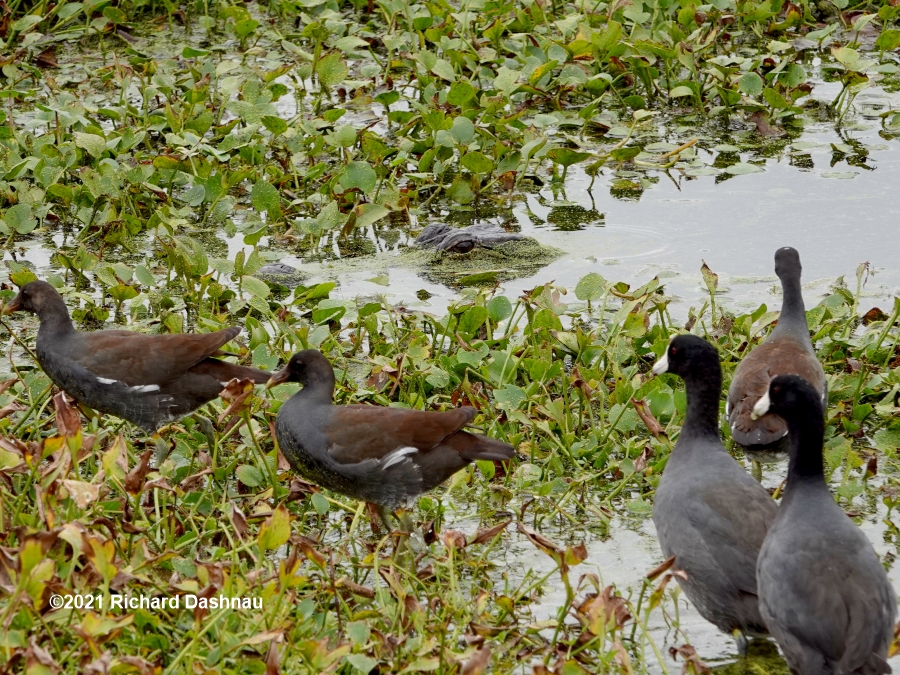
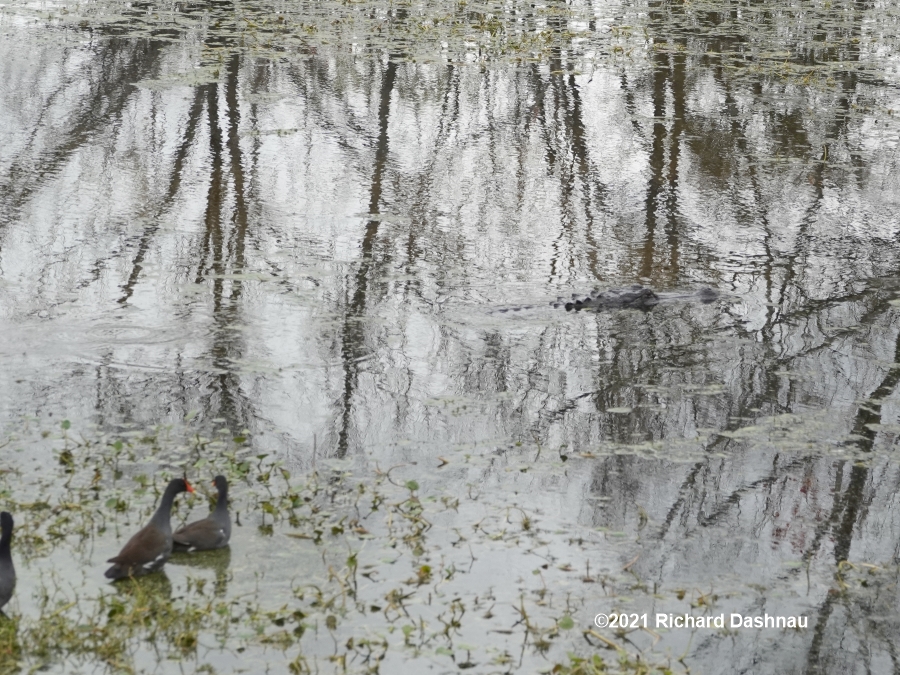
At
2:15
(about 45 minutes later) Mom returned. This time, she moved
down
her trail and to the den and the pod. She remained near
the
pod,
and was partially resting on some
of the plants at 2:44 when I left.
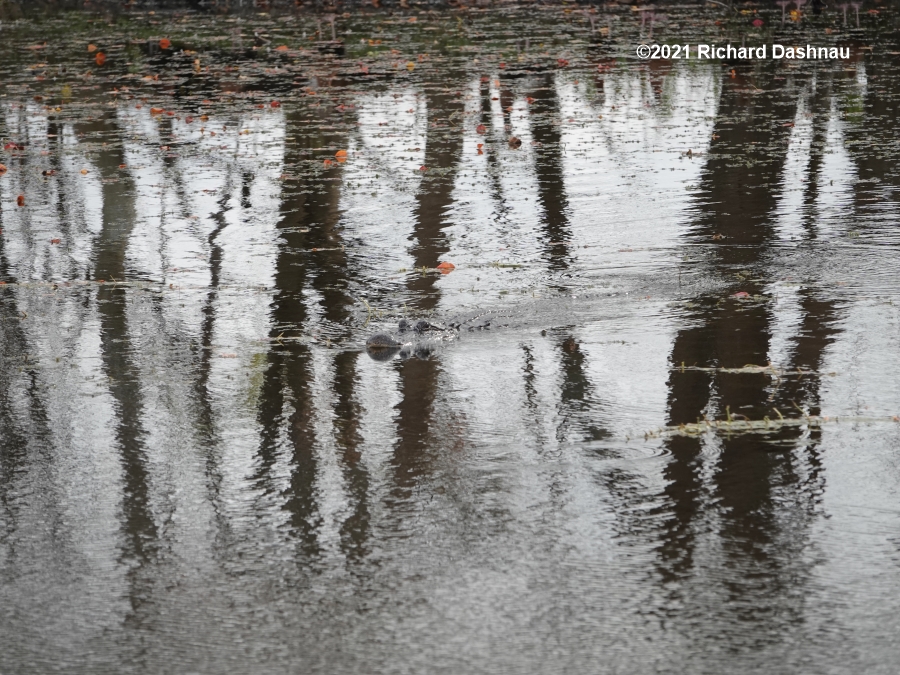
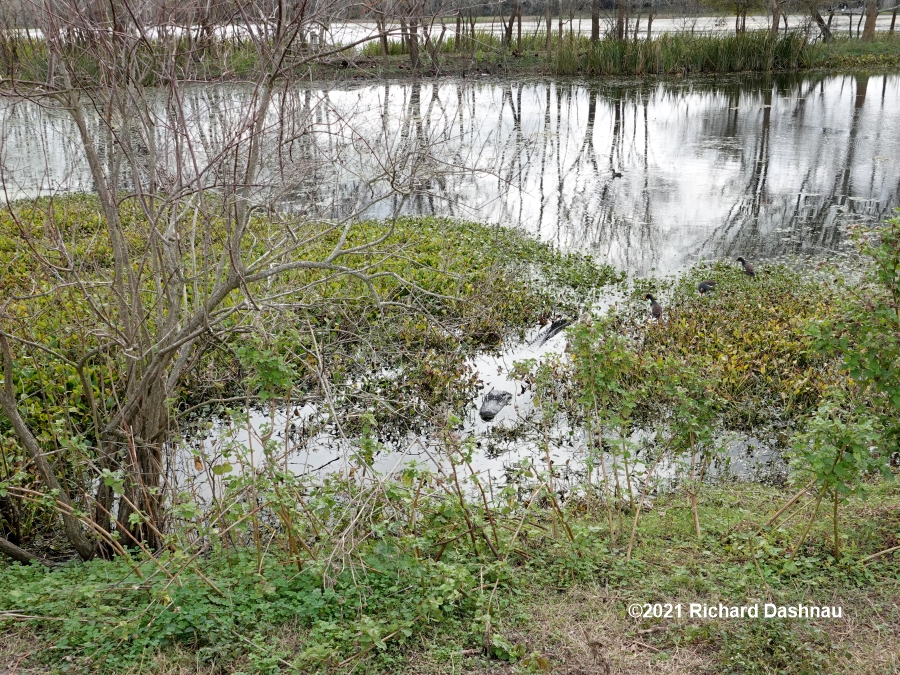
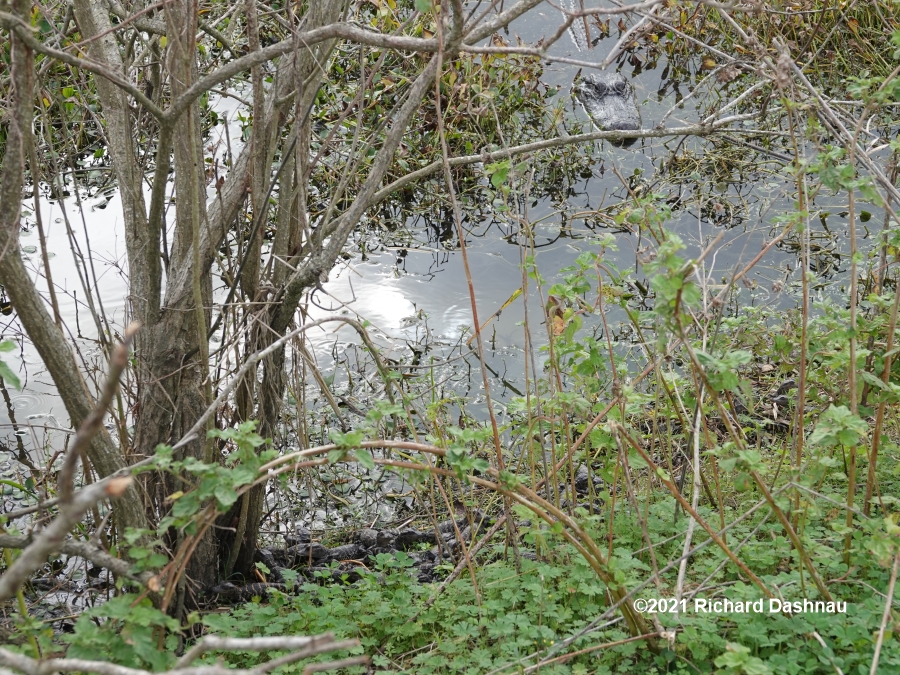
01/02/2022 A
cold front came through our area on the evening on January
1st, 2022.
The forecast said that temperatures would be somewhere
in the
30's F (or about 40° colder
than the day before). I went
out to BBSP again on 01/02/2022
mostly for two
reasons. First,
I'd
seen Bald Eagles out there (or the
same one more than once) the day before. One of my
"working theories" is that our favorite winter
predators
(Eagles and Otters) would be more active on cold
mornings because they're require more food for fuel.
Second,
I wondered what the pod of baby alligators would do in the
cold, and I
also wondered how much the air temperature would differ from
the
temperature of the water. So, I
went out. In spite of the cold, and wind, it turned out to
be an
interesting day. Eagles were active,as described on their
page. After
this, I continued to
check the mother
alligator and pod.
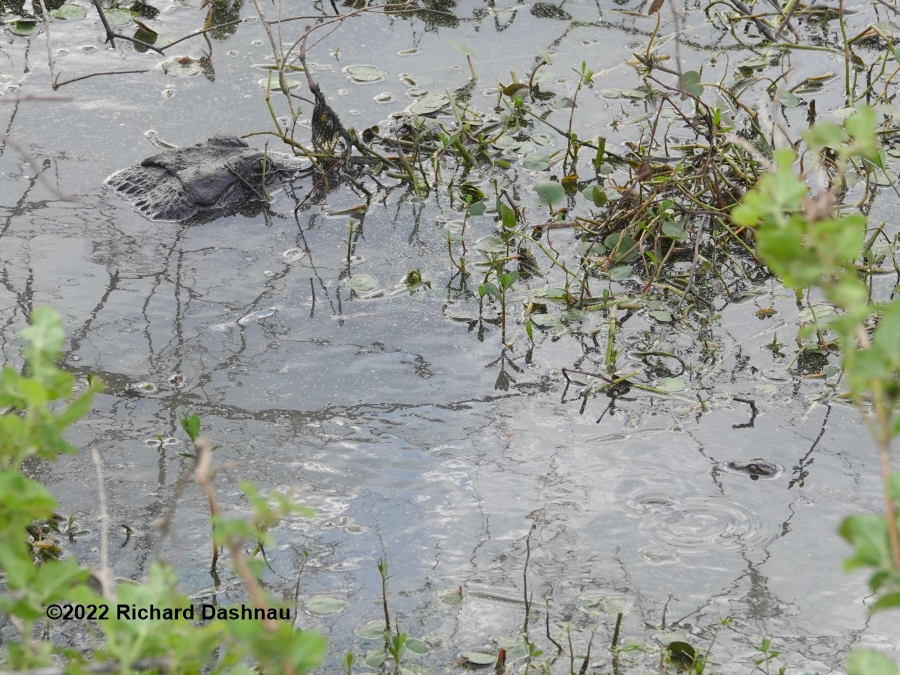
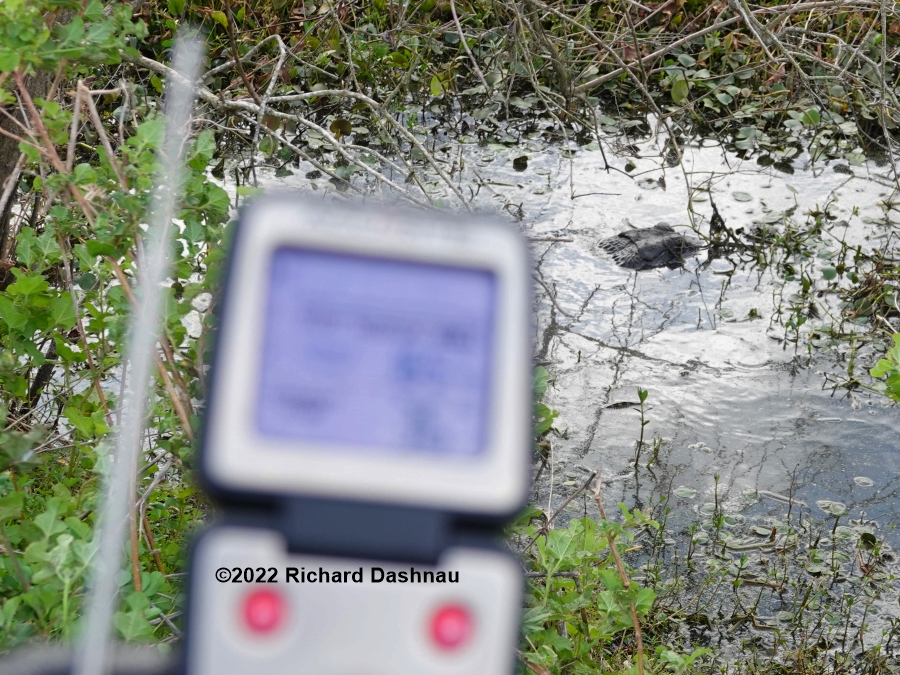
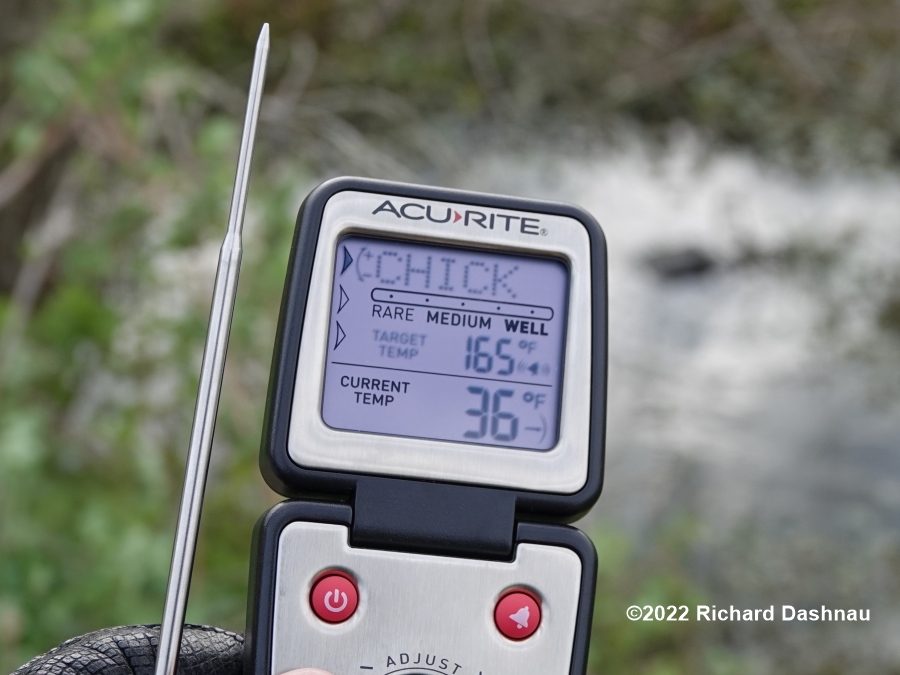
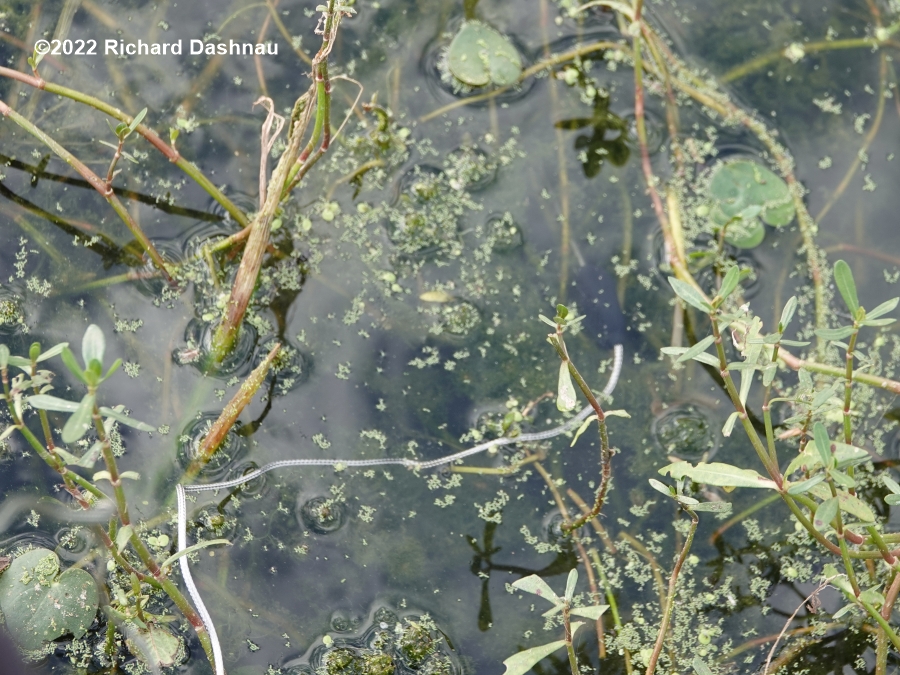
When
I
got to the mom alligator's bush (The plant is actually called
"Buttonbush" (Cephalantus occidentalis)--thanks Katherine),
mom was at
the surface, and her head was exposed.
Also, I could see one baby
alligator in the water (look to the right in the picture)
The
temperature above the trail (according to my cooking
thermometer)
was 36°F
(9am).
Next,
I
walked about 10 yards West and submerged the
probe (unfortunately it's only on a 3 foot lead) and took
another
reading. The tip of the probe was about 4 inches deep.
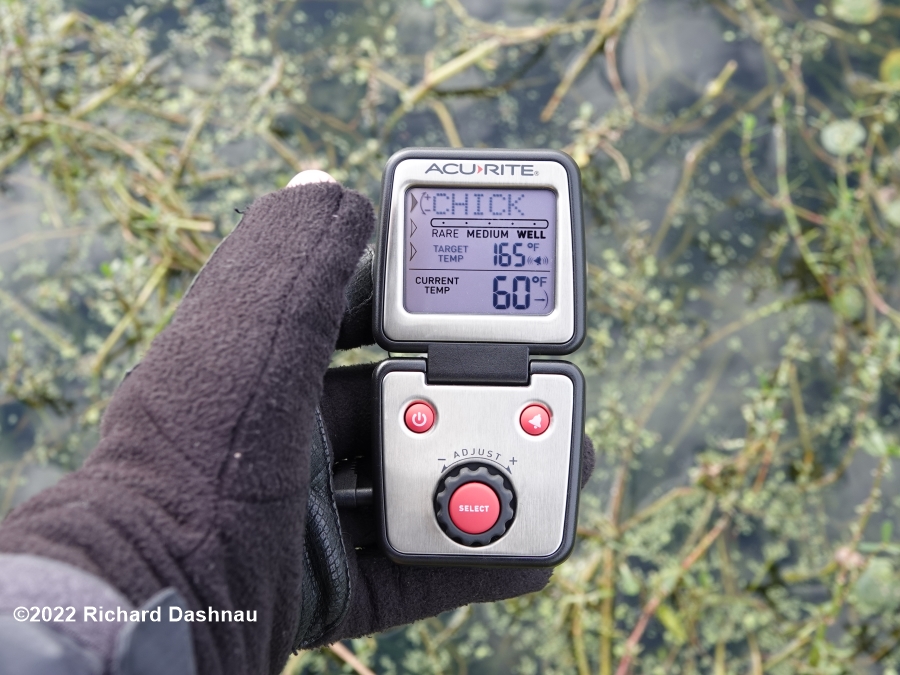
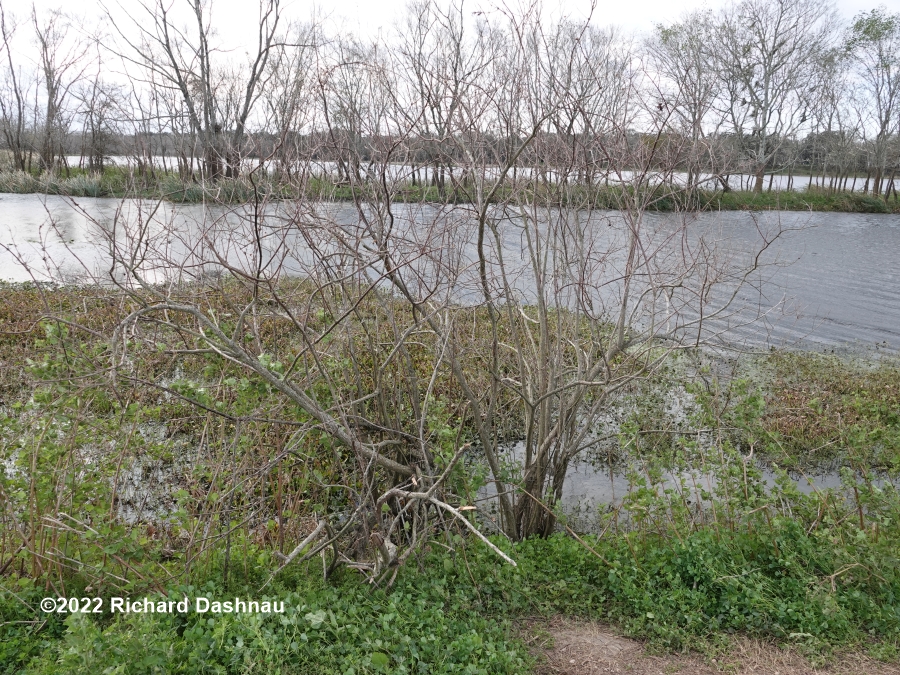
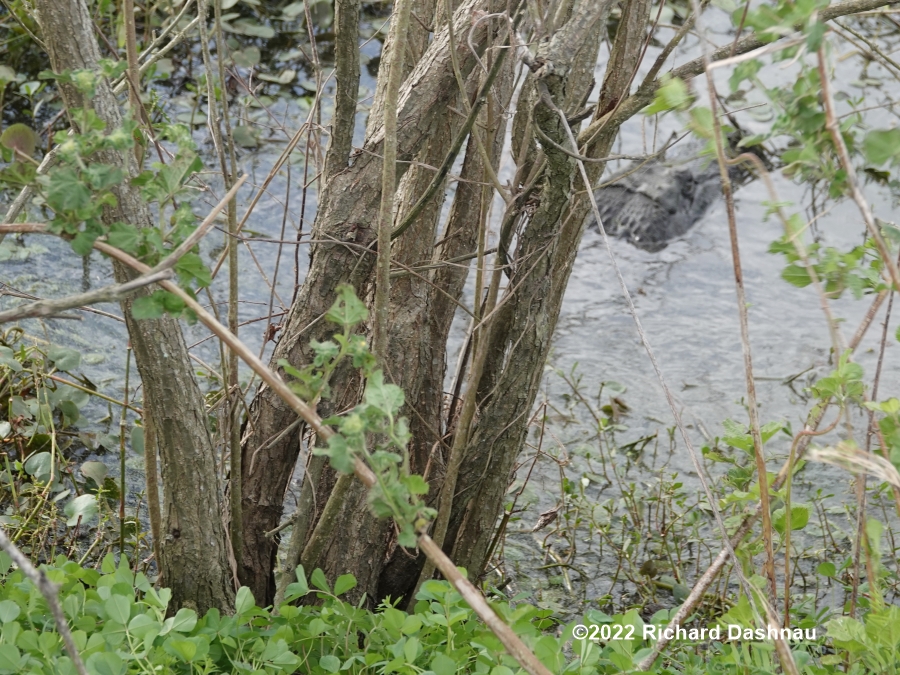
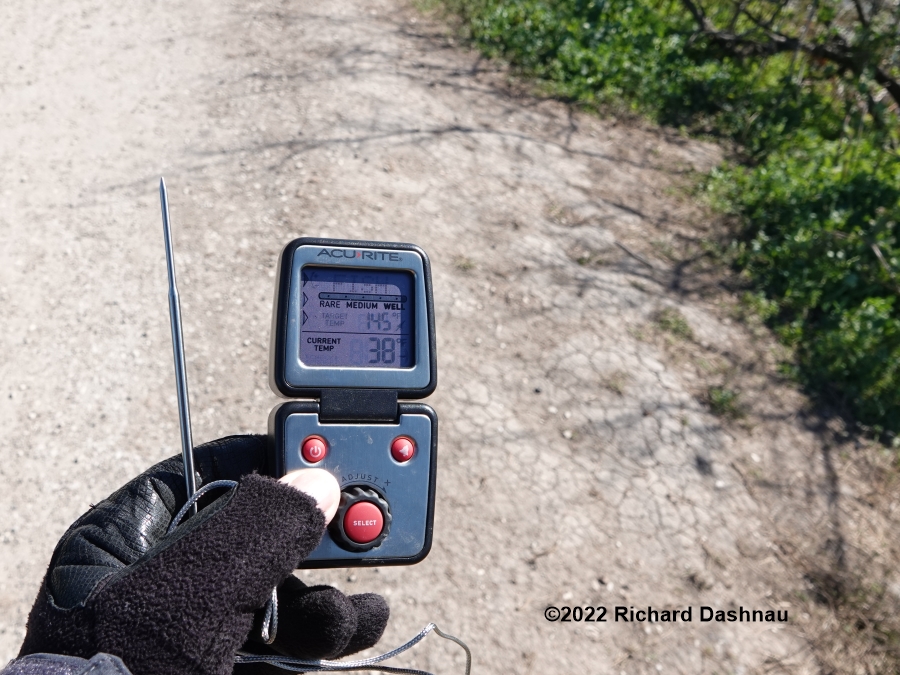
The
temperature in the water
was 60°F.
So, the mother and the baby were actually in a warmer
place
than
I was! At least then.
I had assumed this would be the case, and
had been
suggesting that possibility while interpreting for
visitors. It
was nice to see it verified in some way. I continued to Elm
Lake. I
went all the way around Elm Lake, then headed back
along the Spillway
Trail towards 40 Acre Lake. I was hoping to see an
otter--but
I
never saw any that morning. I got back to the pod about 11:35,
and the
sun had been out for a while.
I did more temperature measurements. Air temperature on the
trail was 38°F--just
2
degrees more than before.
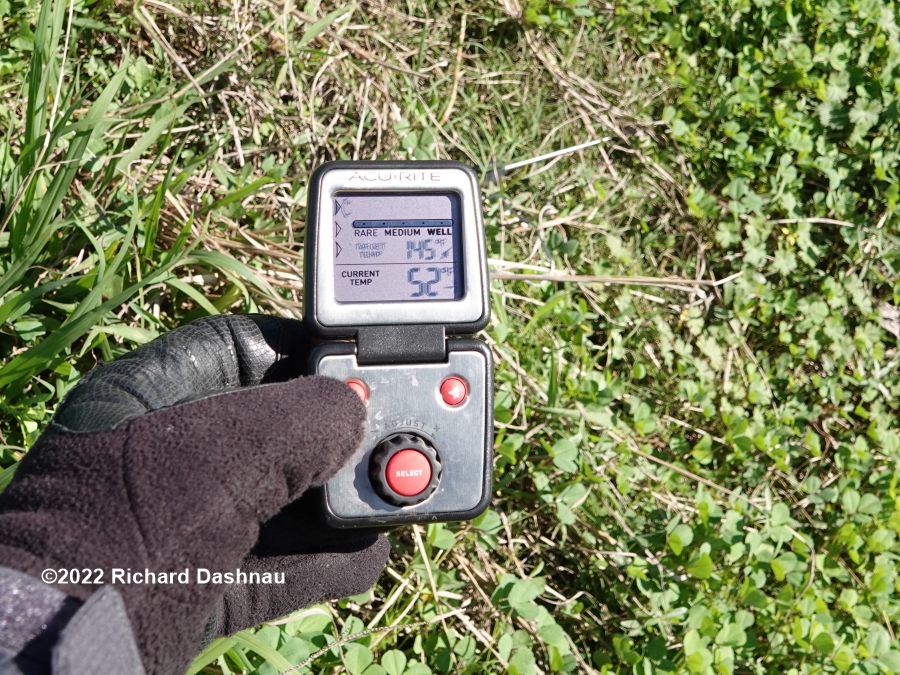
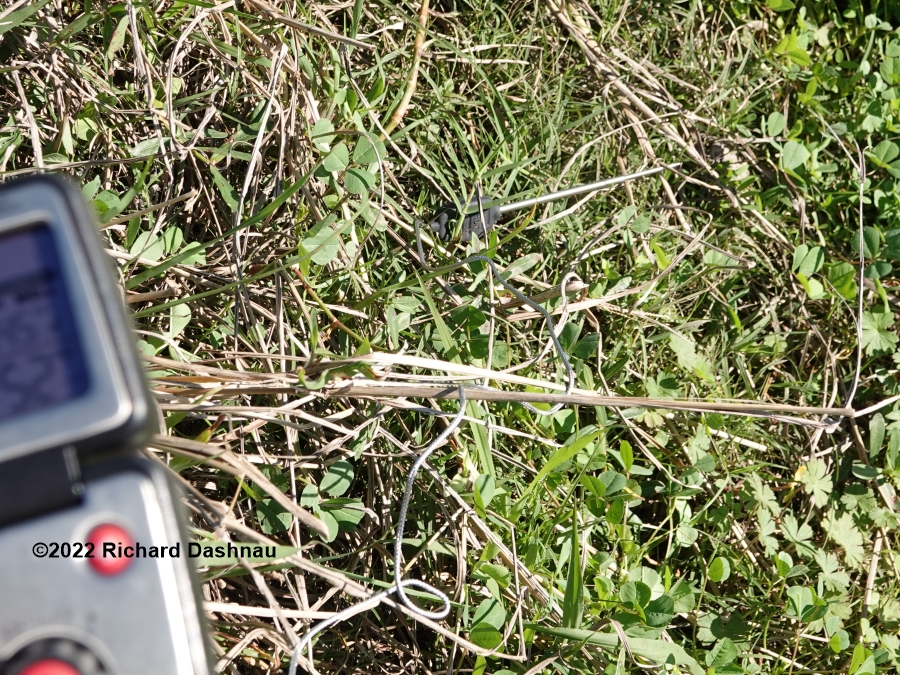
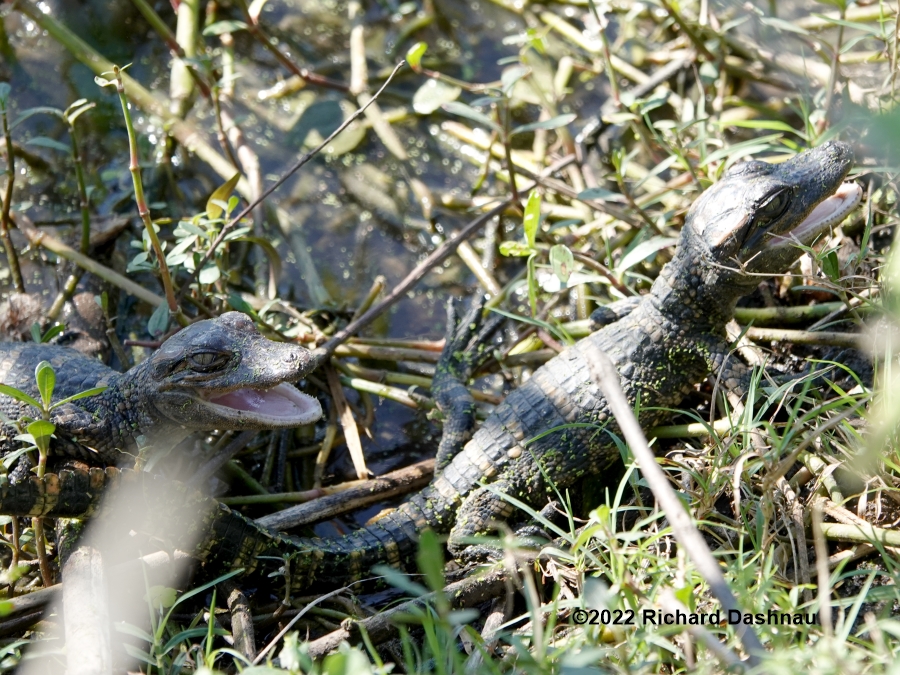
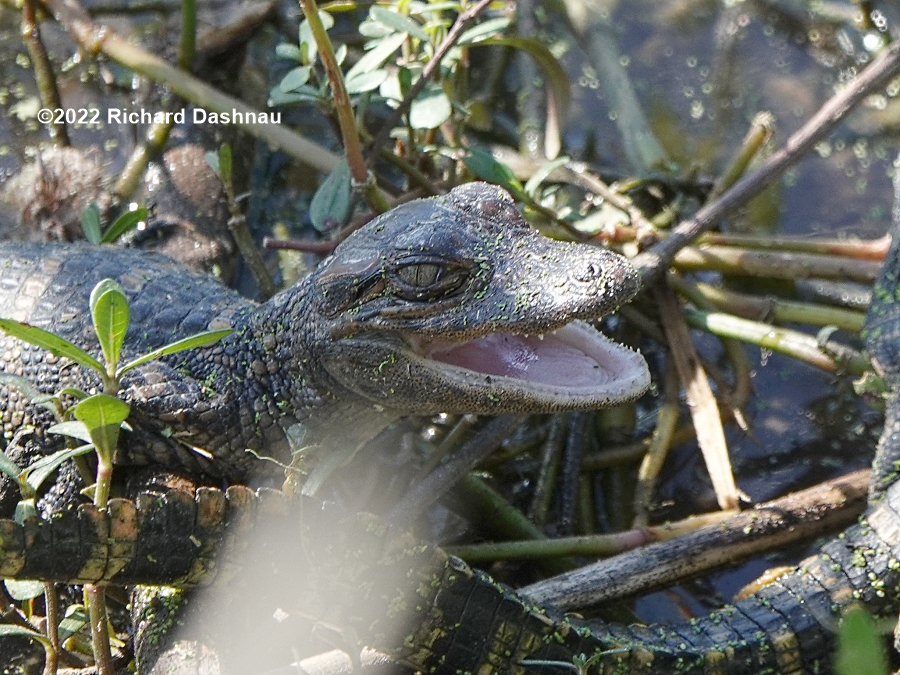
I
put the probe down on the
grass, and discovered that it was about 52°F.
That was
interesting, but I
was still pretty cold.. But, it did explain why some of the
baby
alligators were
resting out of the water.
Not
only that, but they had their mouths open--which I thought
were
"thermal gapes". According to sources I've read (and my
experience)
alligators usually
do a thermal gape to try to dump excess
heat--usually allowing the head to cool off. Thermometer
showed both the bank and the water was somewhere around 60°F, so
maybe the
babies could have been overheated--but it seems unlikely.
01/16/2022.
Another cold day at Brazos Bend State Park. Please note that there was
movement around me most of the time, so the animals that I mention were
not
the only
ones about. I walked to the observation
tower and the open waters there, hoping to encounter otters
and/or
eagles. At 8:30am I stopped by the gator mom's den, and she was
visible, but just the tip of her nose was exposed. It was about 39°F
on
the trail.
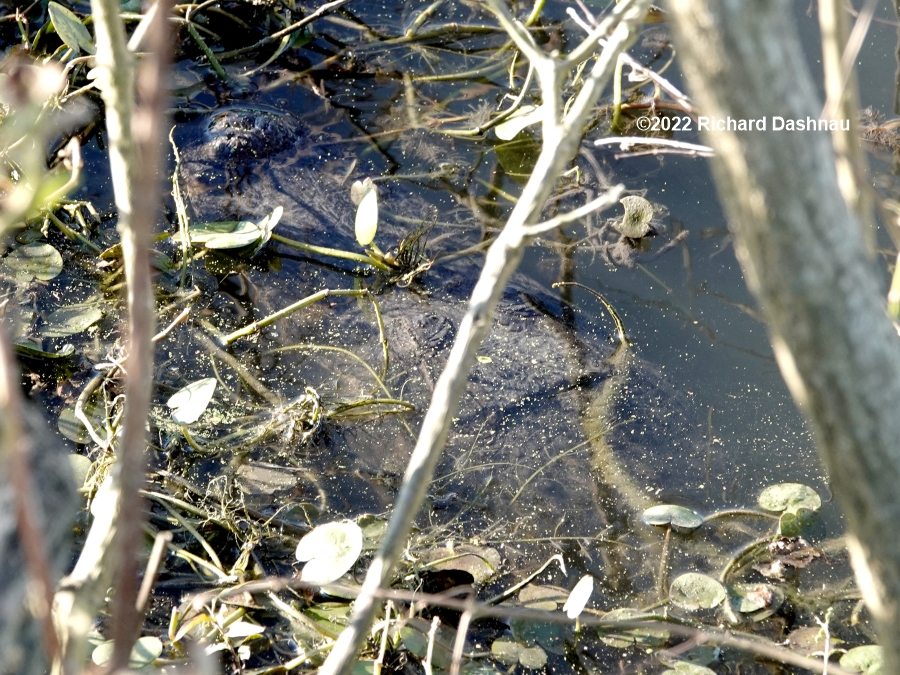
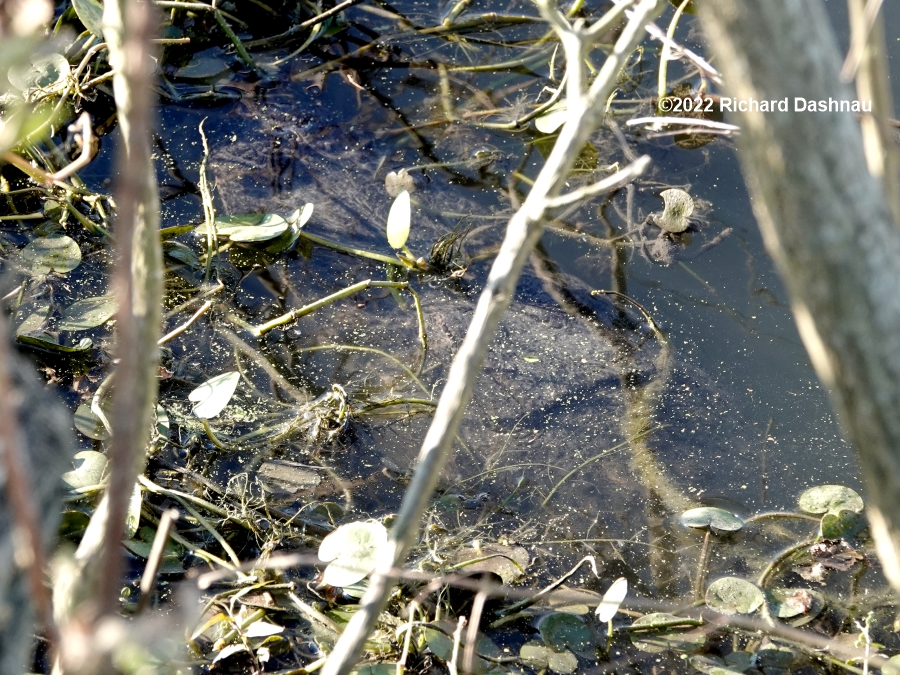
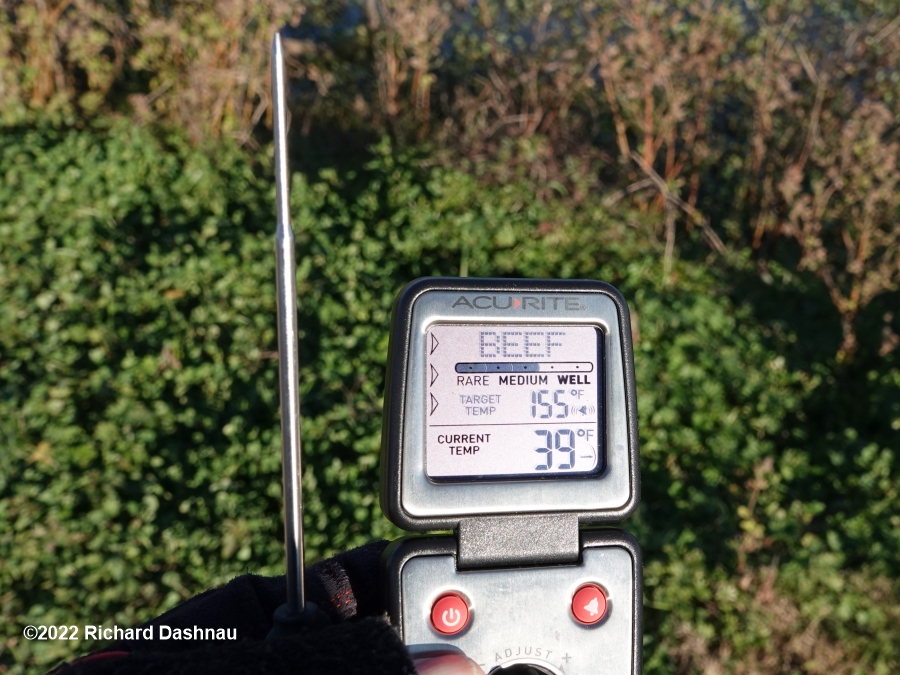
At
8:50, it was 42°F on the trail, 46°F in the water at the
surface,
and
the same about 3" deep. Mom gator was still submerged with
just
nostrils
exposed--and also mostly in her burrow (note how close her
head is
to the shore-she's at least 5 feet long, also
there's mud on
her snout).
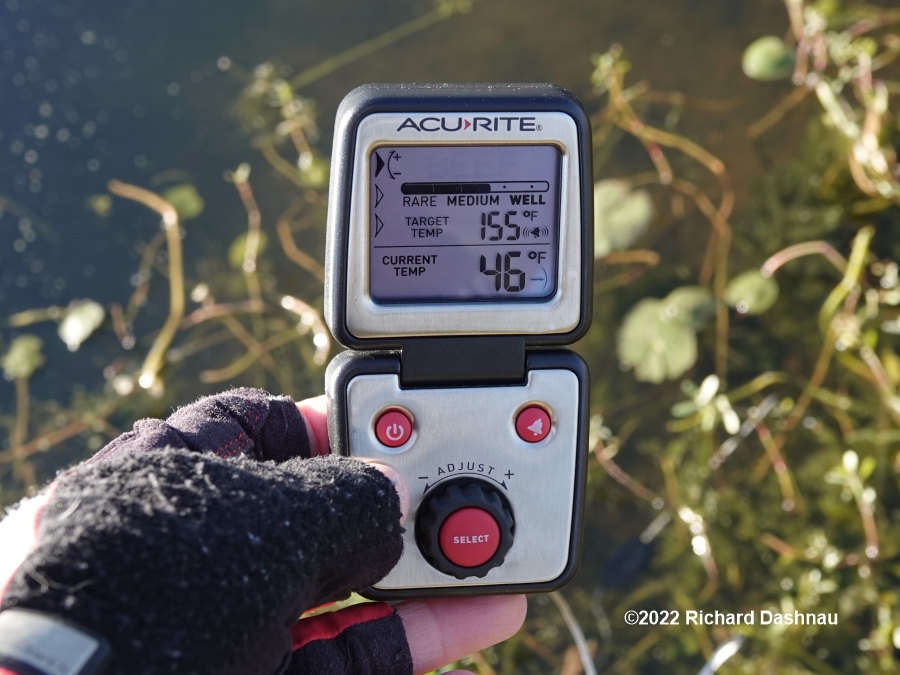
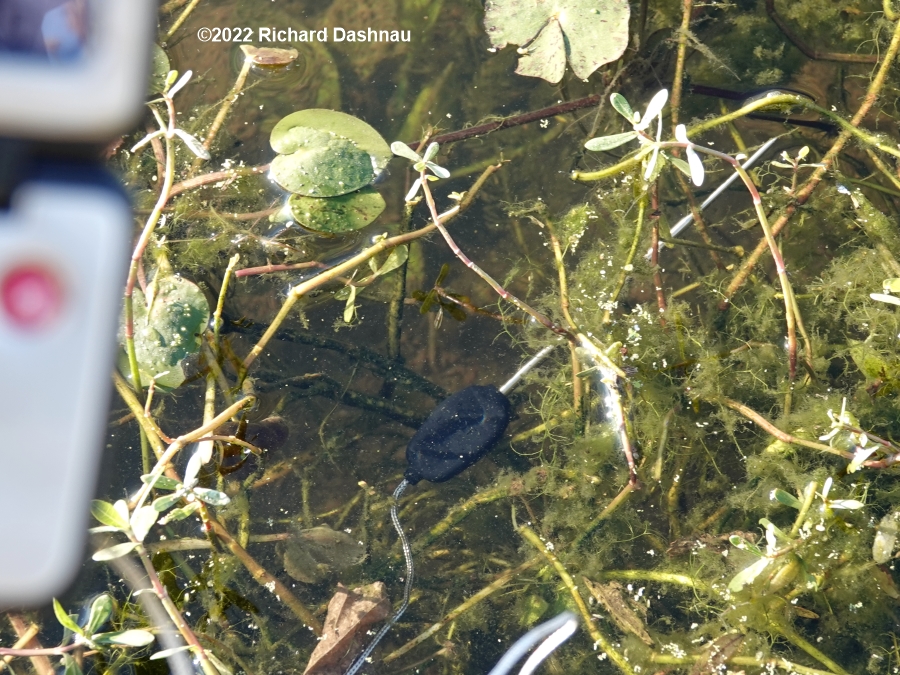
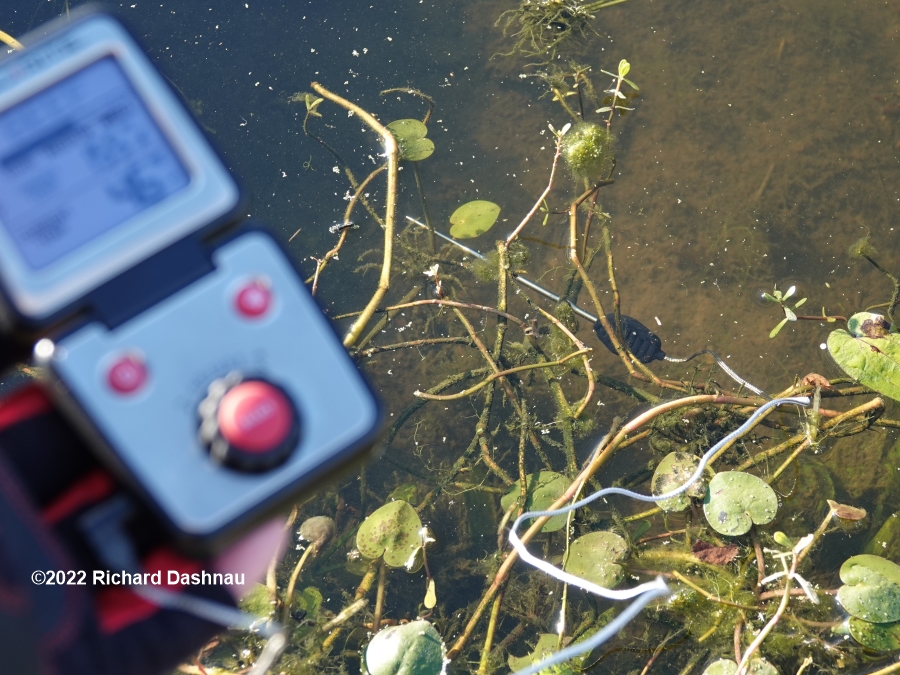
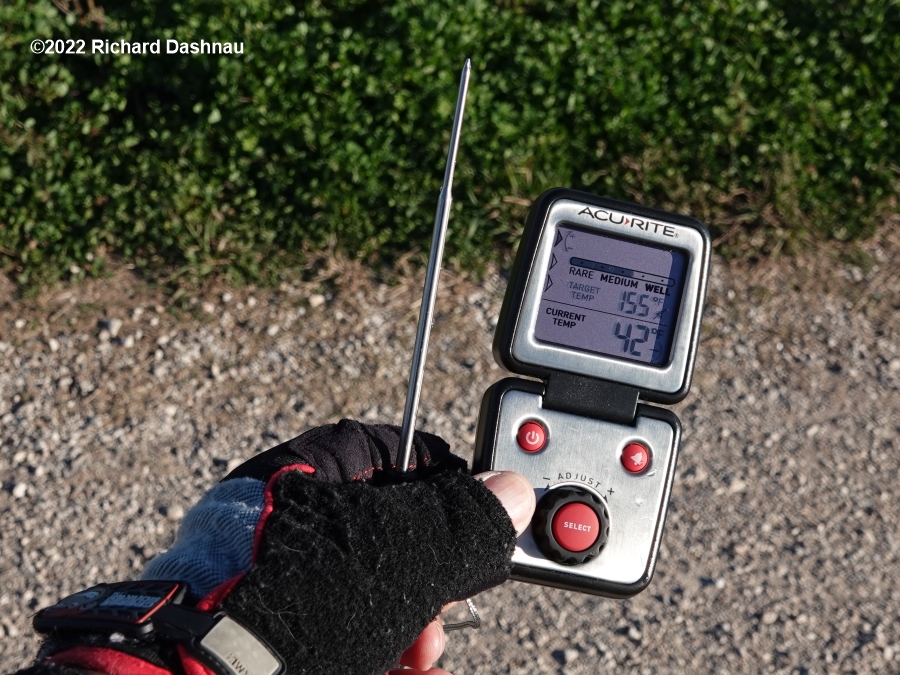
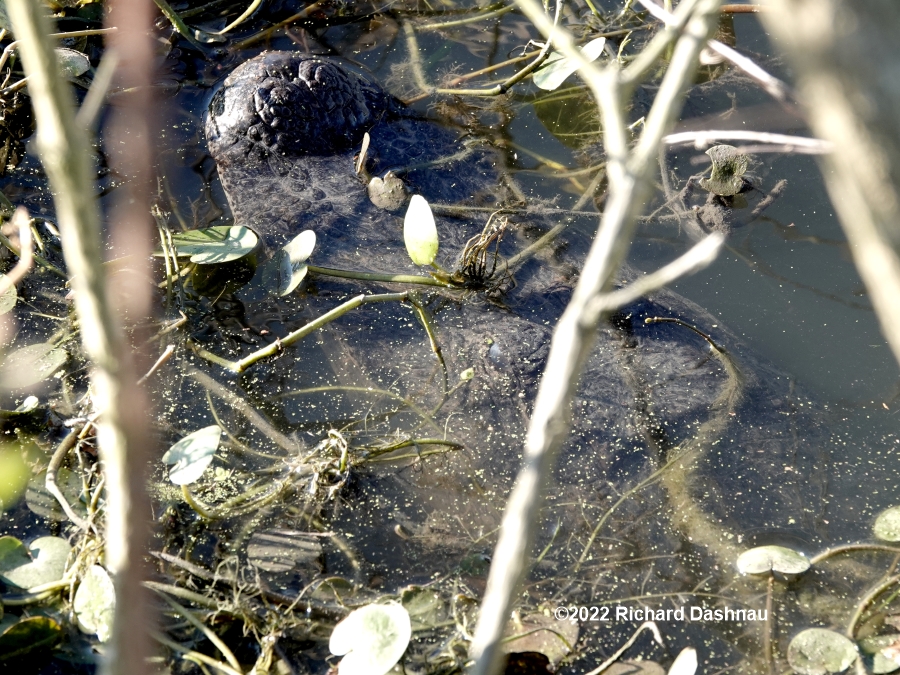
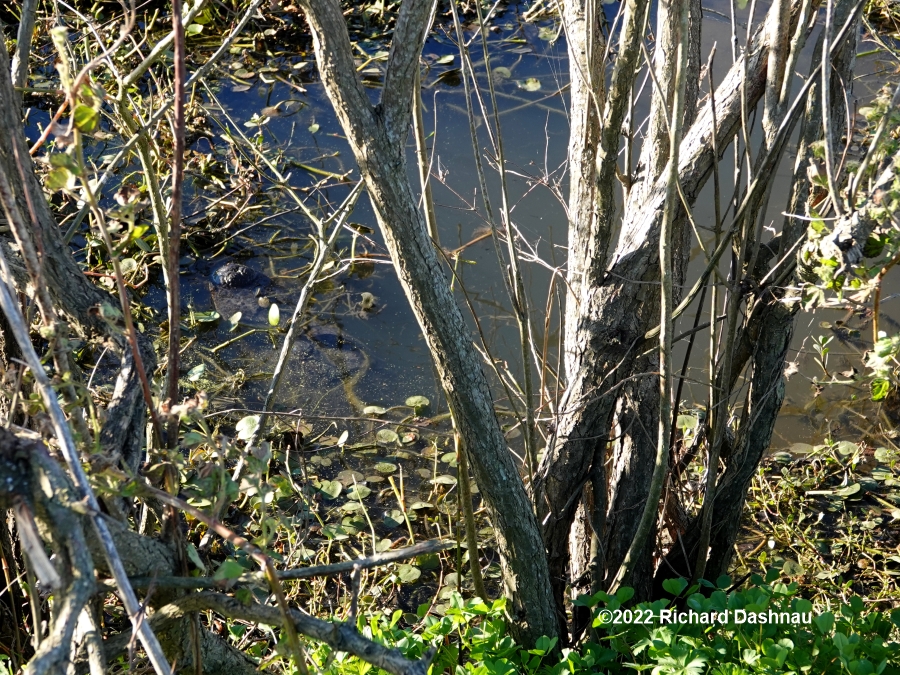
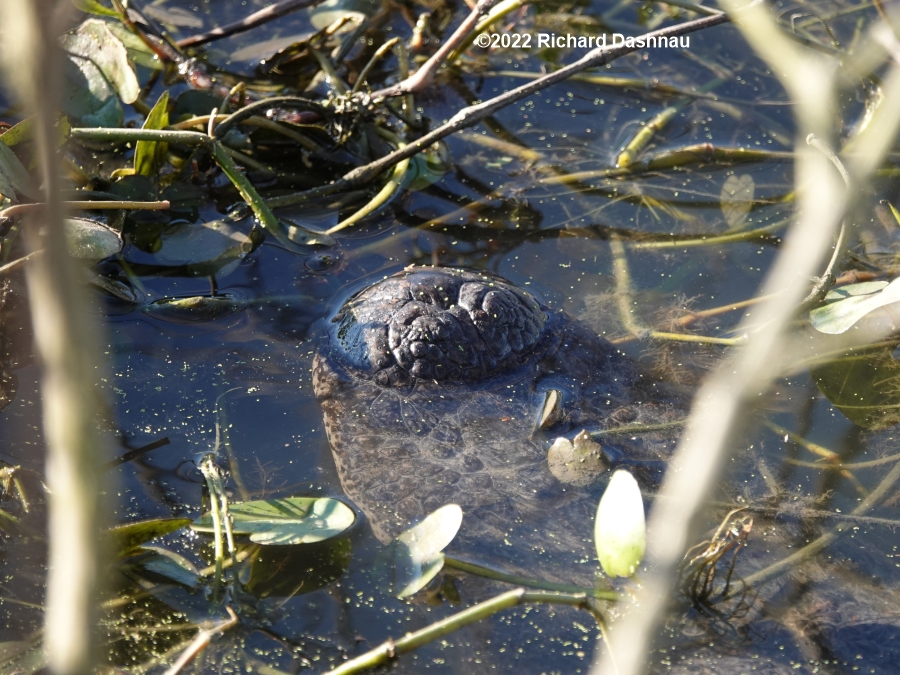
At
12:20,
gator mom was out of her burrow with her back above
water. Some babies also came out.
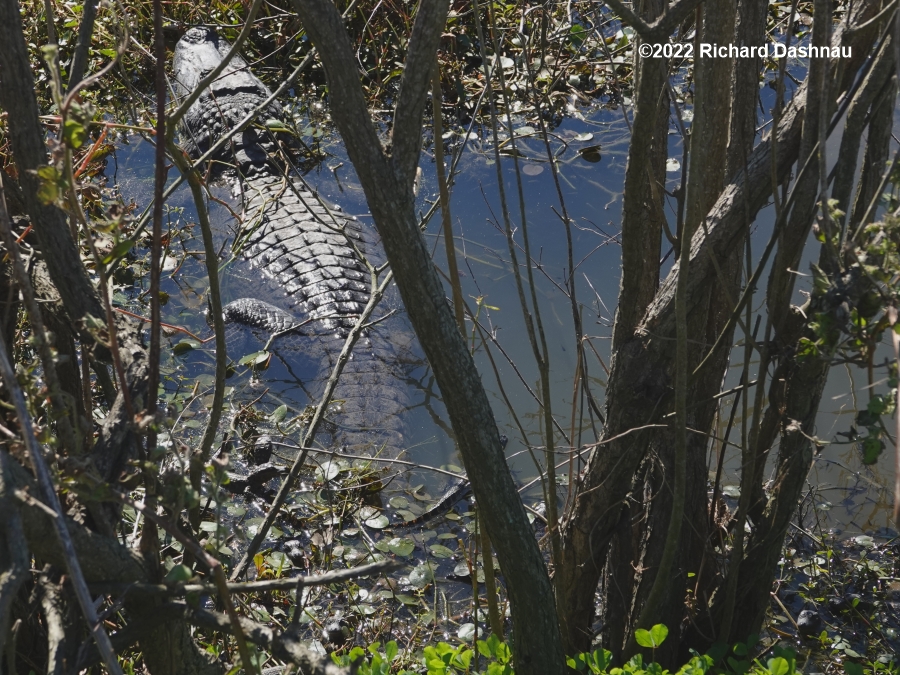
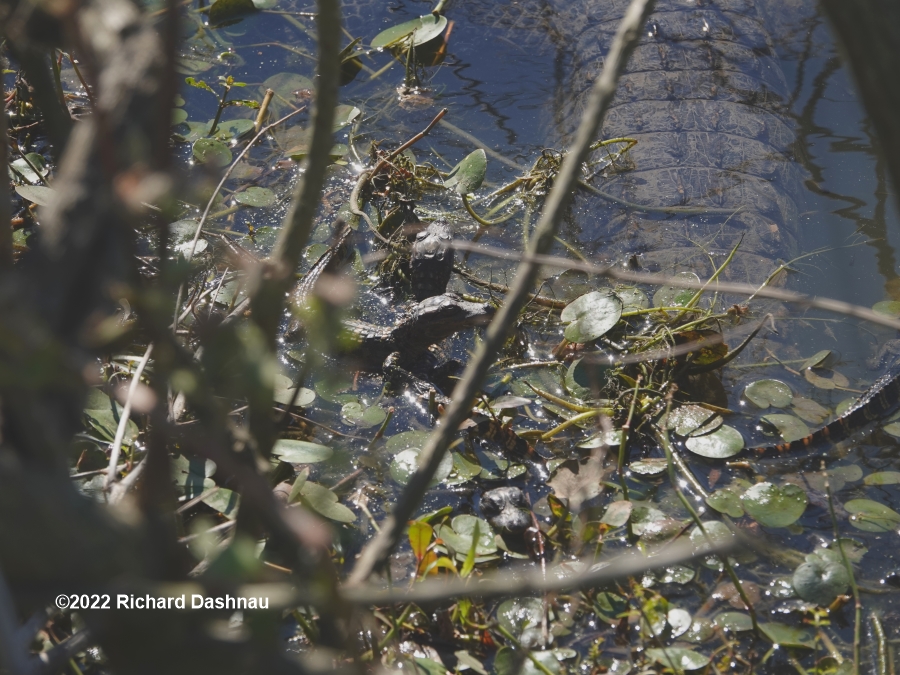
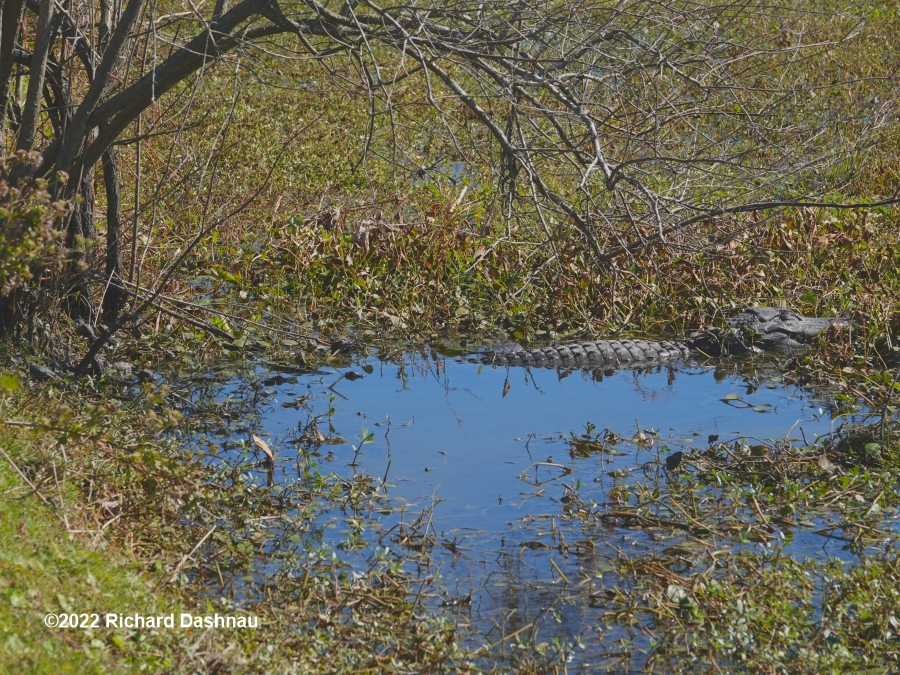
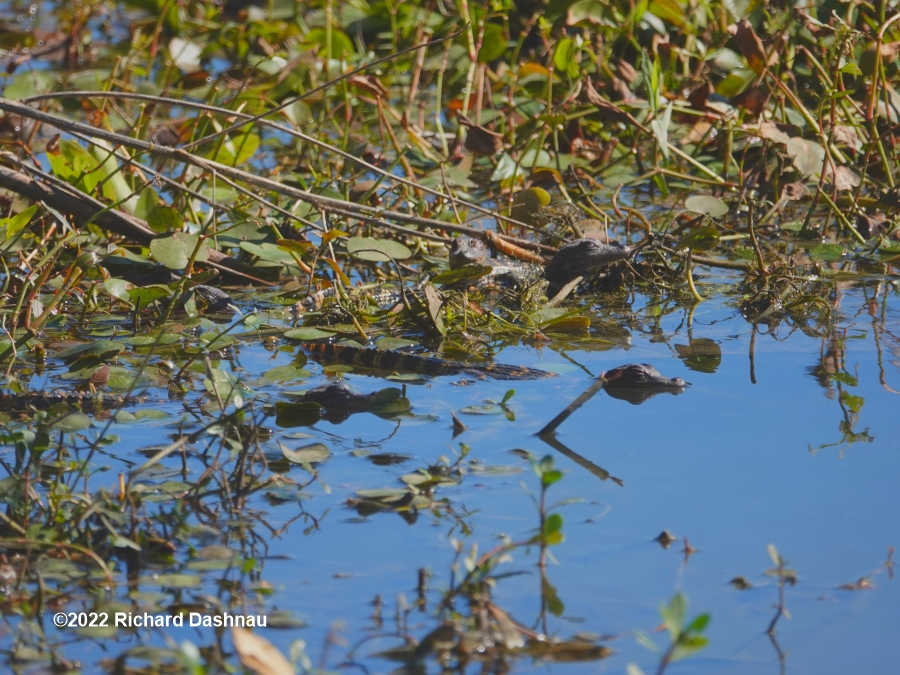
About
1:00,
mom backed into her
burrow, and began surfacing periodically. 1:40, more
babies
surfaced.
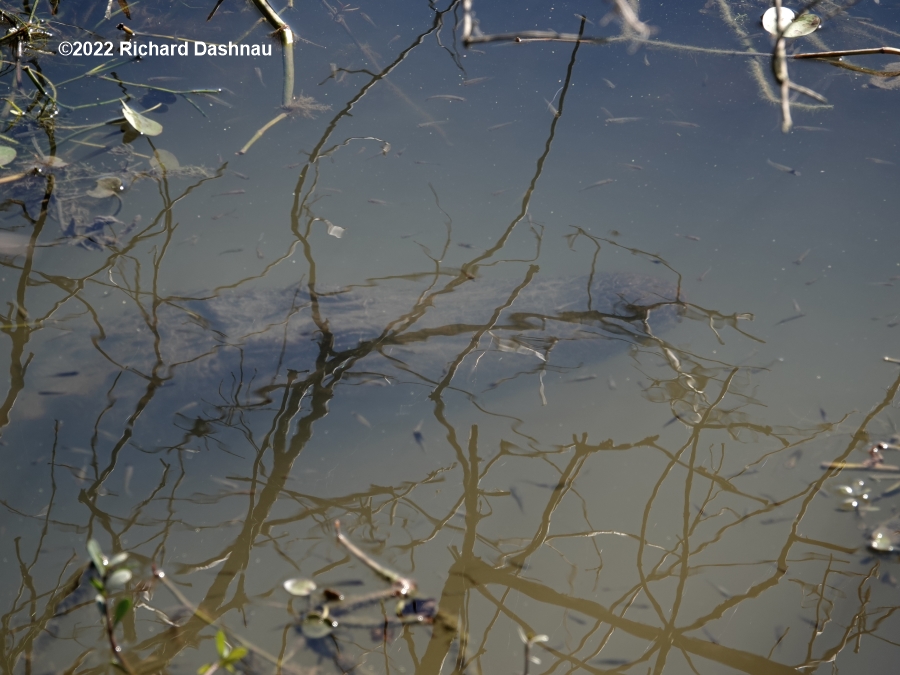
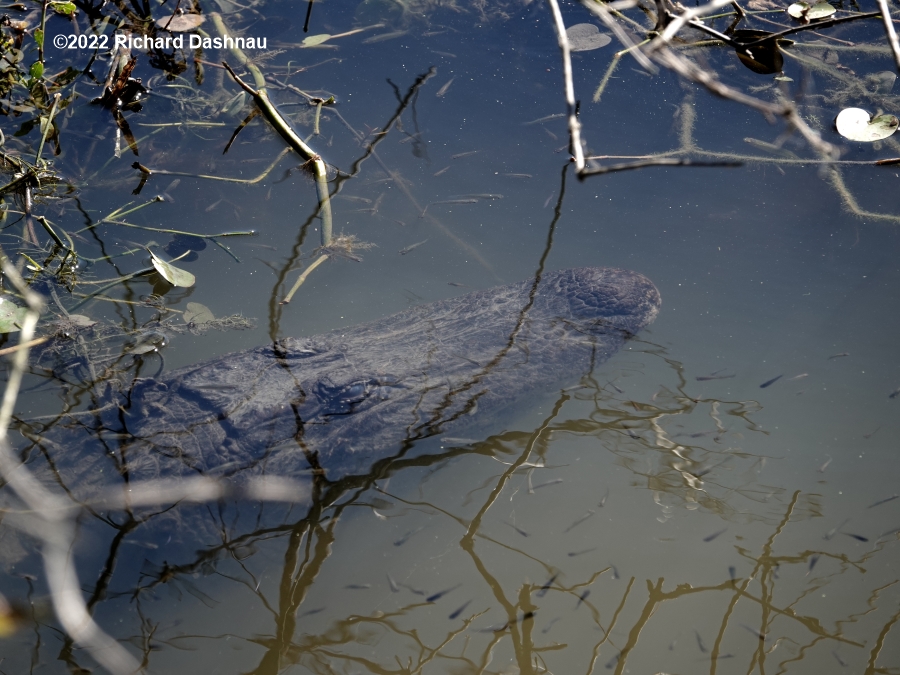
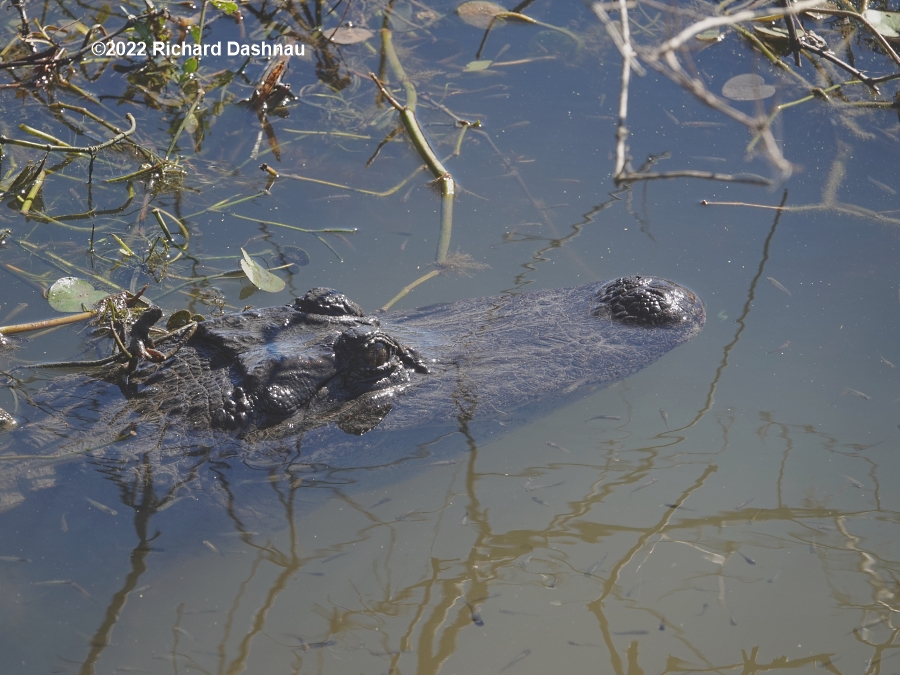
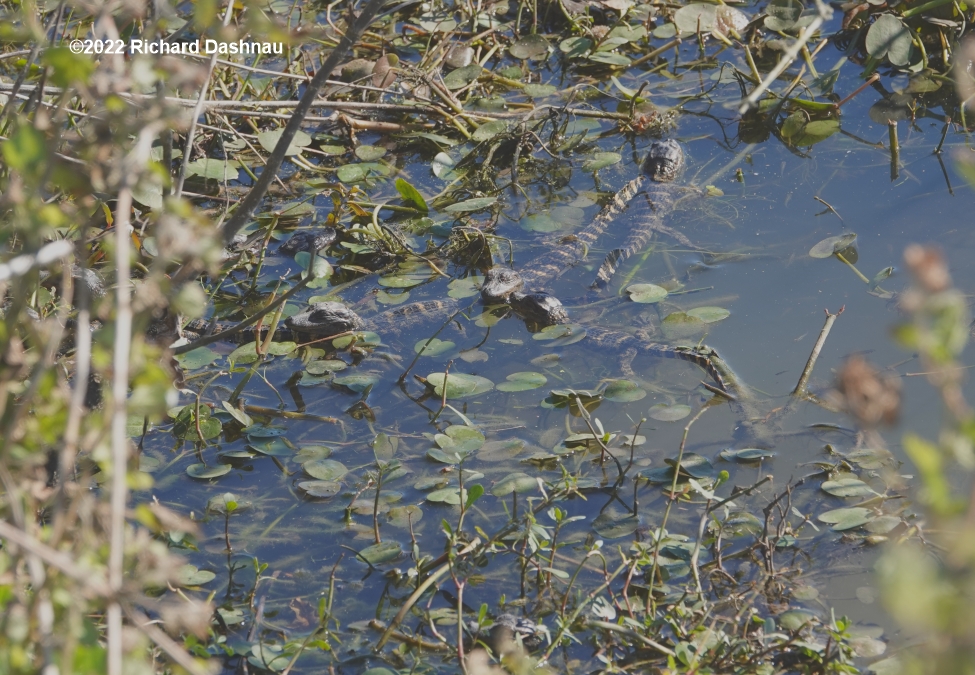
62°F
on
trail. 2:00 mom mostly submerged, head in hyacinth,
nose exposed. More babies moved on land and in
water.
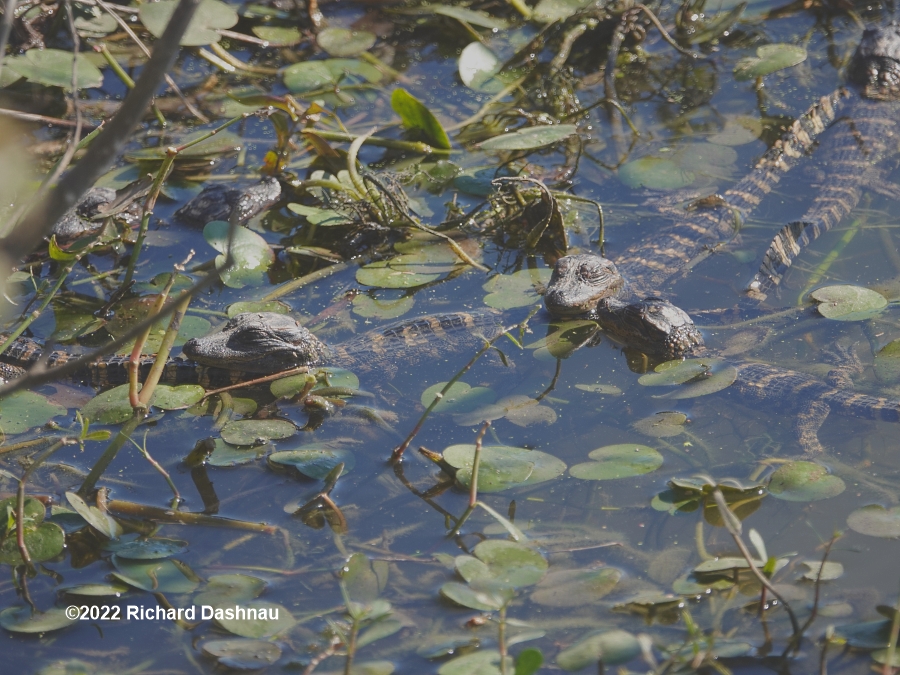
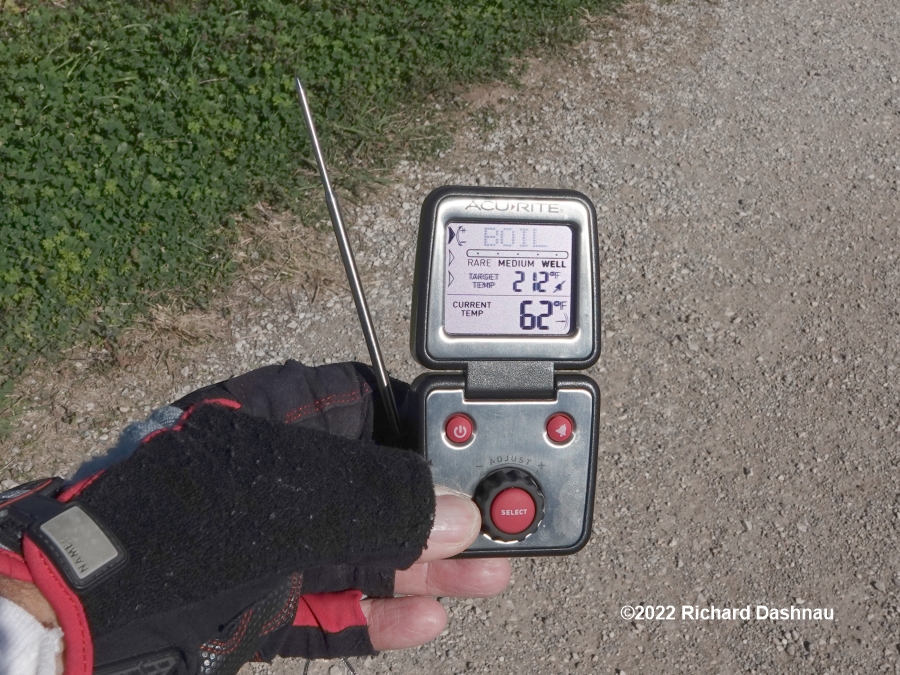
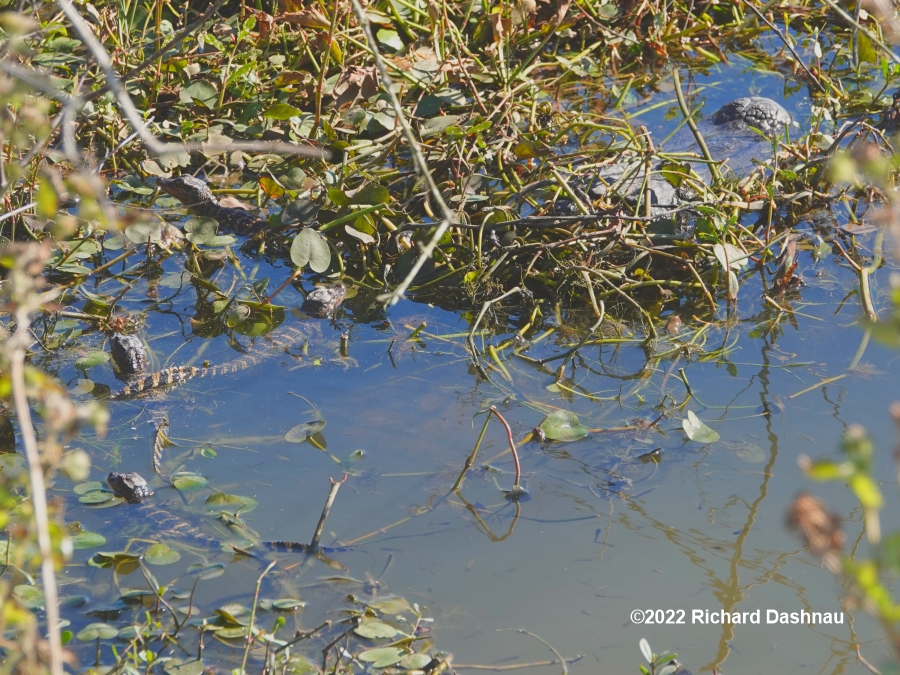
At 2:20 57°F on trail, 52°F at 3in
deep, 55°F at surface water.
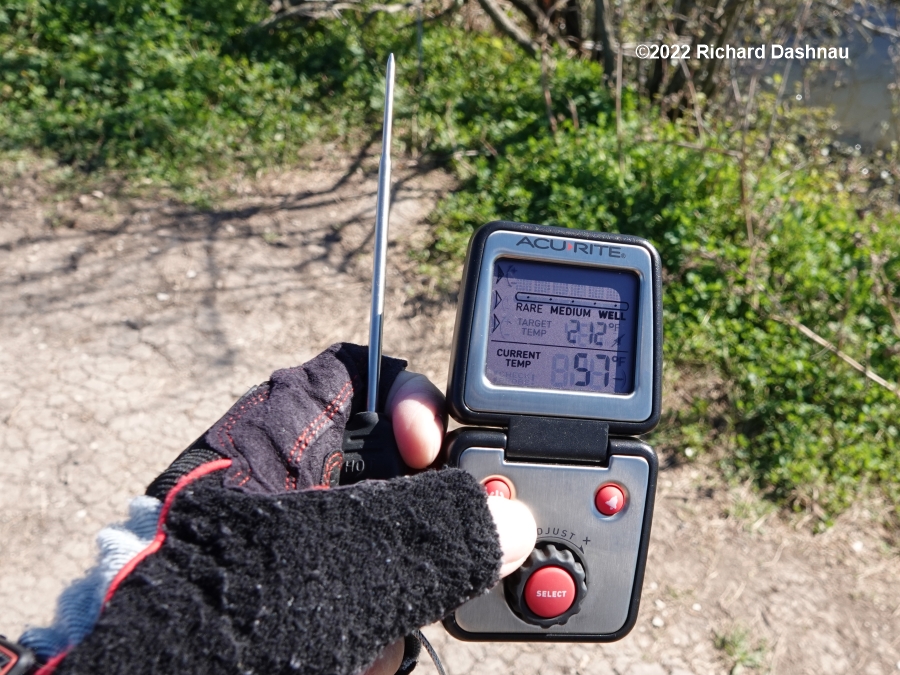
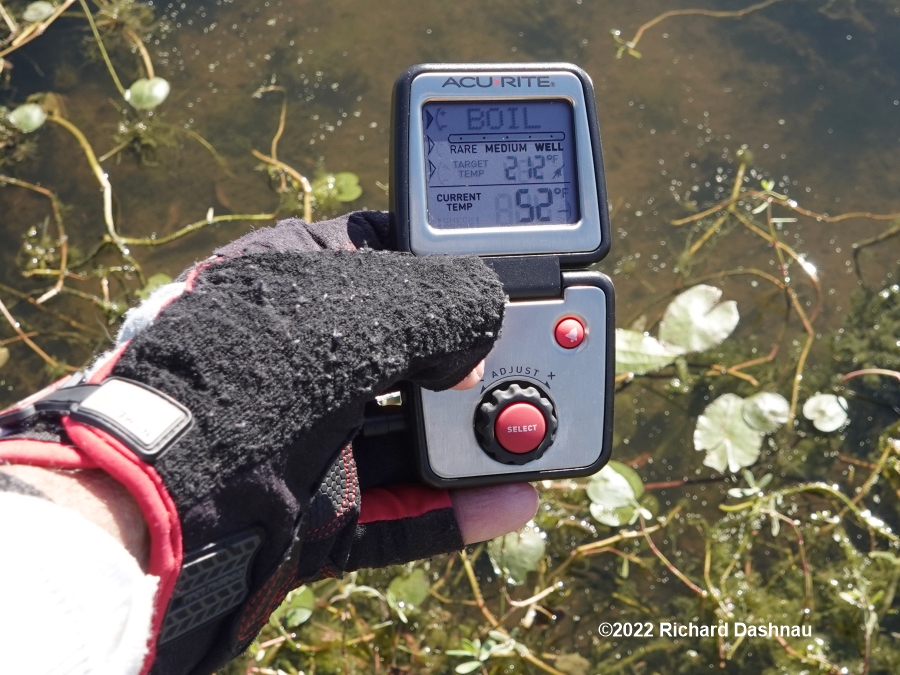
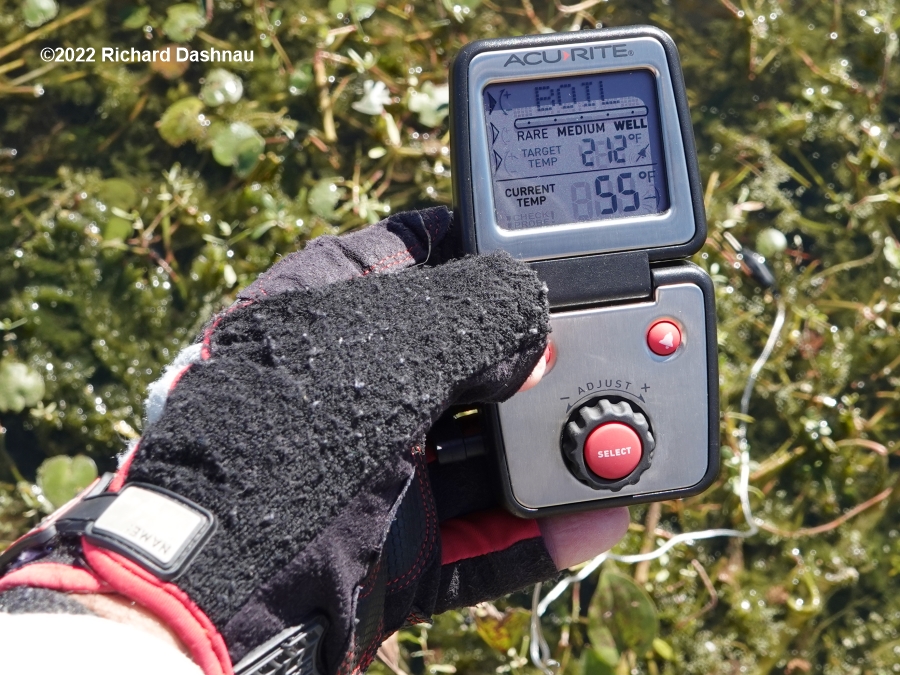
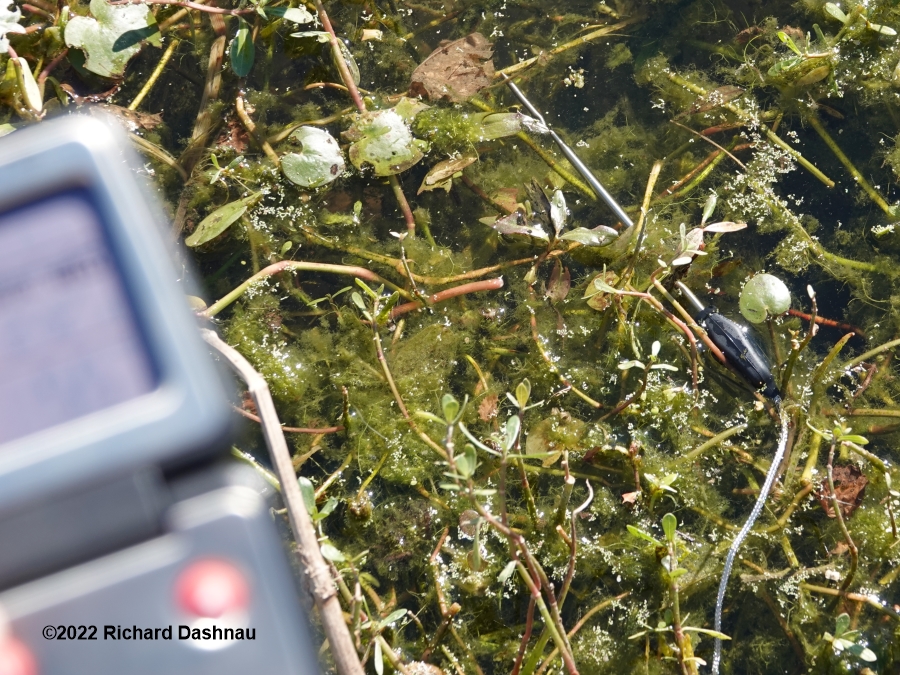
01/30/2022.
About 50°F Brazos
Bend State Park when I got there. I
was near the mother gator's den in the morning, then went
back later.
The bright light and clear water showed her using
the
den. The
first 5 images show her surfacing from while her body is in
the den.
The water is clear enough to show the translucent
nictitating membrane
over her submerged eye.
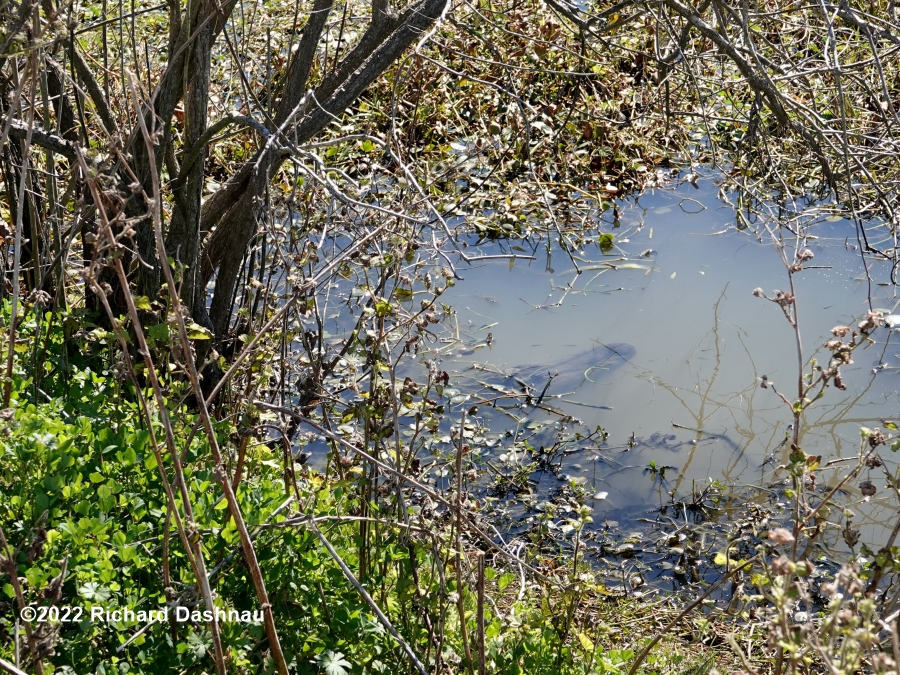
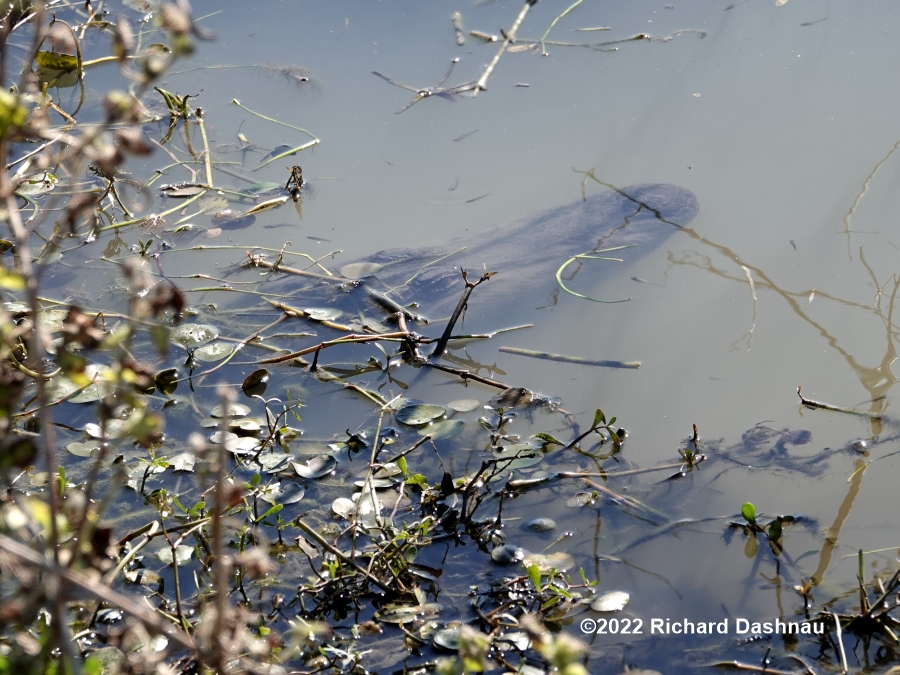
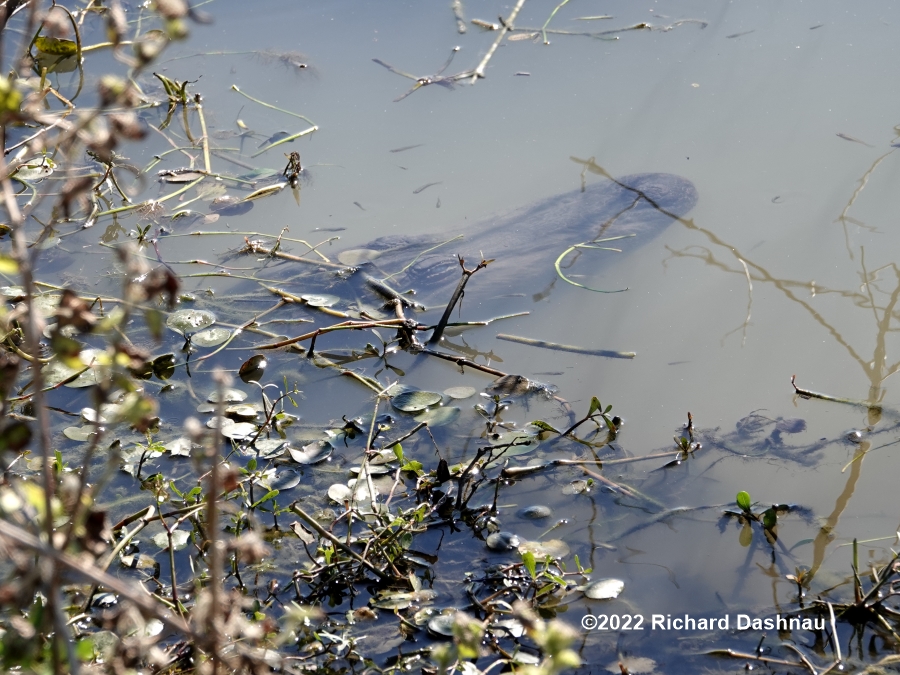
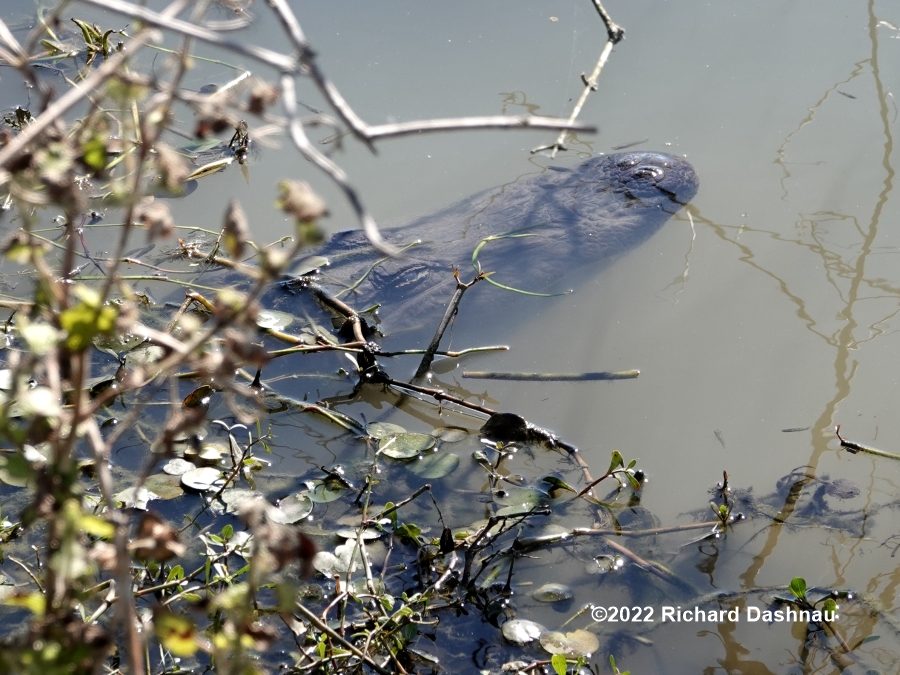
The
next images show how close her head is to the water's edge,
further
evidence that her body is hidden under there. Some of the
baby
alligators were sunning on the bank.
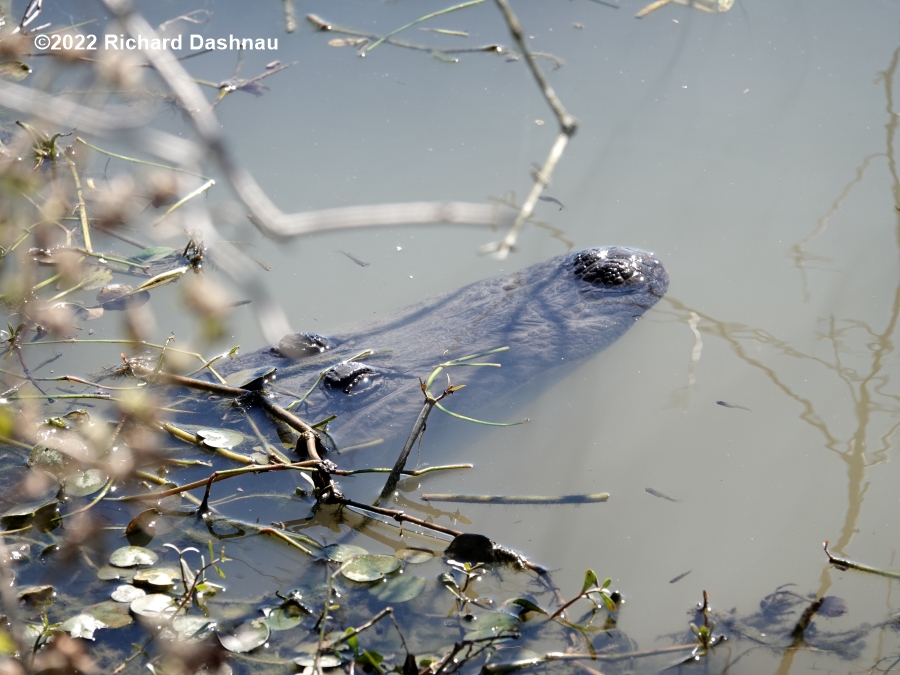
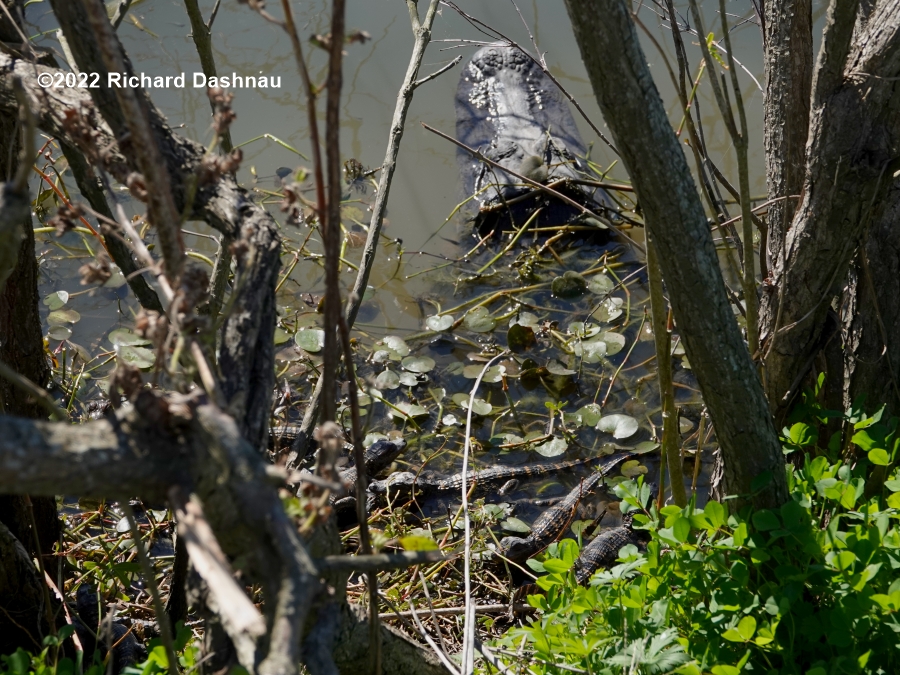
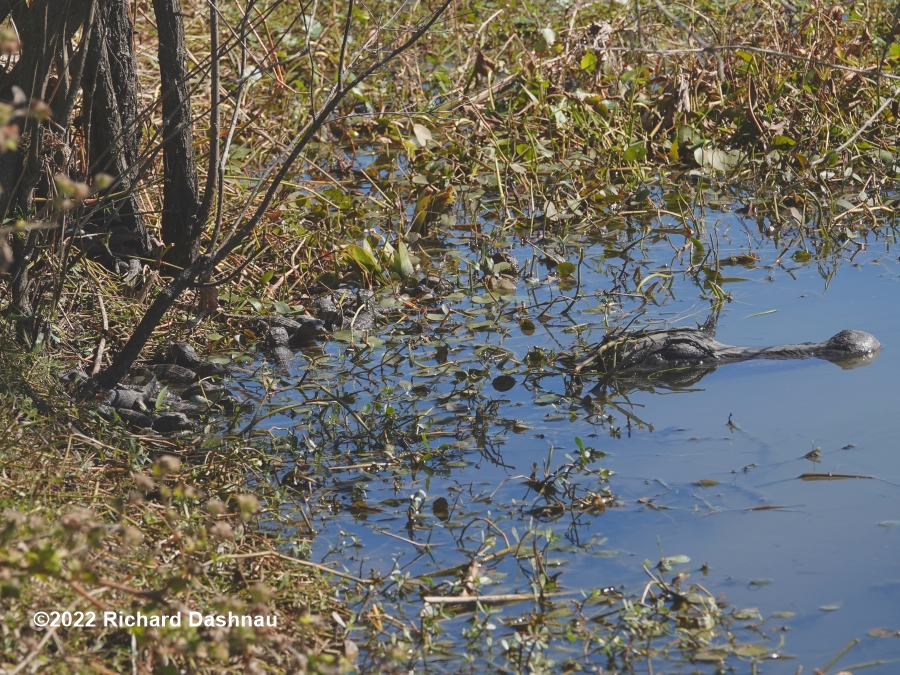
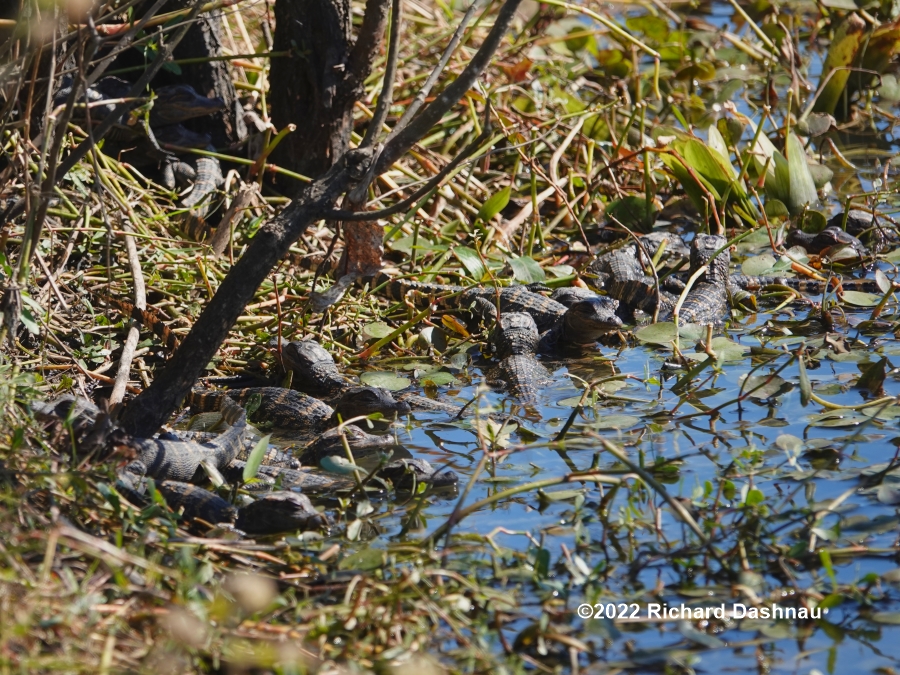
T he last
two longer shots show the cleared area around the den
entrance, and
also more of her body extended from the den.
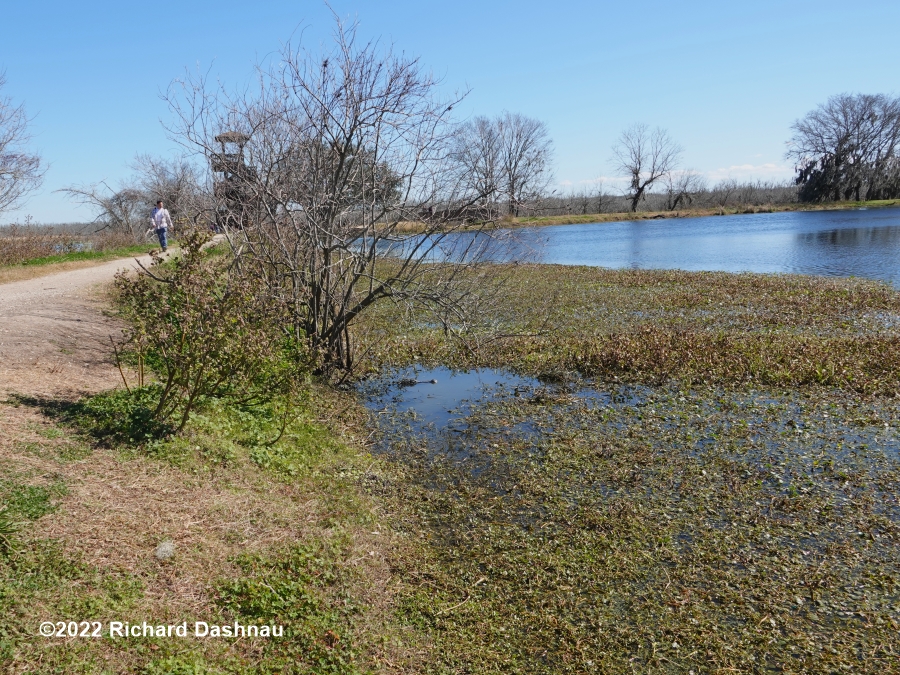
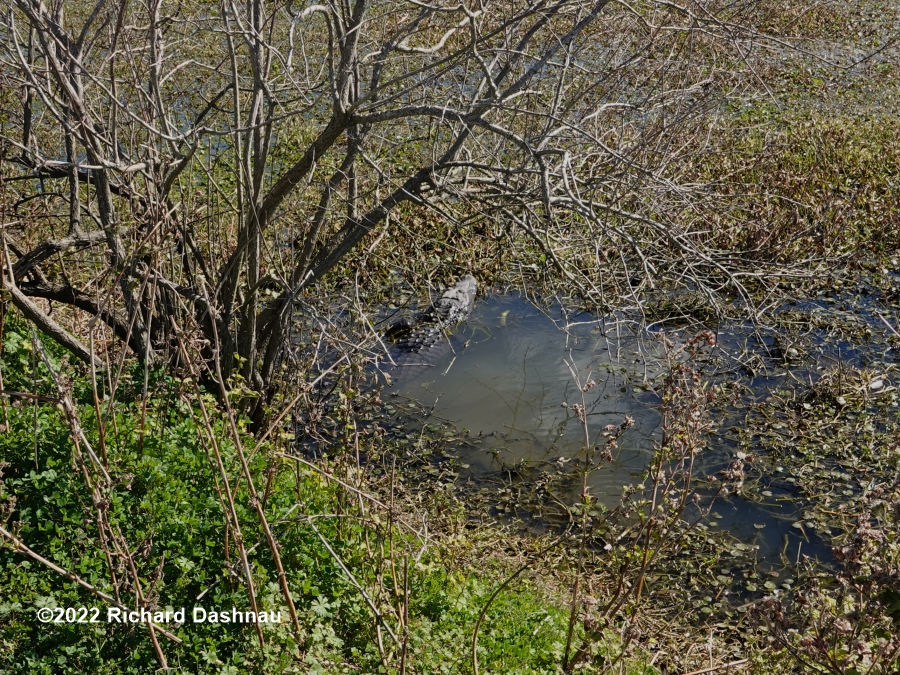
02/27/2022. Pictures
feature the mom gator and her den, and her pod
of baby alligators. Her head was showing around
8:30am, and
air temperature was about 34° F at 9am. I like the cooking
thermometer
because it's very durable. I'd left my electronic one at
home.
Then, I used this wire tie to attach the thermometer
to my
stick. I've been monitoring temperature mostly during
the
colder
days--because I (and many park visitors) wonder how the
alligators deal
with the cold weather.
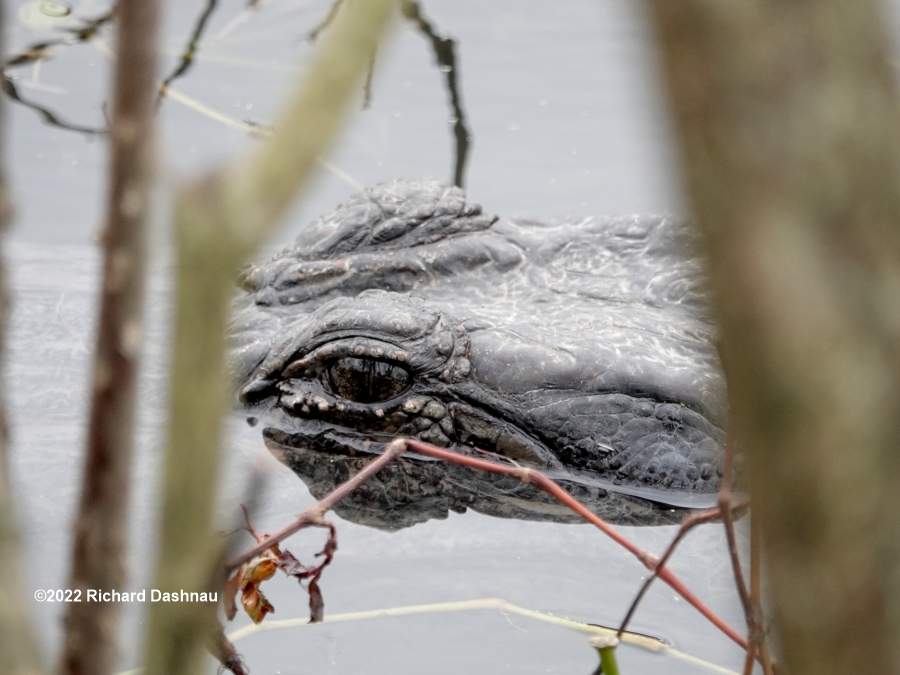
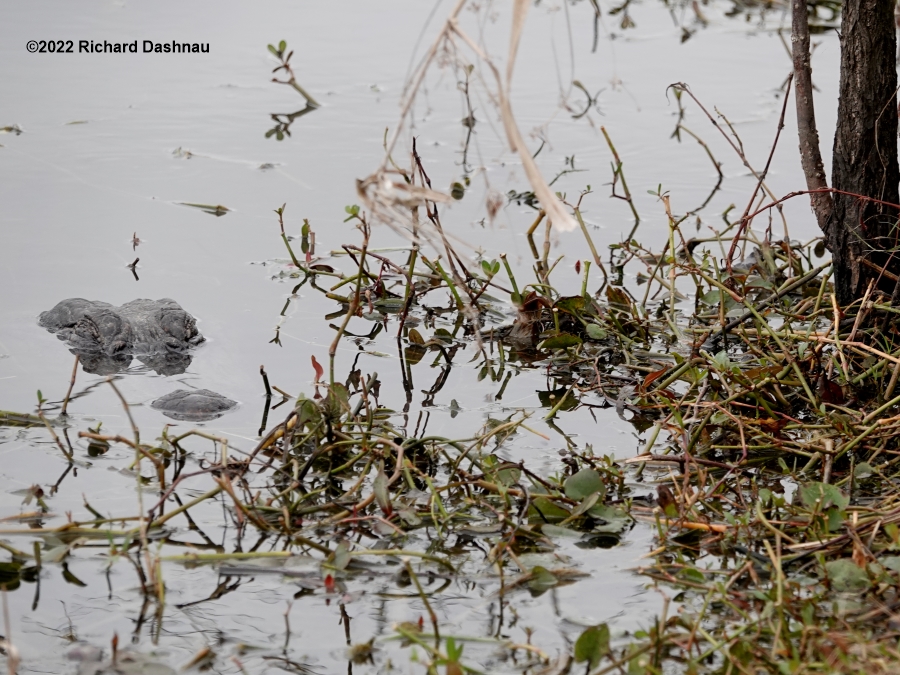
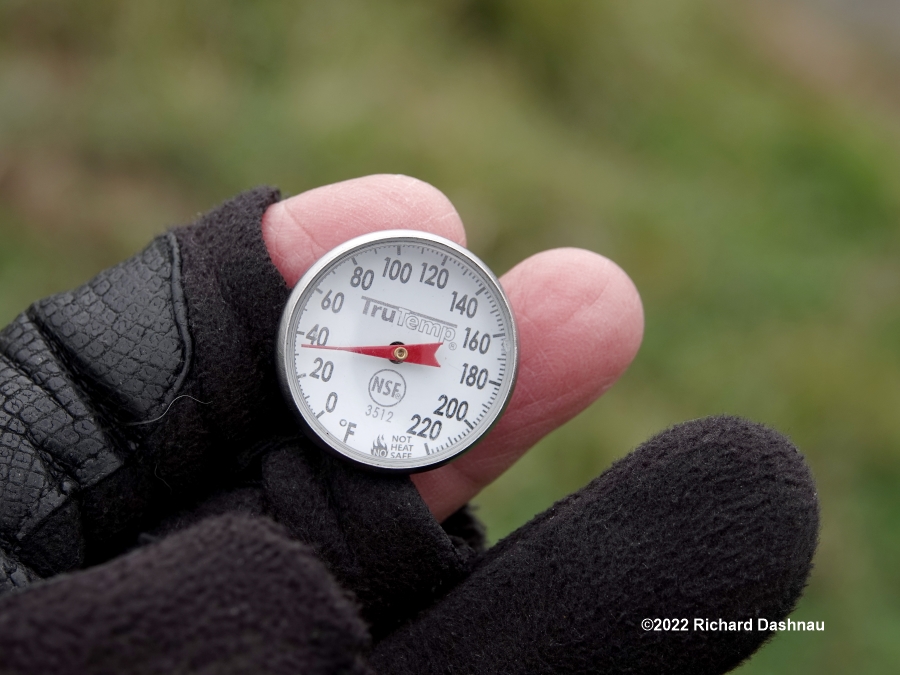
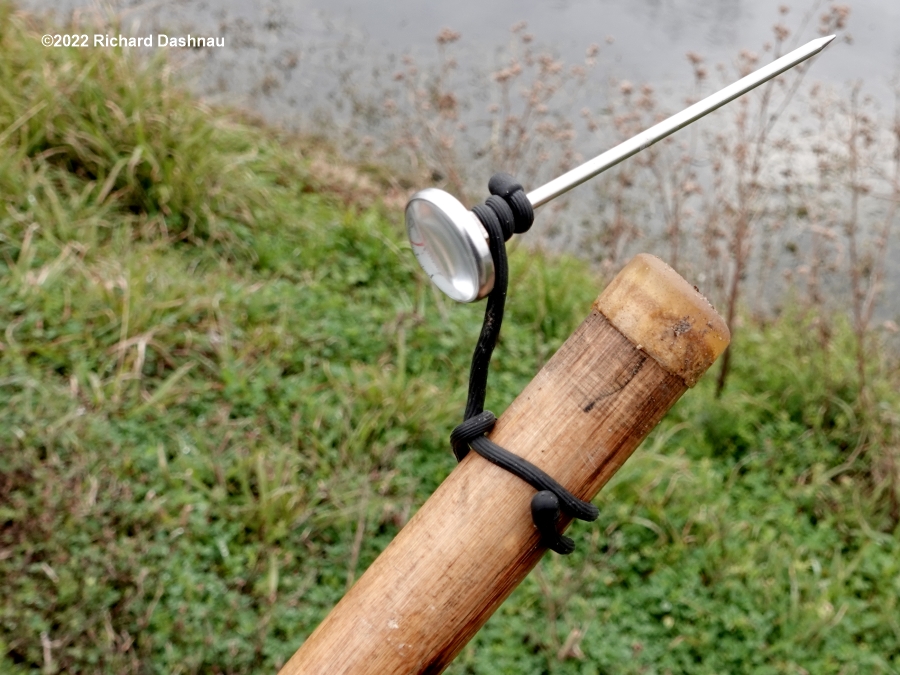
I
used my
stick to submerge the thermometer. The water was a few
degrees warmer, 38° F at
9am.
The mother submerged , but didn't move. At 11:30, the
air
temperature had risen to 52° F.
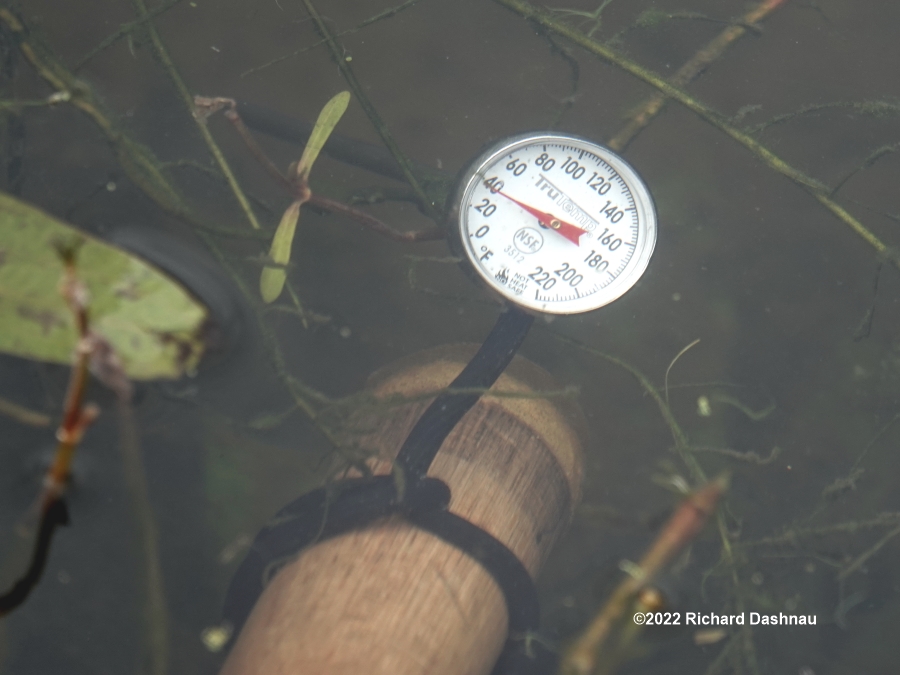
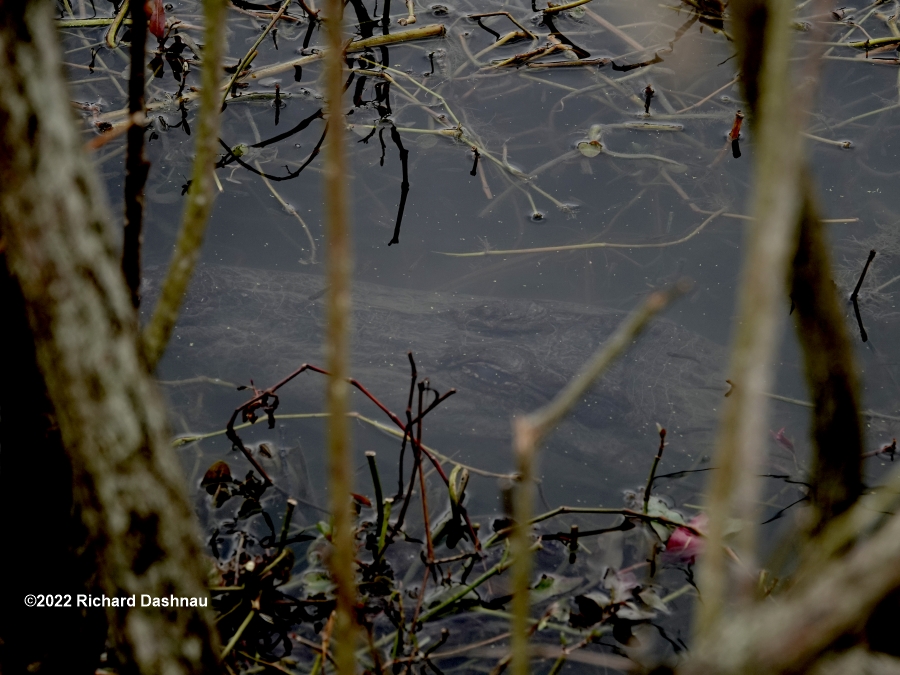
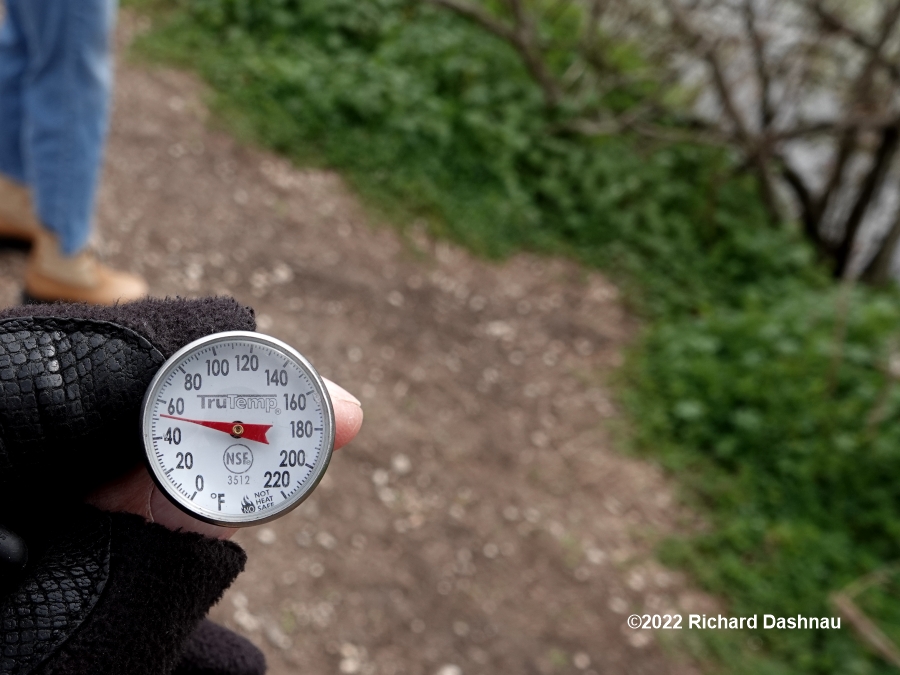
9:00am
9:06am
11:25pm
After
that, the clouds left for a while, and the baby alligators
began to
appear. First, just a few, then--as I spoke to park
visitors, there
were more babies every time I looked. I could not tell where
they'd
been hiding. As the pictures show, they started moving
around, and got
up on the bank to bask. And, they climbed on their
mother.
Everyone loves seeing the baby alligators on mom.
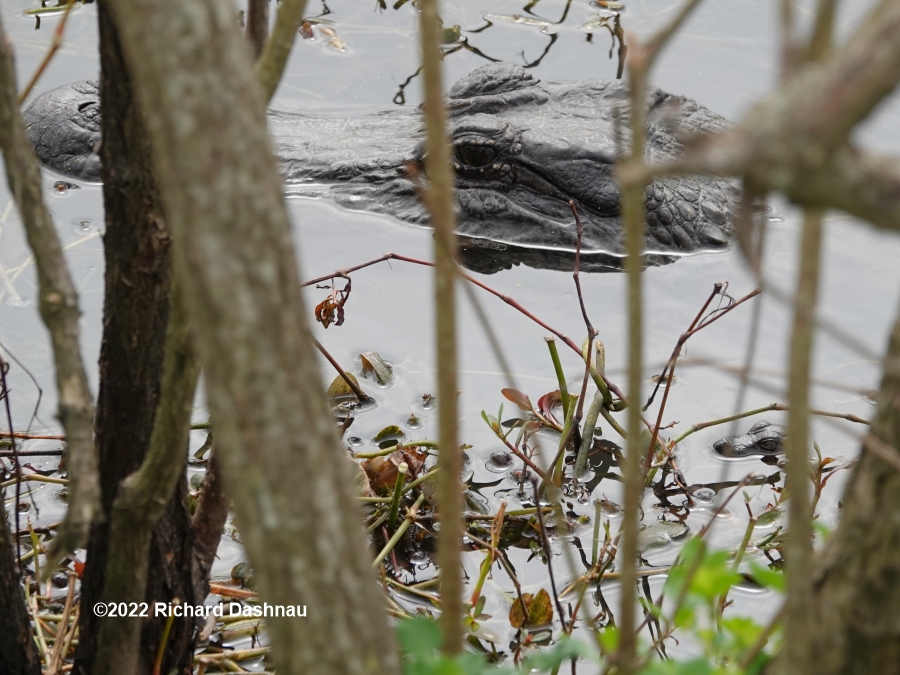
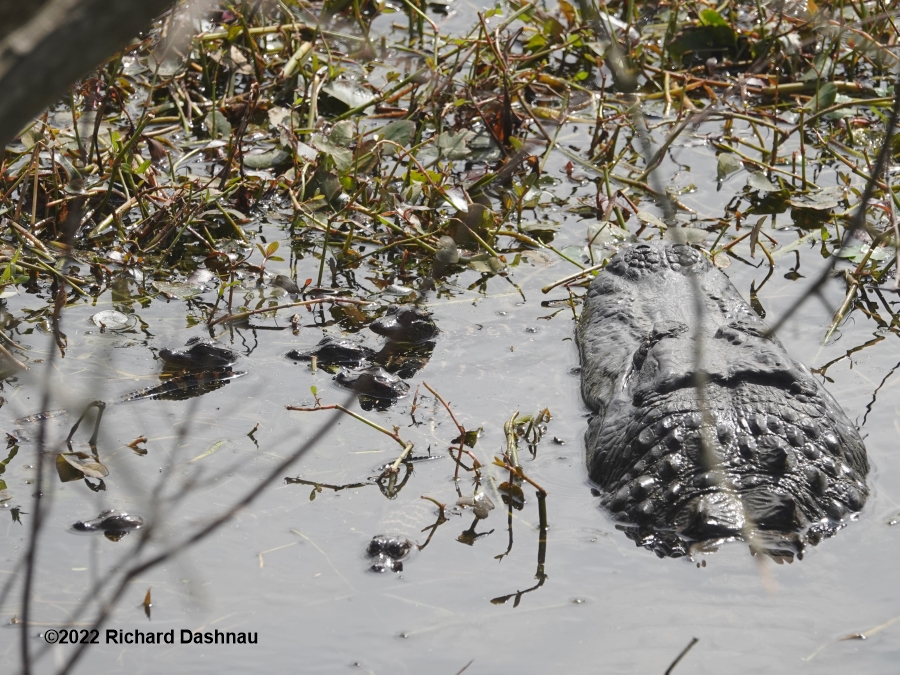
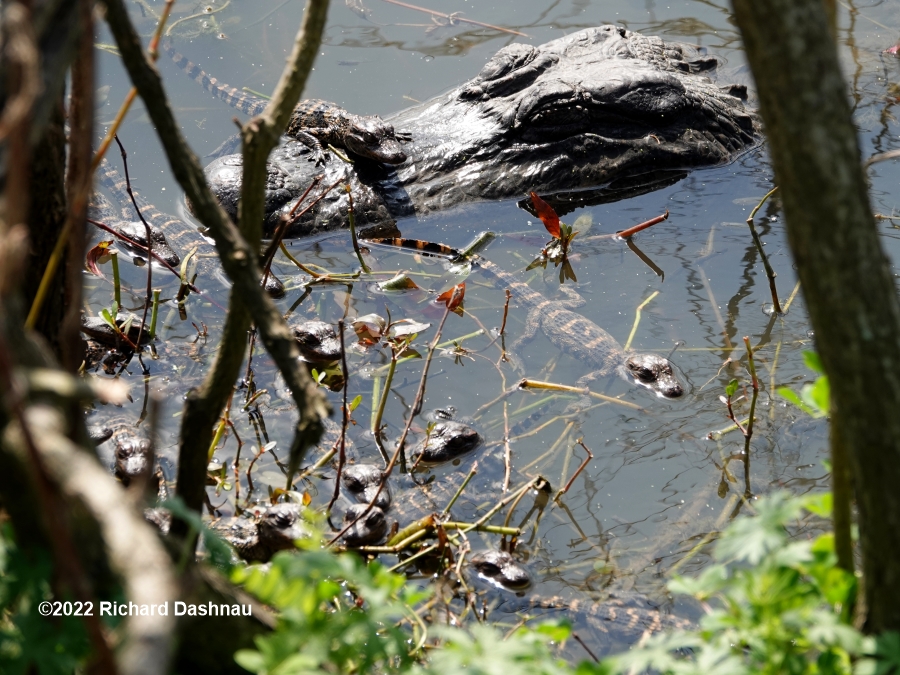
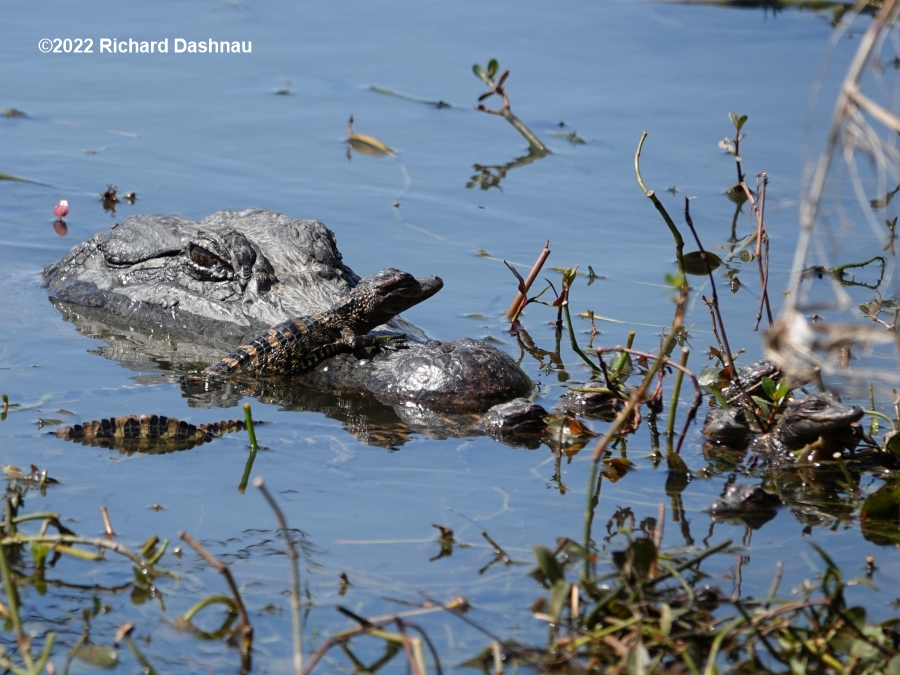
11:27am
11:50am
11:58am
12:06pm
I didn't
take any more temperature readings, but I was in the area
until
12:30pm.
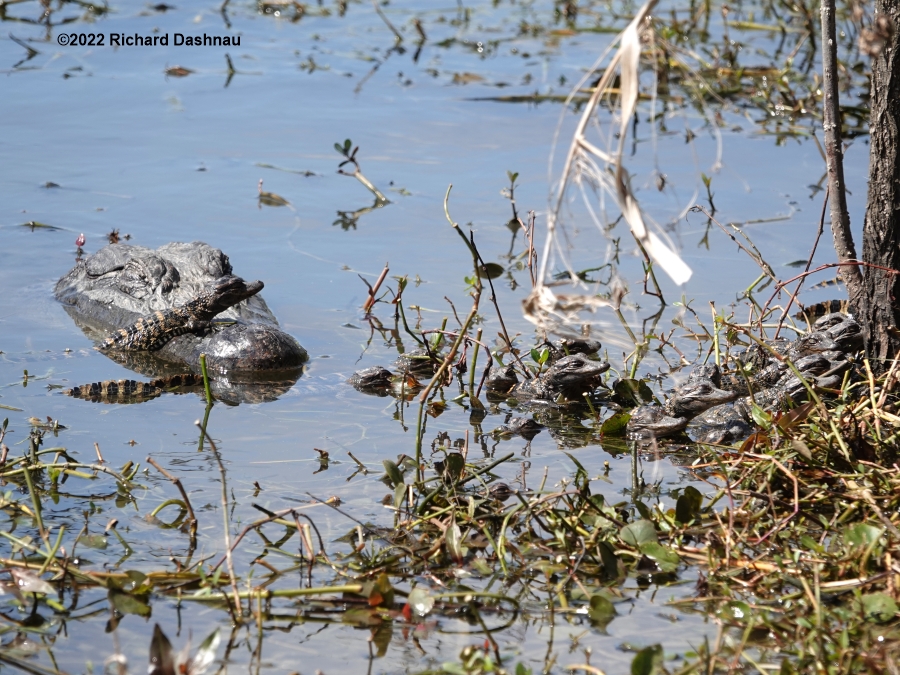
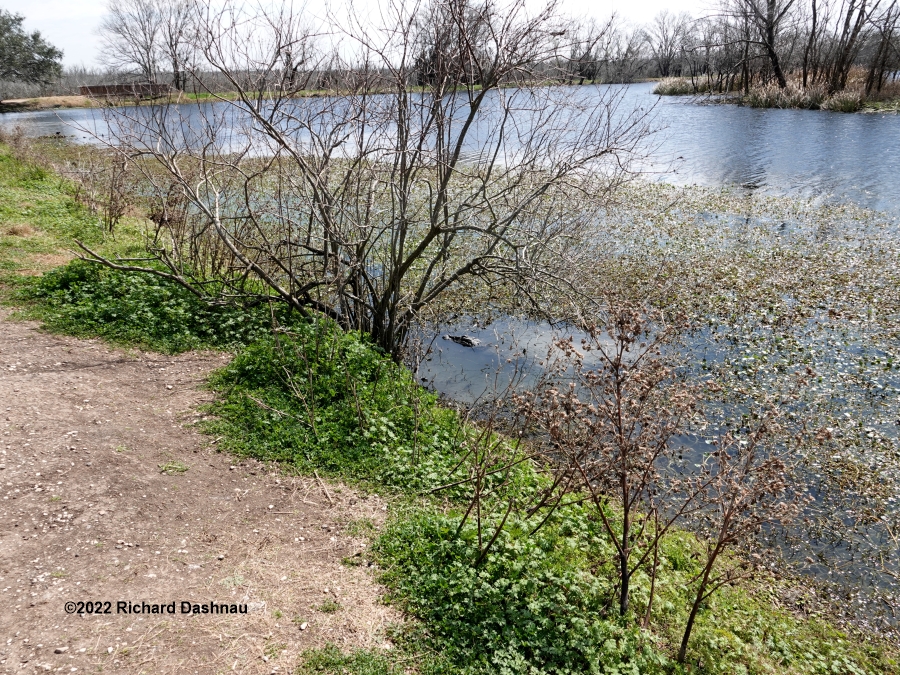
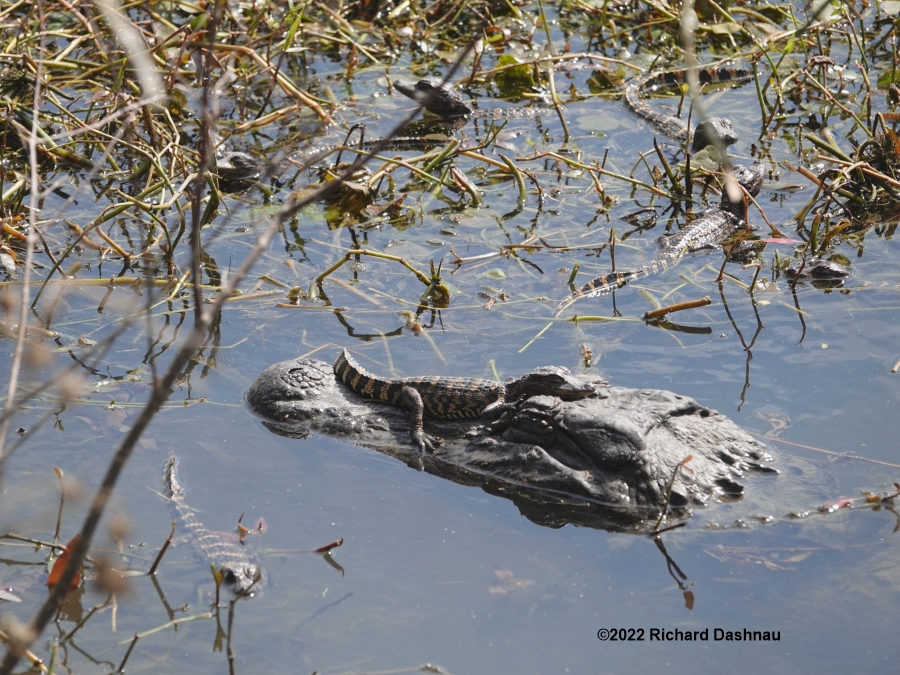
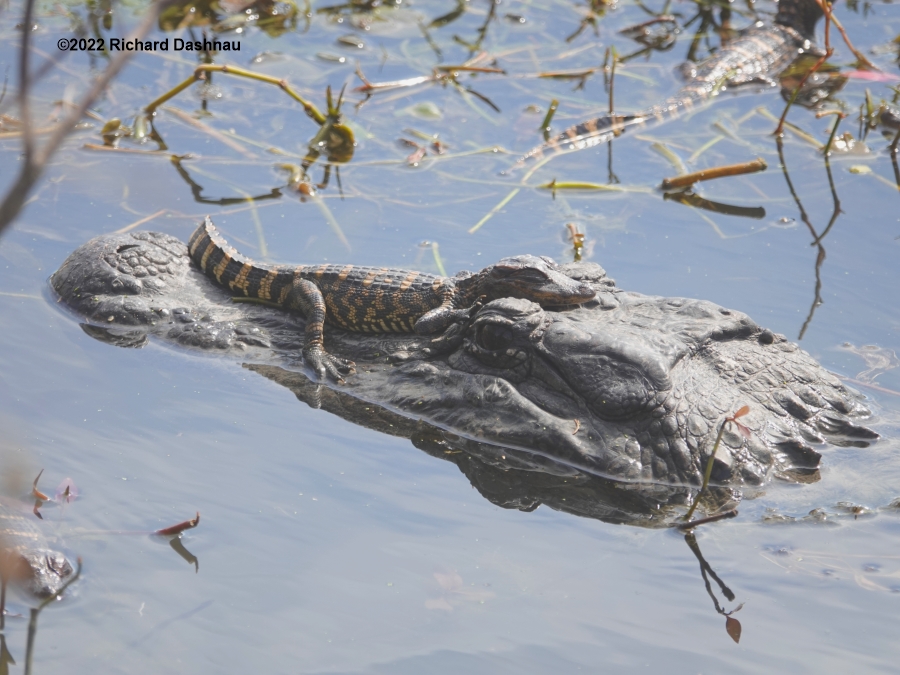
12:06pm
12:20pm
12:21pm
12:21pm
The babies
piled onto their usual spot..
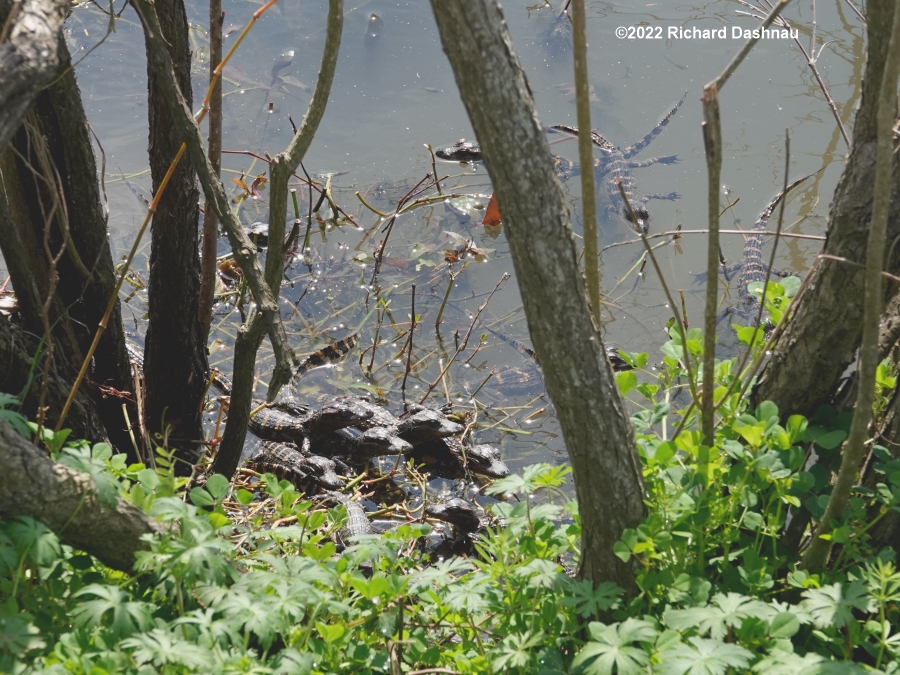
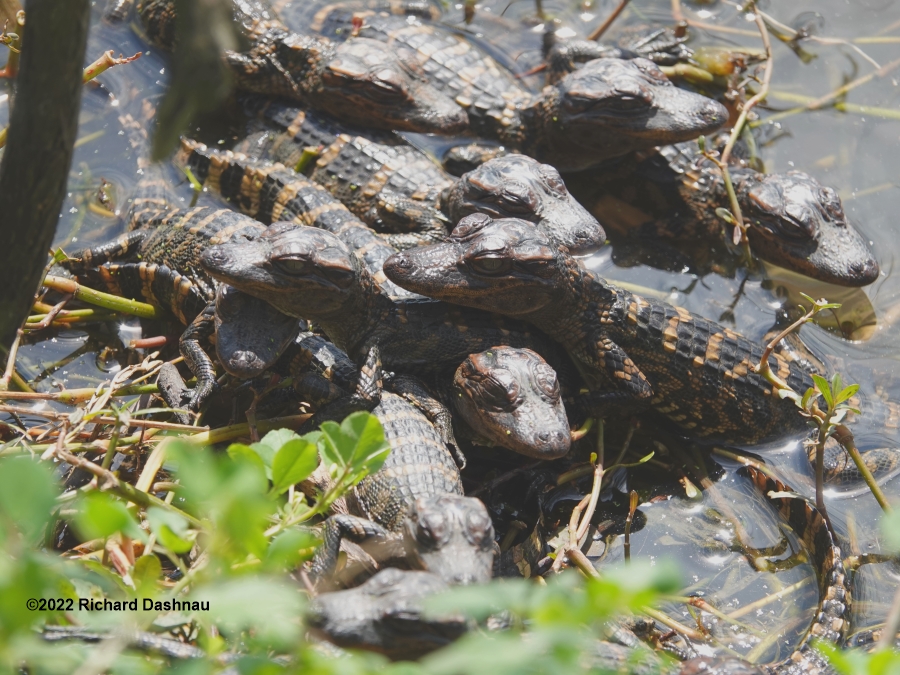
12:25pm
12:28pm
03/13/2022. Another
cold morning at BBSP.
The pictures below are from that day. I went
back to using
the simpler analog thermometer. I used a coated wire
tie to
secure the thermometer
to my 6 ft stick so I could test the water temperature. Air
temperature was 42° F near
the water, temperature in the water was about 50° F.
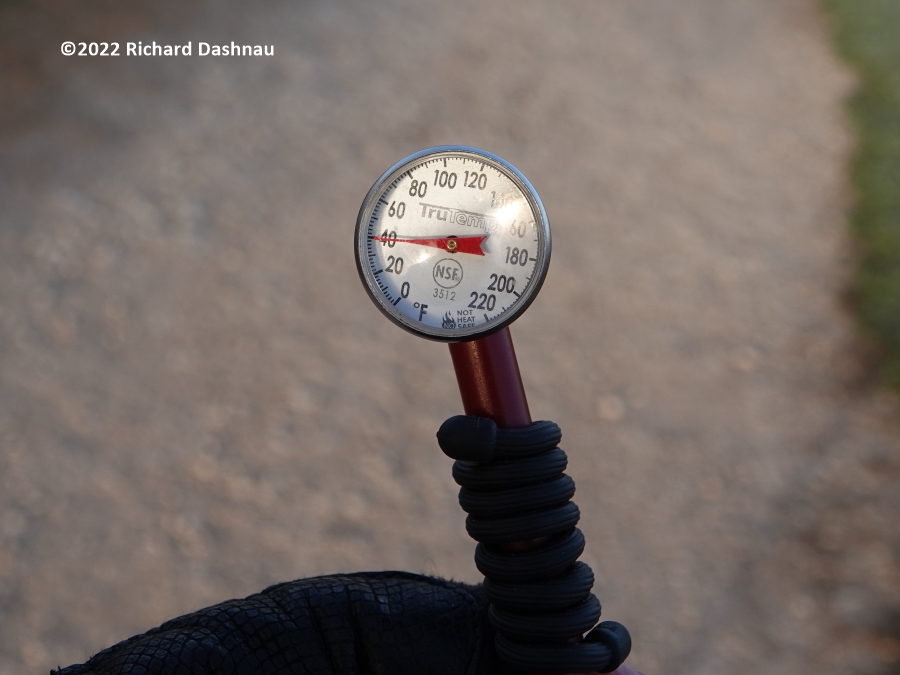
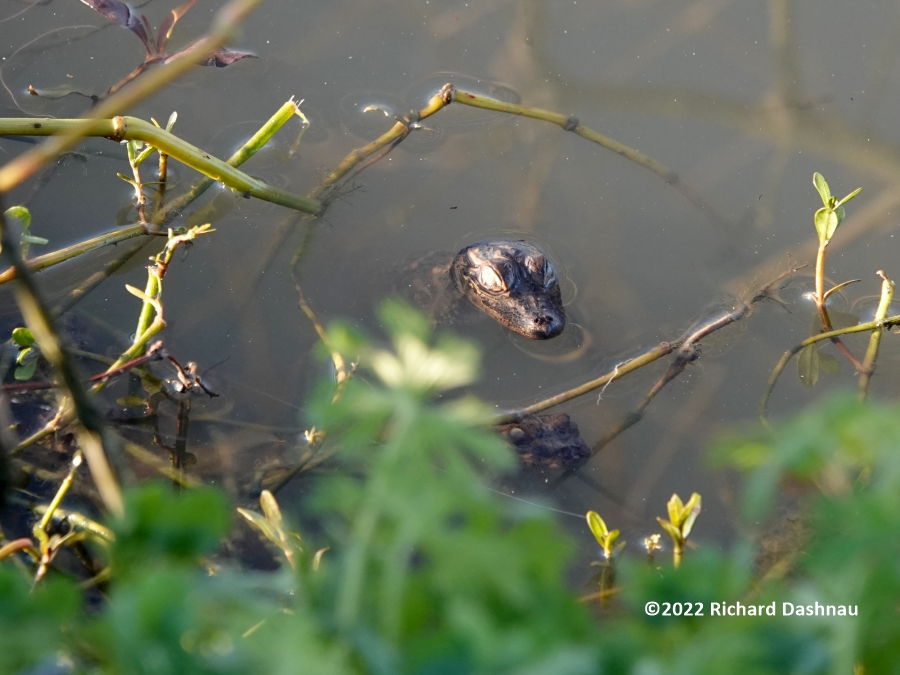
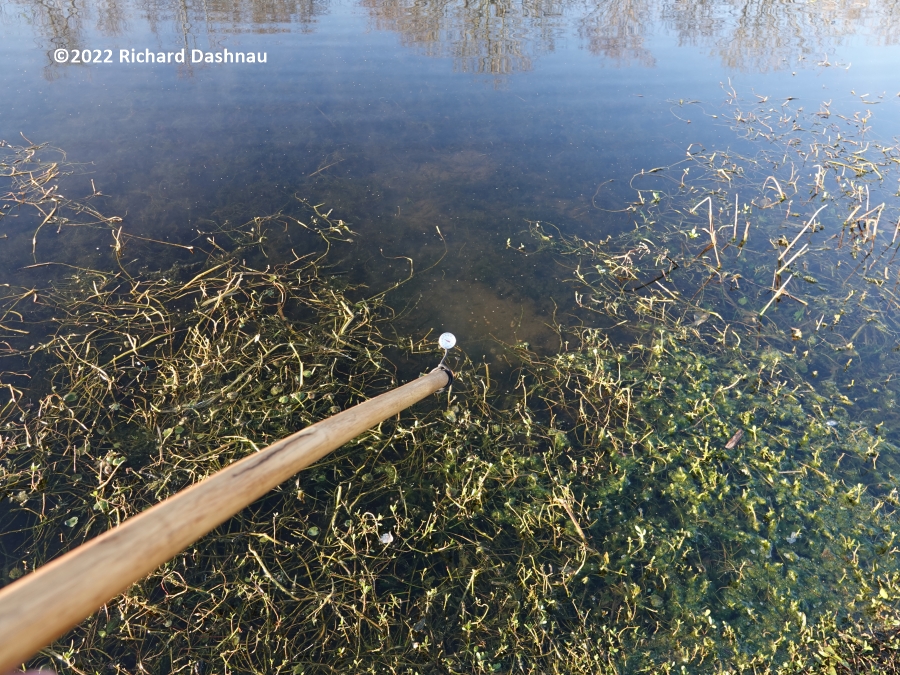
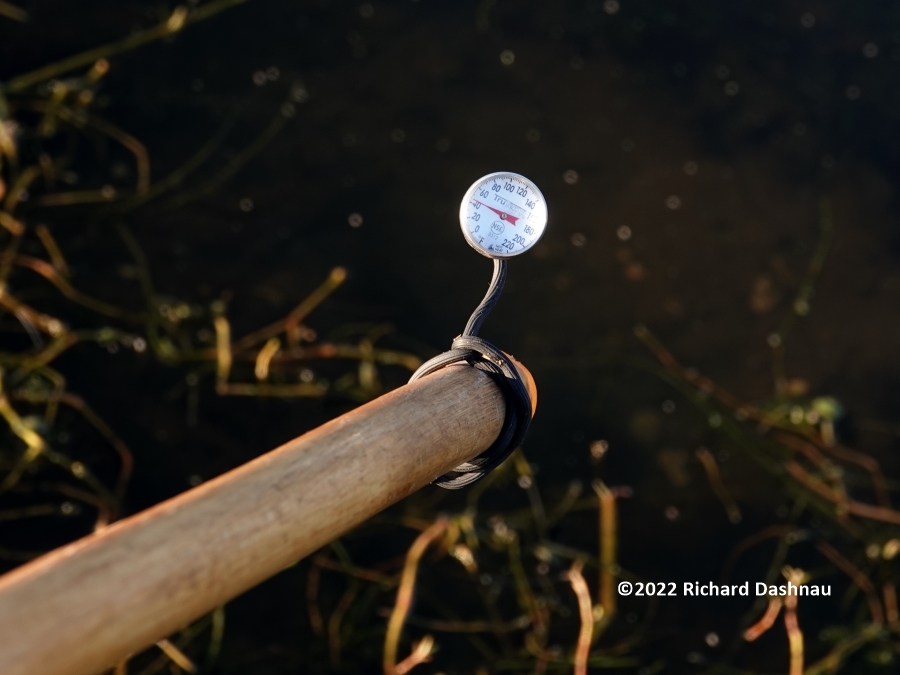
8:06am
8:12am
8:14am
8:14am
At
8:15am, air temperature was 42° F near
the water, temperature in the water was about 50° F.
A few minutes later, the mother gator and some of her
babies surfaced, although only their
heads were visible.
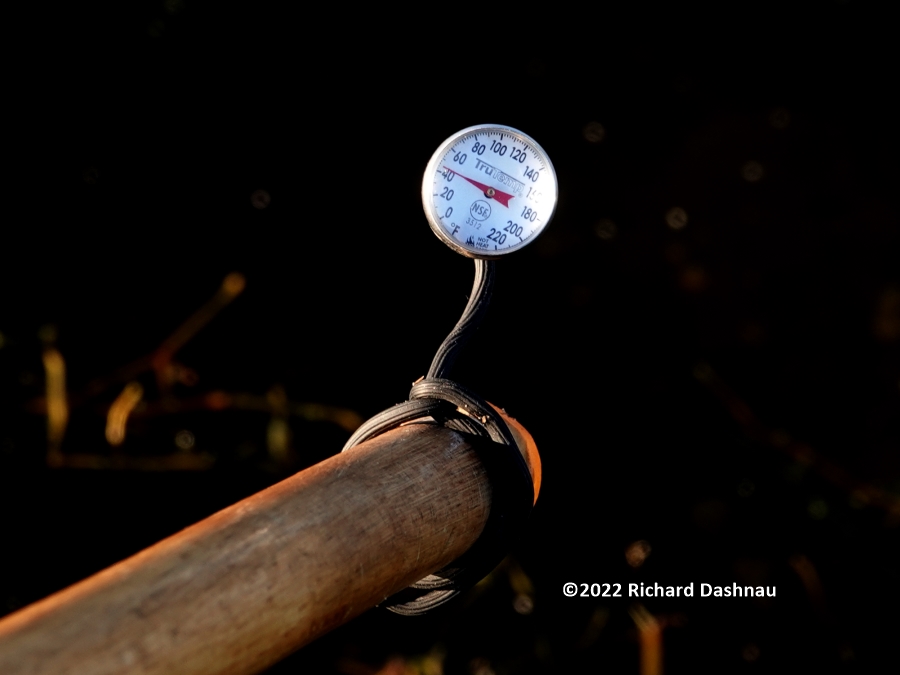
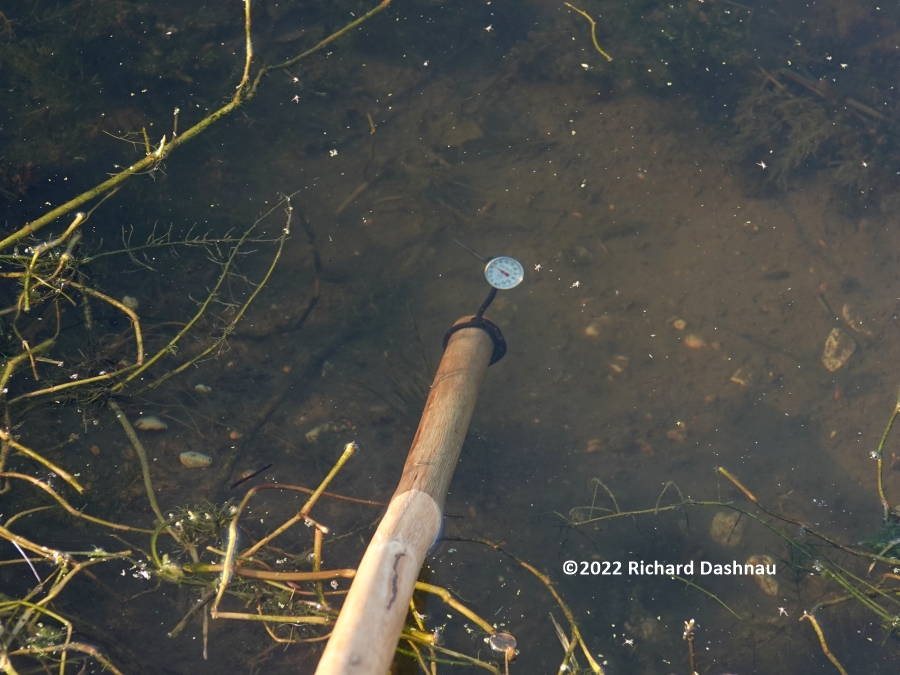
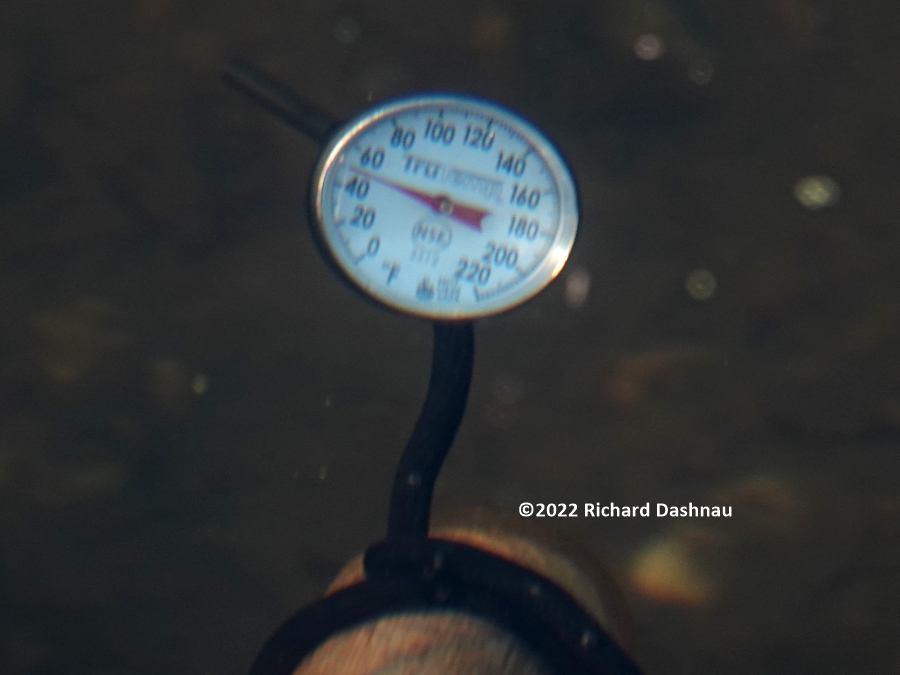
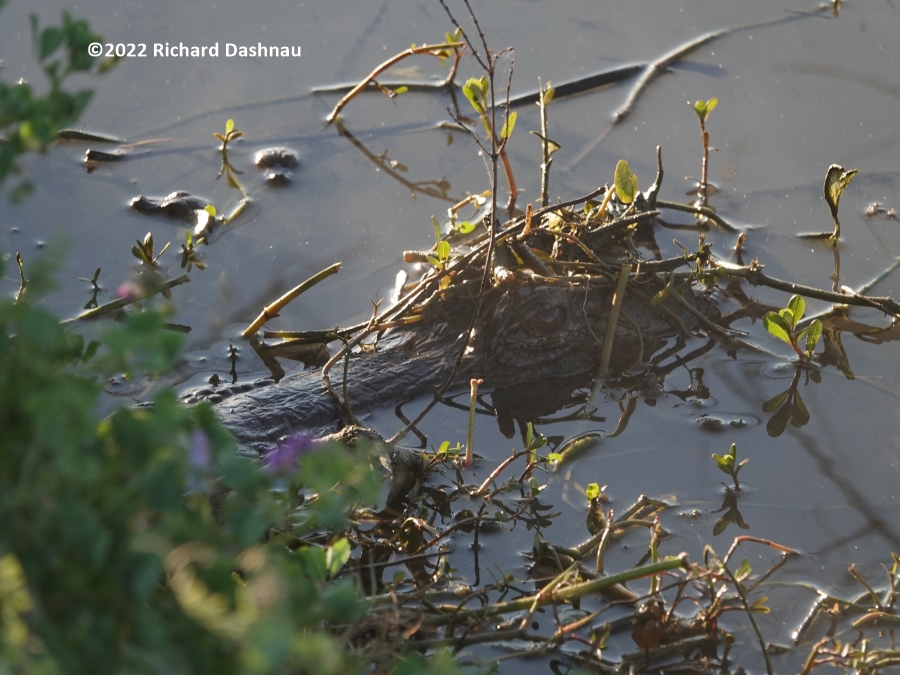
8:14am
8:14am
8:14am
8:17am
By
noon, air temperature was 60° F on
the trail, temperature in the water was about 58° F.
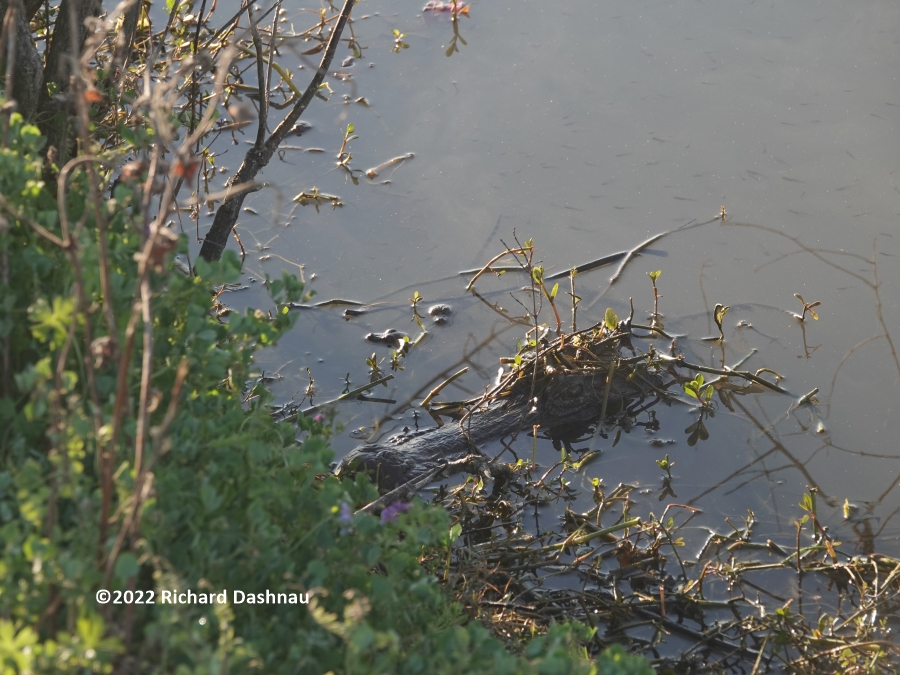
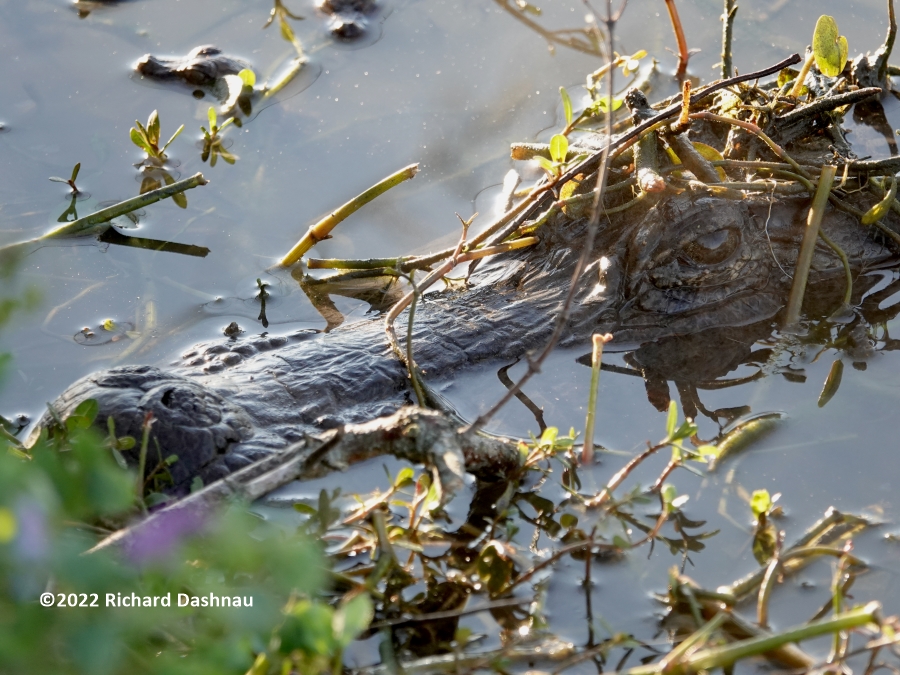
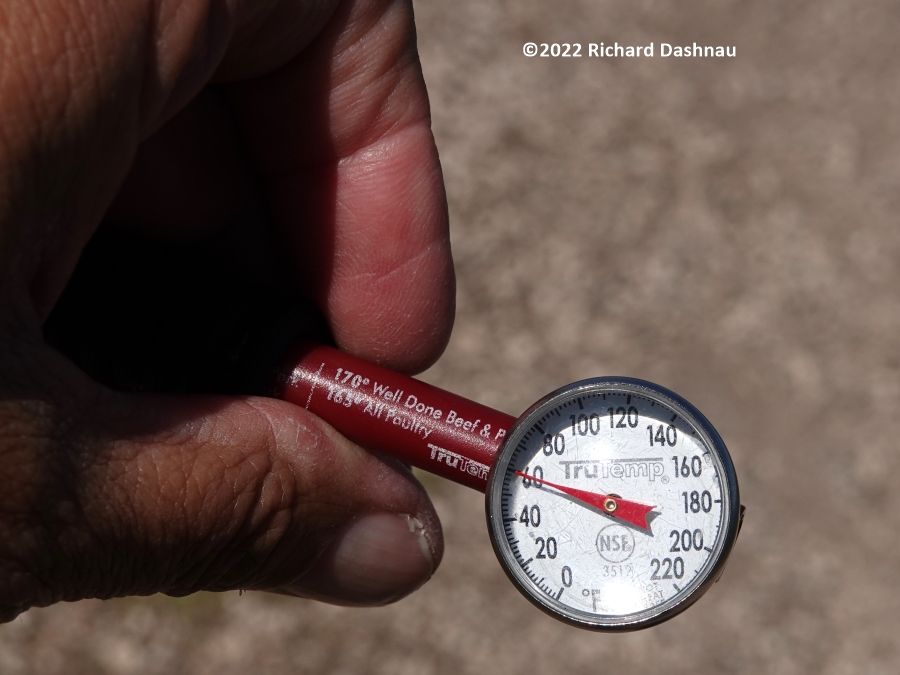
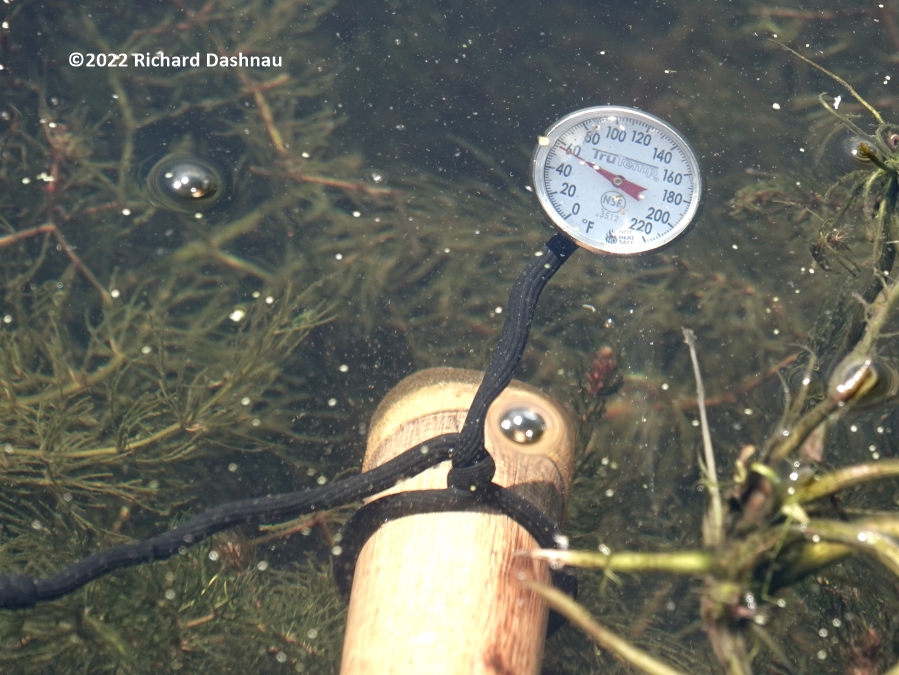
8:18am
8:19am
12:04pm
12:06pm
By
1pm
the mother gator had exposed her back and head to the sun,
but
remained in the water, while the baby gators were moving
around,
foraging, and climbing on their mother.
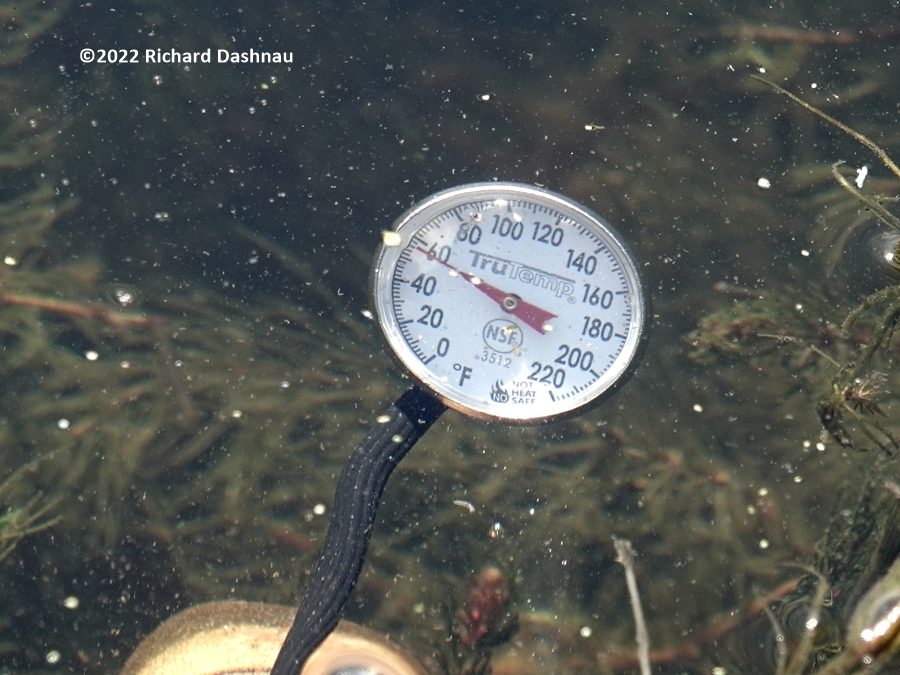
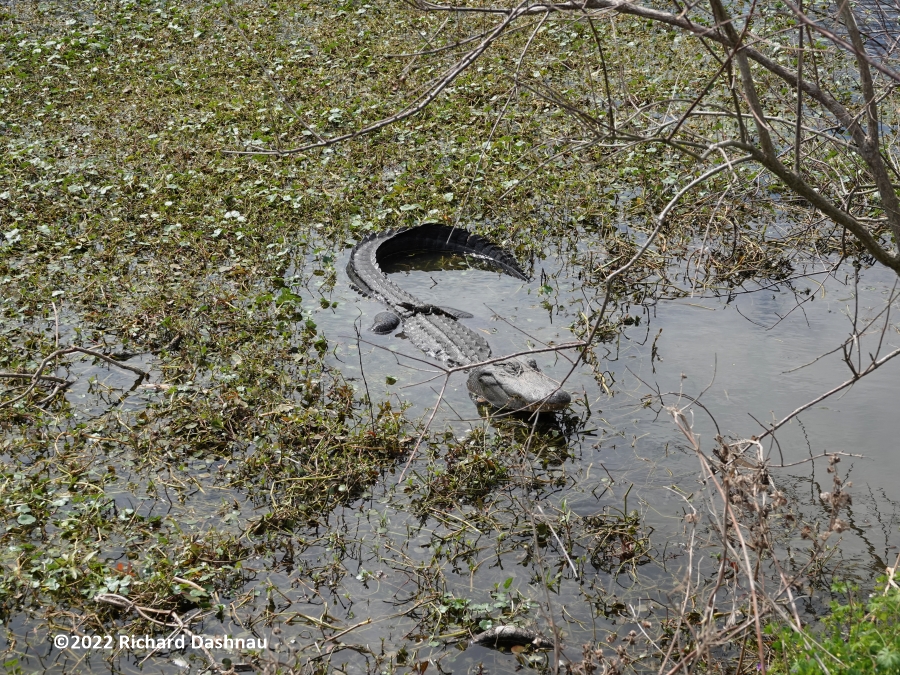
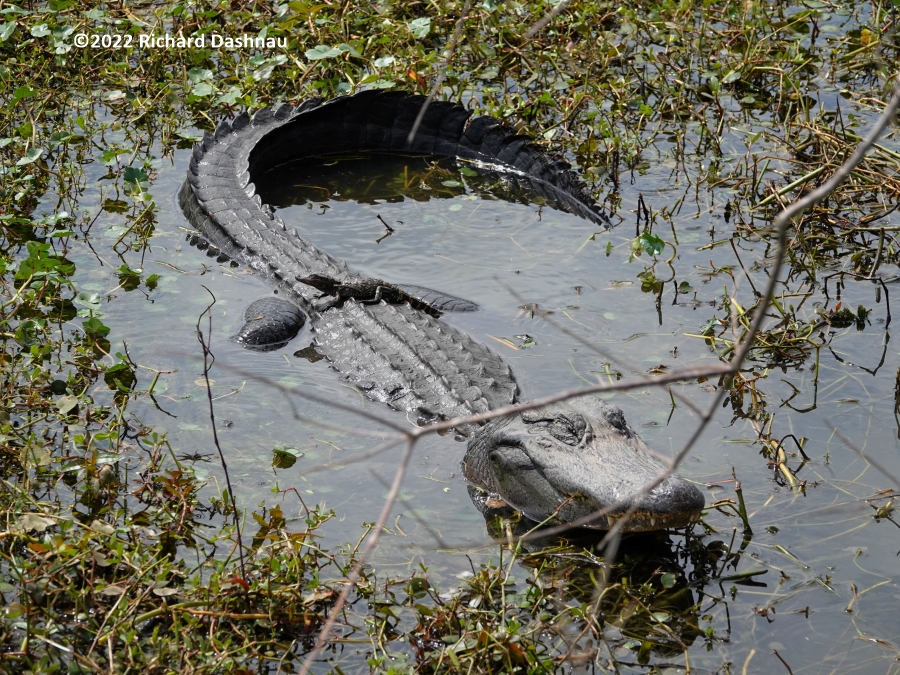
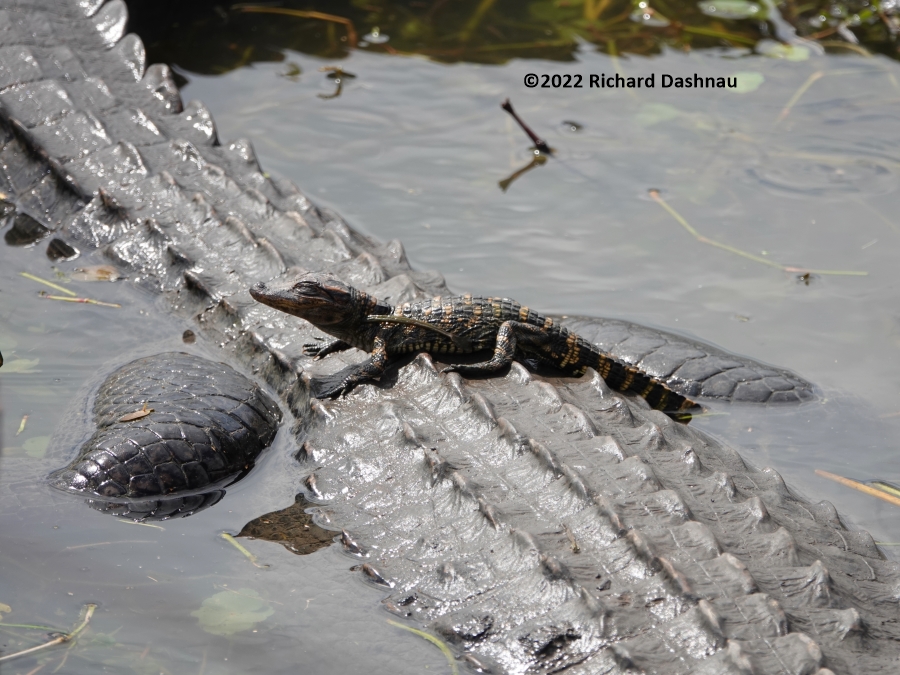
12:06pm
12:49pm
12:49pm
12:49pm
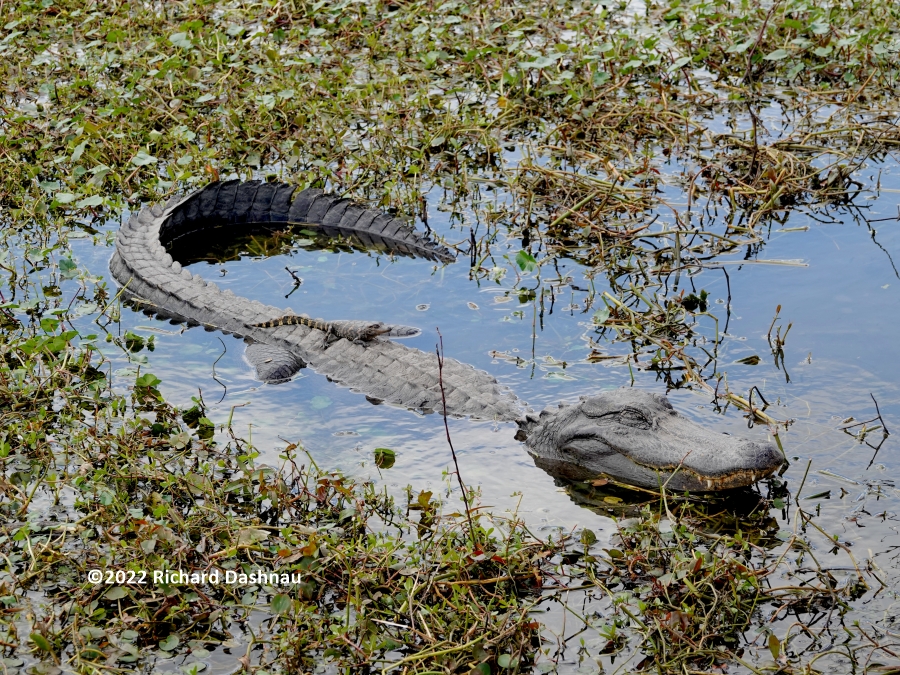
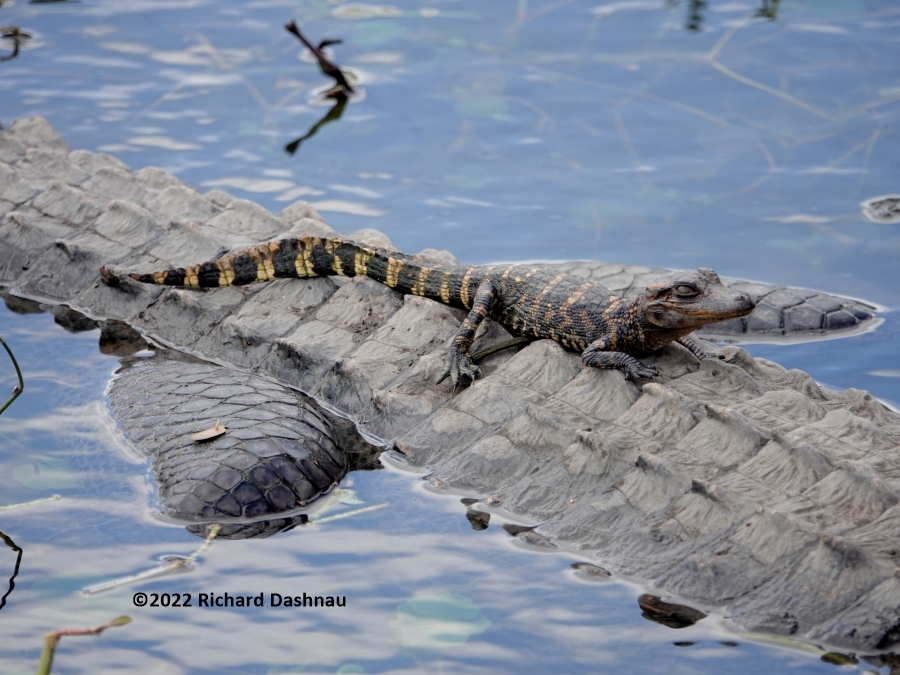
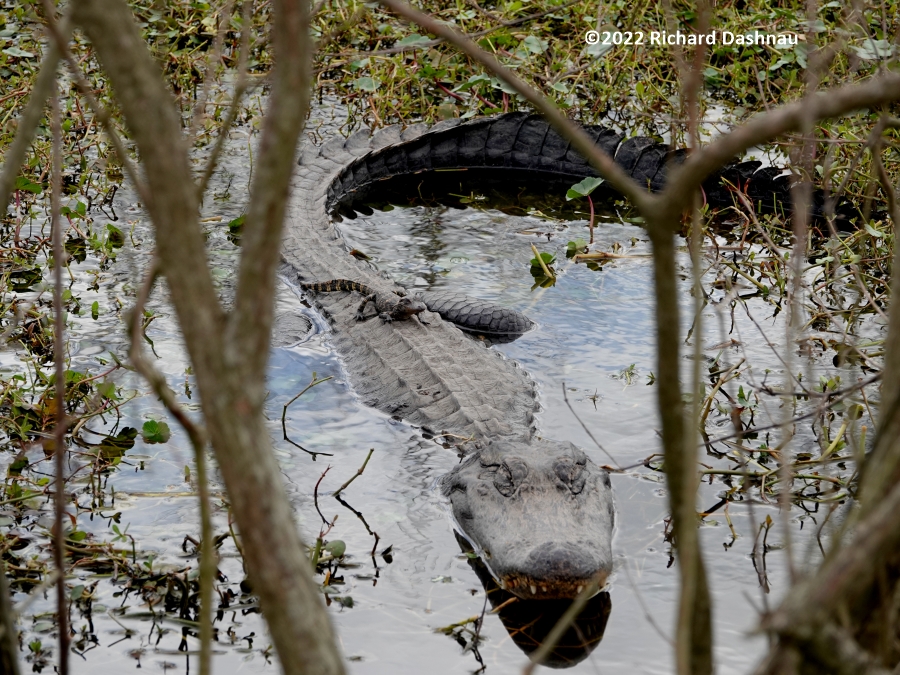
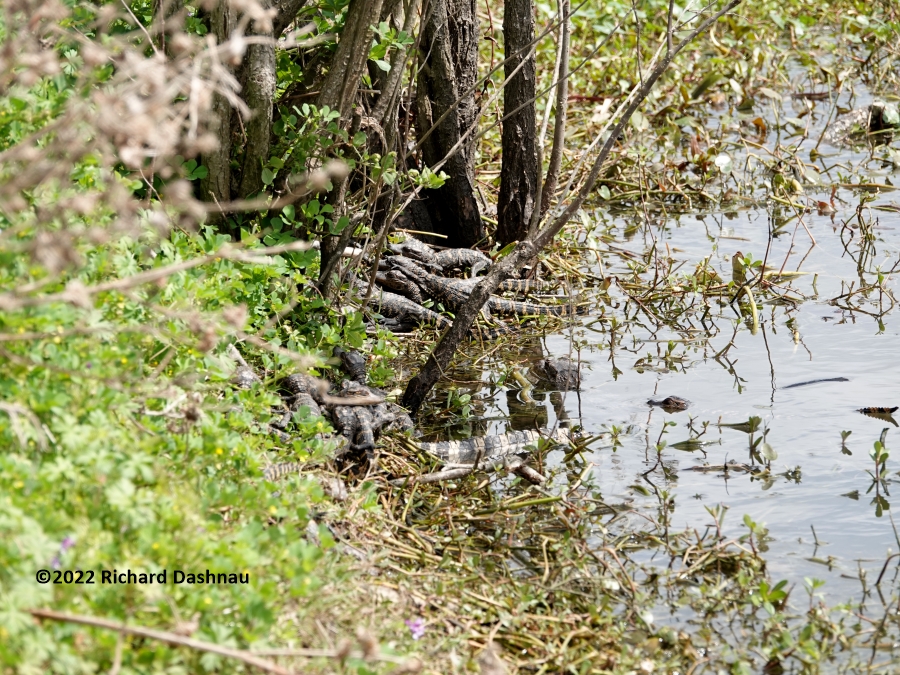
1:07pm
1:07pm
1:53pm
1:58pm
During
the
next hour, as the day got warmer, the baby gators gathered
on the
bank. On days that had started cooler, this seemed to
be the usual
behavior. If temperatures and sunlight
remained
strong through the day, the baby gators would sometimes move
into the
shaded areas near the base of the bush, and form a pile
there.
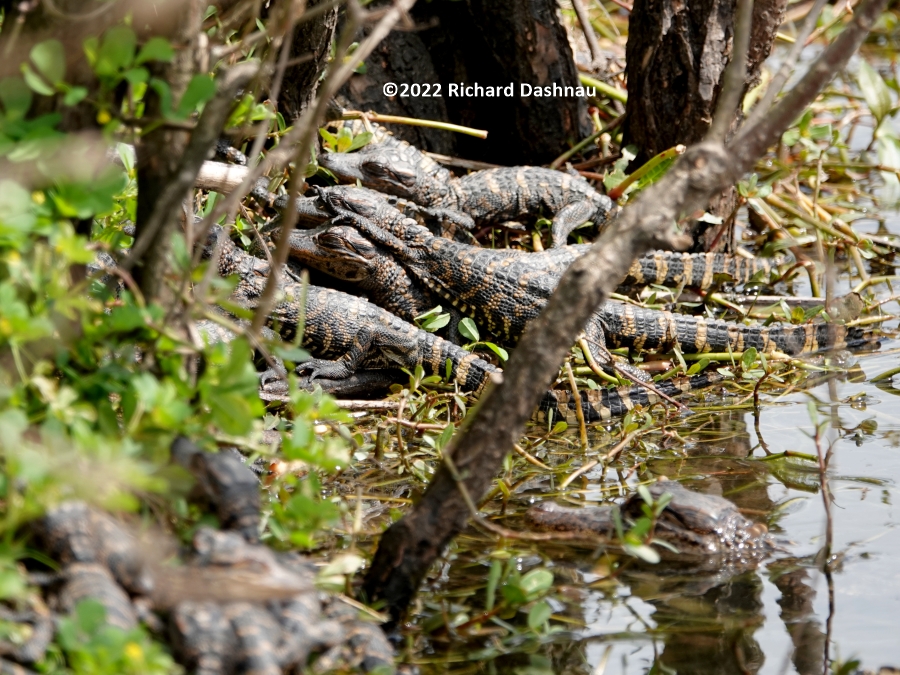
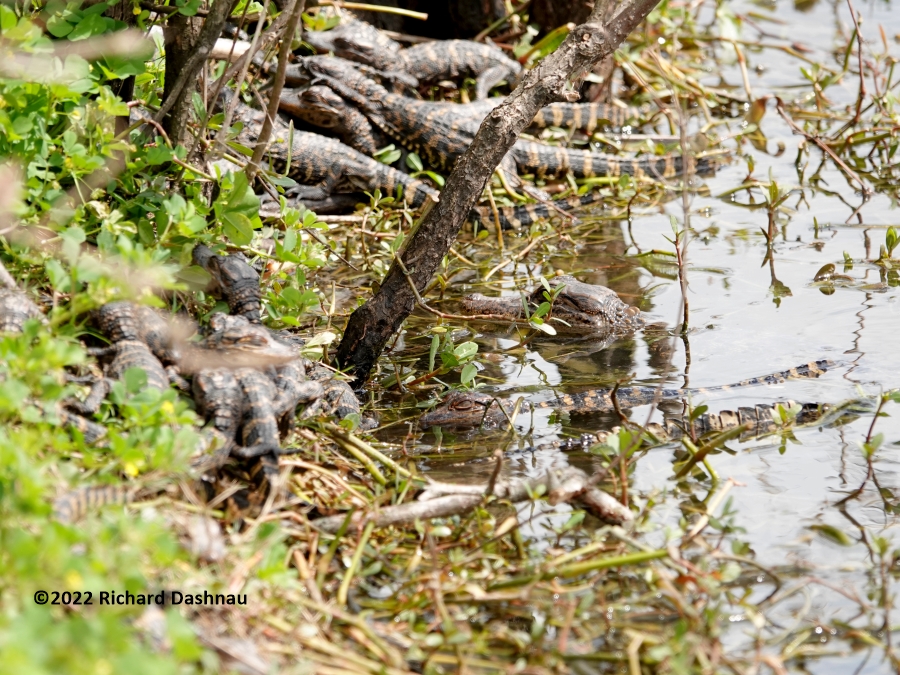
1:59pm
1:59pm
03/20/2022. The
weather warmed up a bit at BBSP (58° F). Mom
gator emerged from her burrow, and the baby gators began to
surface soon after.
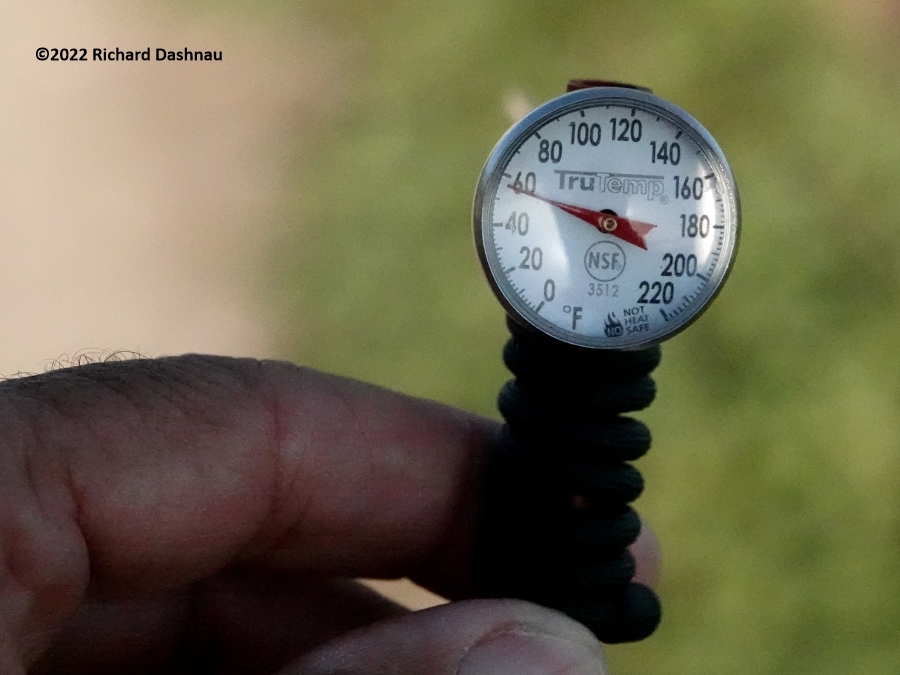
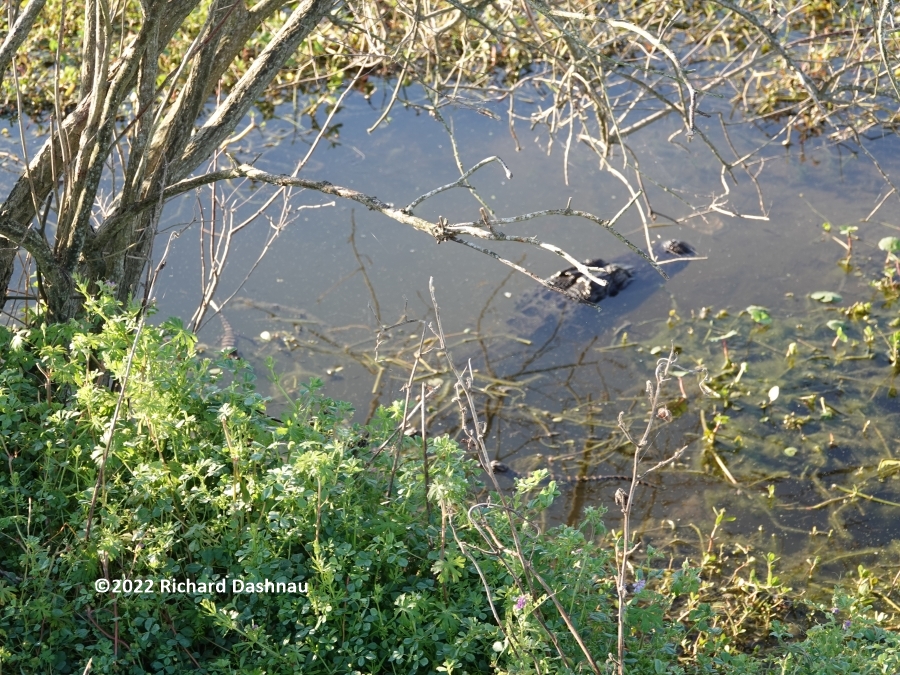
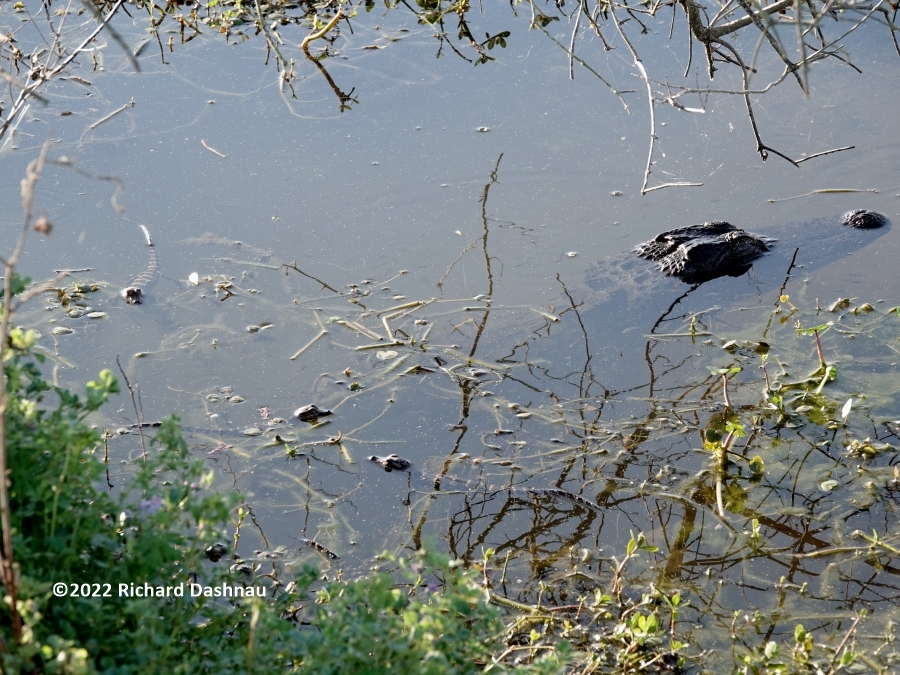
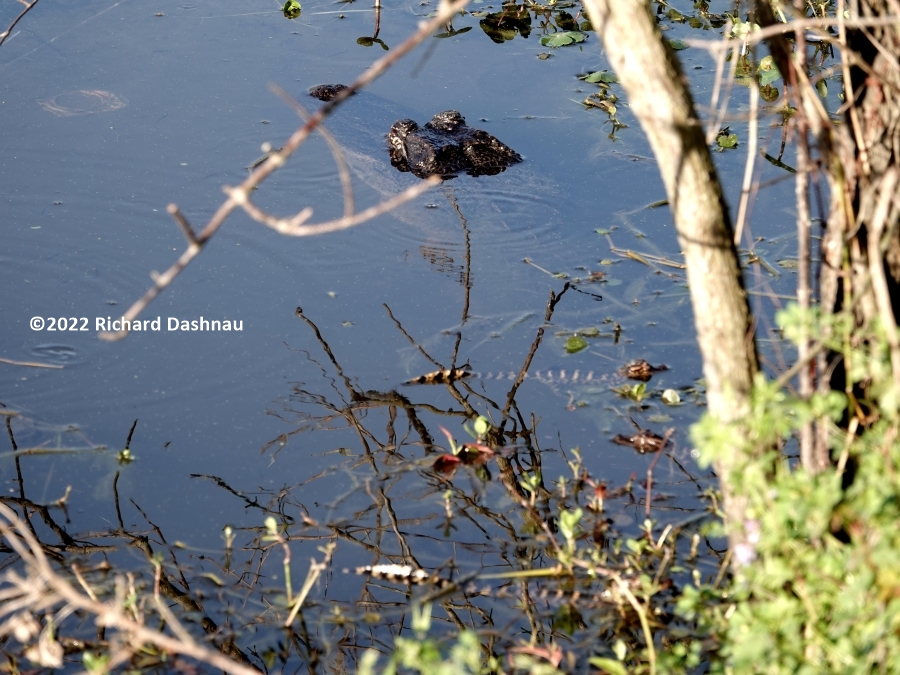
8:29am
8:31am
8:31am
8:36am
I
dipped the thermometer under the water about 30 minutes
later, it was about the same temperature as the air.(62° F). Mom
gator emerged from her burrow, and the baby gators began
to
surface
soon after. Mom gator left the burrow entirely, but I
had to
move on. When I returned at almost 1pm, many of the
baby
alligators were out of the water, but they piled near the
base of
the Button-Bush plant.
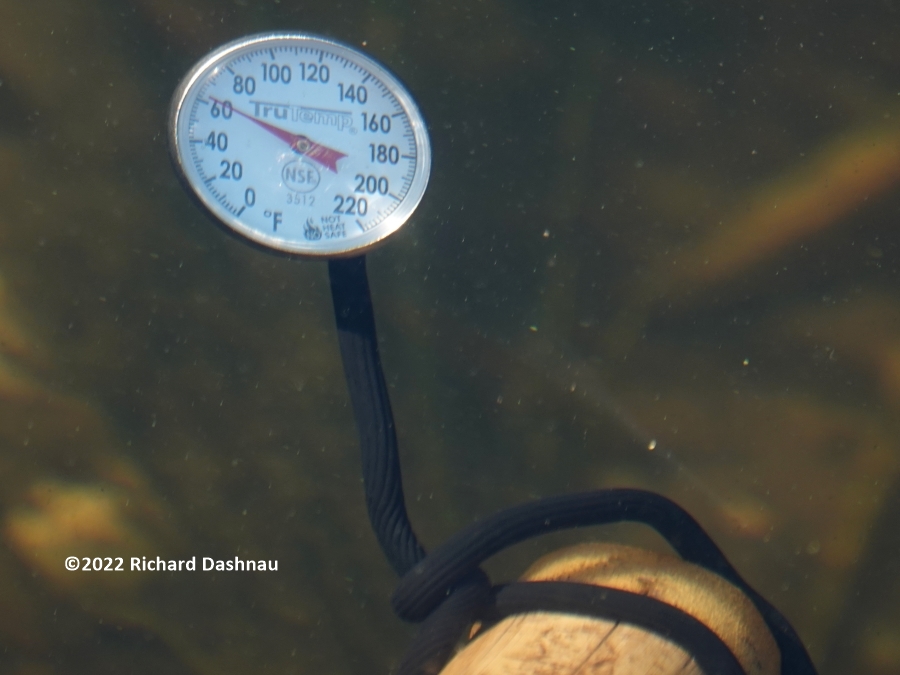
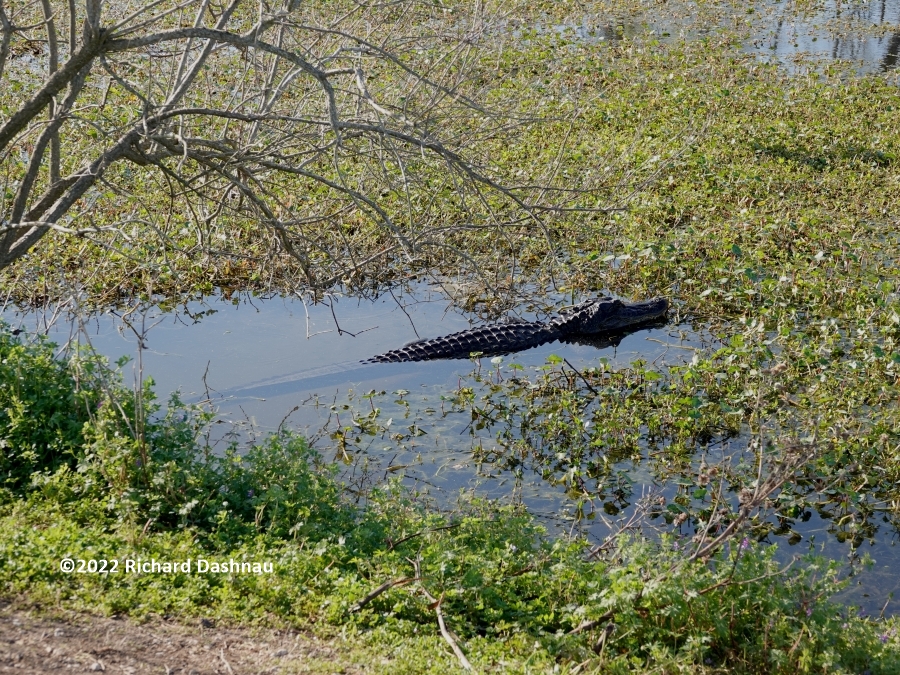
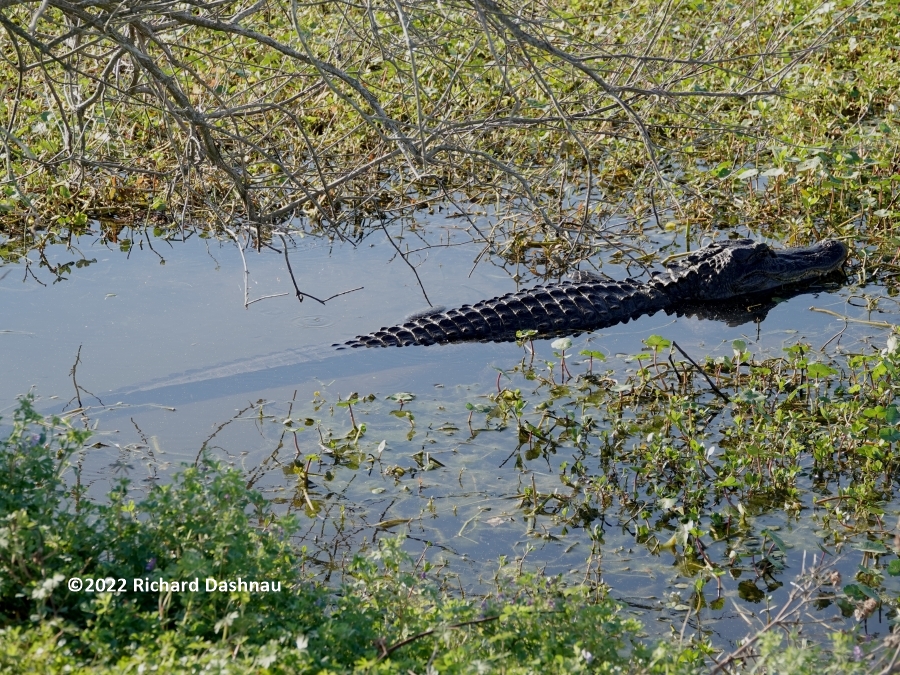
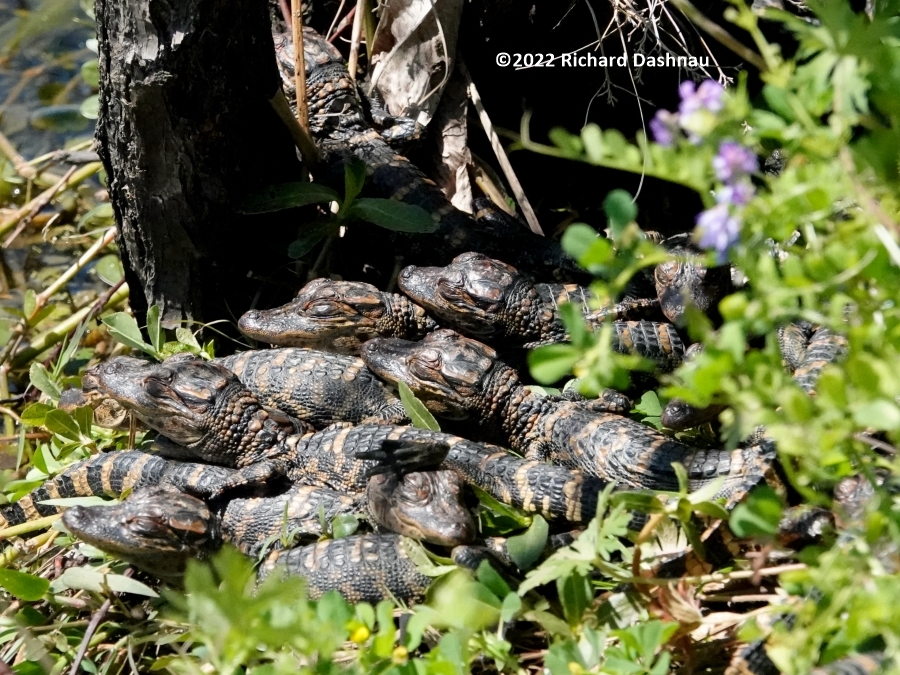
8:54am
9:18am
9:18am
12:50pm
03/27/2022. It was a
wonderful sunny morning at BBSP.
The pictures below are from that day. The
mother
gator's head was visible, and at least one of the babies
decided to
climb onto
the mother's nose. I had other things to do, so no
more observations from this day.
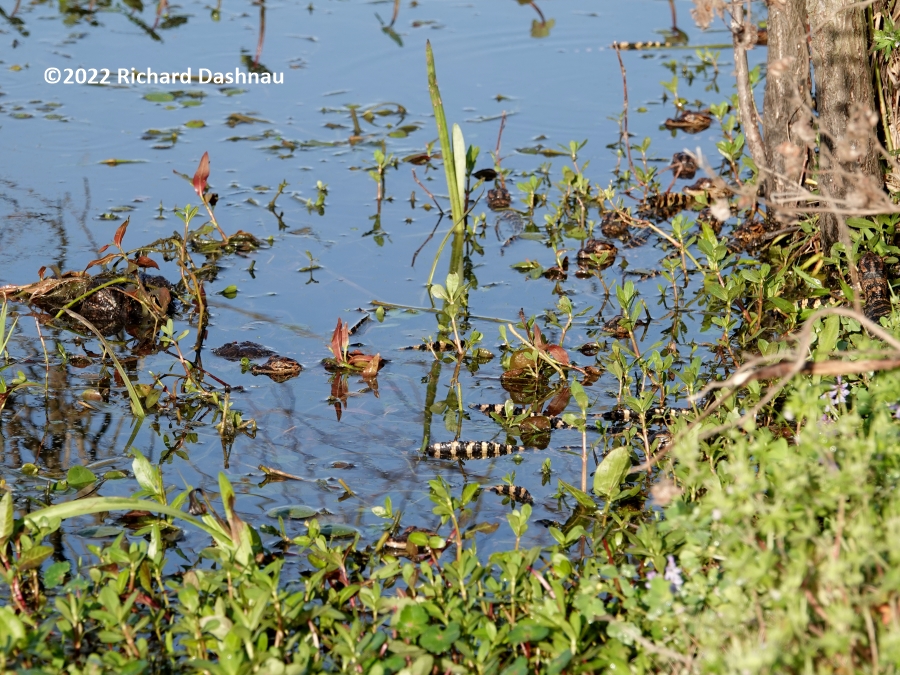
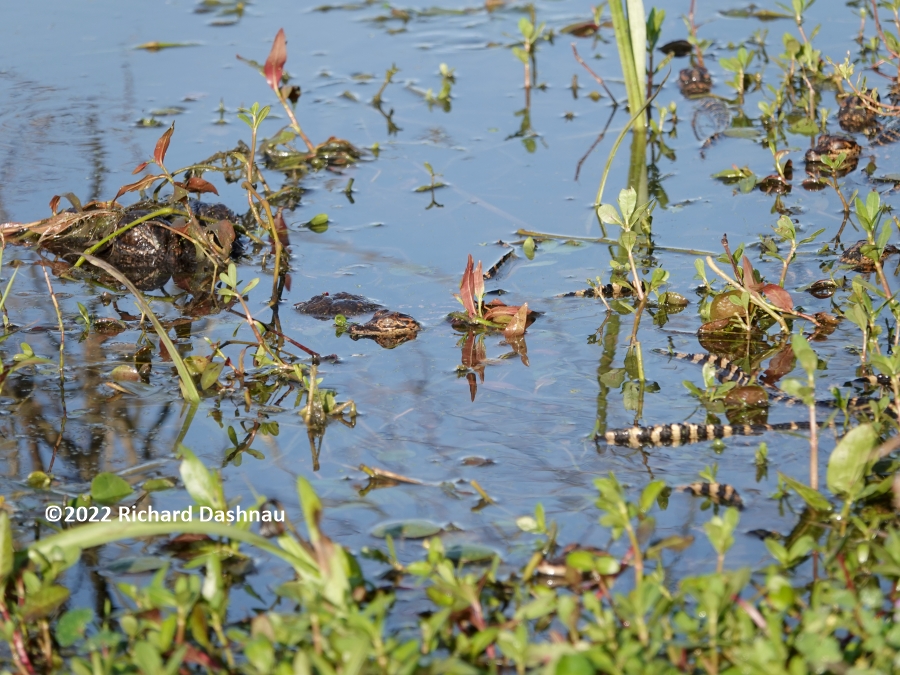
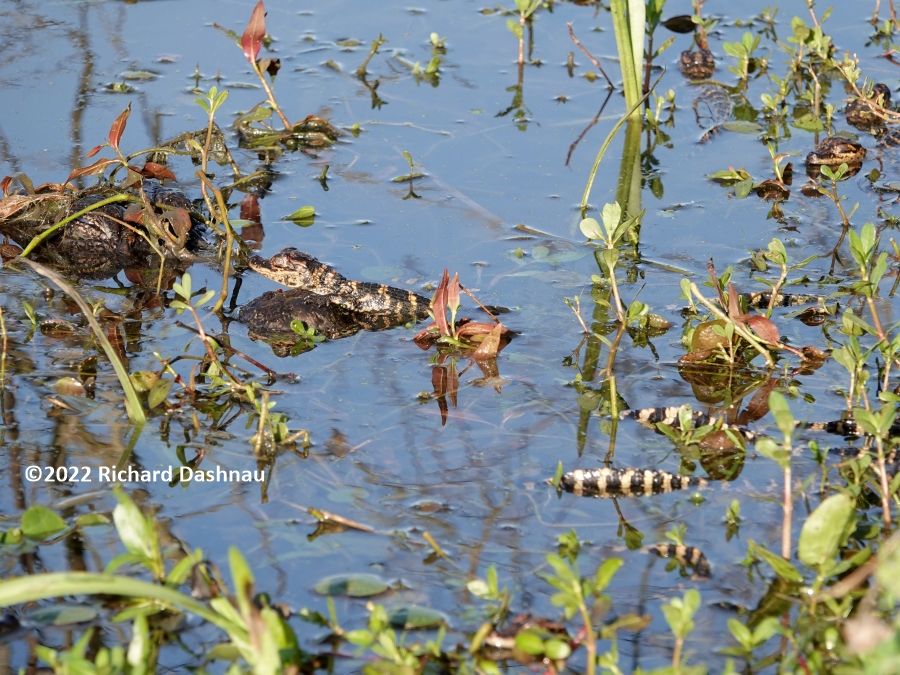
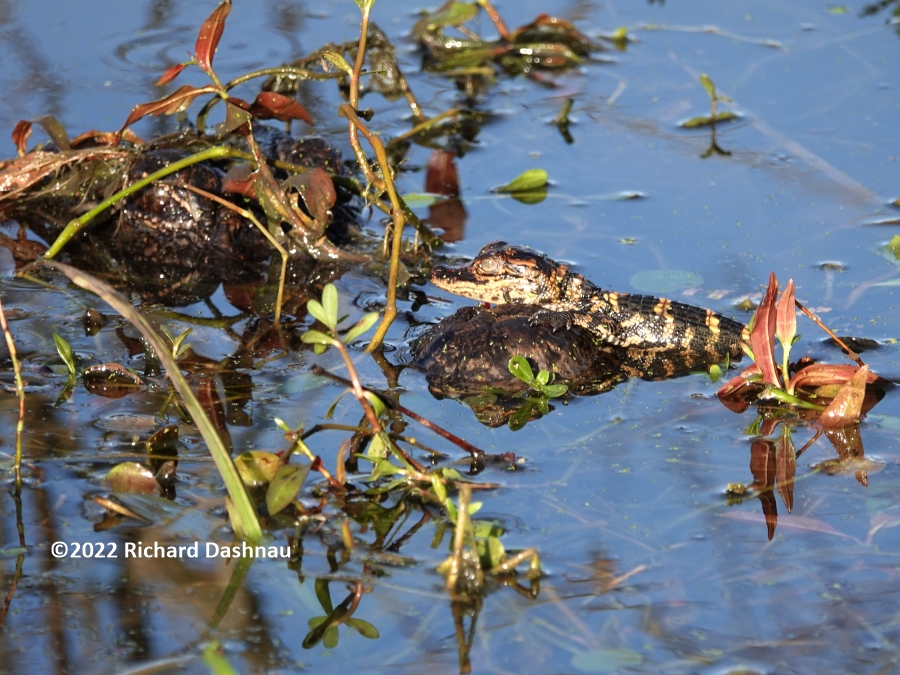
8:32am
8:32am
8:33am
8:33am
04/03/2022.
When I arrived near the den later than usual, and the mother
alligator wasn't visible. But a
bit later, she appeared from near the East tip of the island. the
first three pictures below
show
her swimming back to the den. A bit later, while I was
talking
with park visitors, a baby alligator appeared, but not near
the den.
It crossed the trail from behind us--from Pilant
Lake!
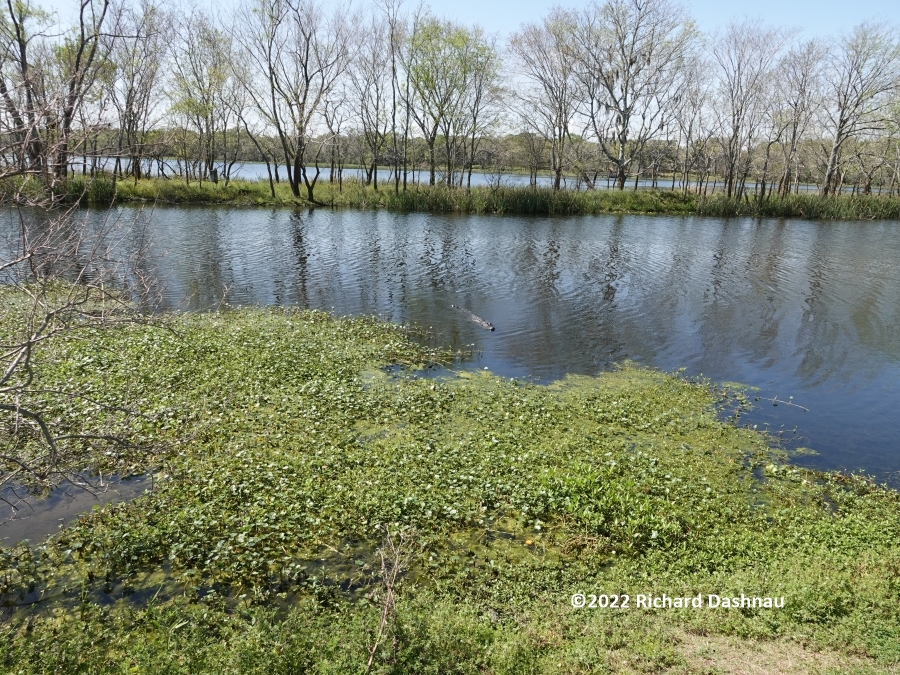



11:17am
11:17am
11:17am
11:54am
We
gave
it space as it crossed and moved through the grass and into
40 Acre
Lake. This was a big surprise, and I wondered where the baby
had been. The mom gator relaxed in her
cleared
spot, but the baby gators remained hidden-including the one
that had
just crossed the trail. About 2-1/2 hours later, I was
talking to
more visitors about the mom gator and babies;
and another
baby alligator appeared on the trail from Pilant Lake!




11:54am
11:54am
1:35pm
2:29pm
This
one
also walked across the trail and into the grass and plants
right
behind the mother( who was lying in the water).
However, that
baby didn't appear in the water to swim near the
mother.
Over
the next hour or so, the mother appeared to be digging at
the den
entrance. She submerged, and apparently went into the den.
Turbulence
and silt clouds showed that she was doing
something while submerged. She surfaced with lumps of mud on
her snout, and eventually swam out into the lake.




2:29pm
3:58pm
4:03pm
4:06pm
Mom
gator
swam across to the island, climbed onto the bank, and rested
for
just a few minutes. Then she crossed the island moved out of
sight. One
baby gator finally appeared in the water.
I
left soon after that. This was my last observation of
babies near
this den. There were a few sightings of babys a bit
further East,
but after that I couldn't find them.




4:06pm
4:09pm
4:09pm
4:11pm

4:21pm
01/01/2023.
As noted above, the baby gators had gone, and the den didn't
seem to be
relevant afterwards. But the following summer of 2022
was hard on
BBSP. Texas experienced a
drought, and water levels throughout BBSP dropped
dramatically (as described in part on my page here). There was some recovery
starting at the end November 2022, but the water level
in 40-Acre Lake was still about 4
feet low in
January 2023. The pictures below show the entrance to the
den described
above; but exposed by the low water (and vegetation knocked
down
by
winter conditions). Although the entrance is visible,
I didn't
see any signs that the showed the den was still being used.
(Although
another den was exposed about 40 yards West that did
show signs of
continued use.) These images show the den, but after
the mud
around it had been exposed for months, with new vegetation
grown around
what had been a mud bank. The
first image shows the den a full year previous (as described
above on this page).

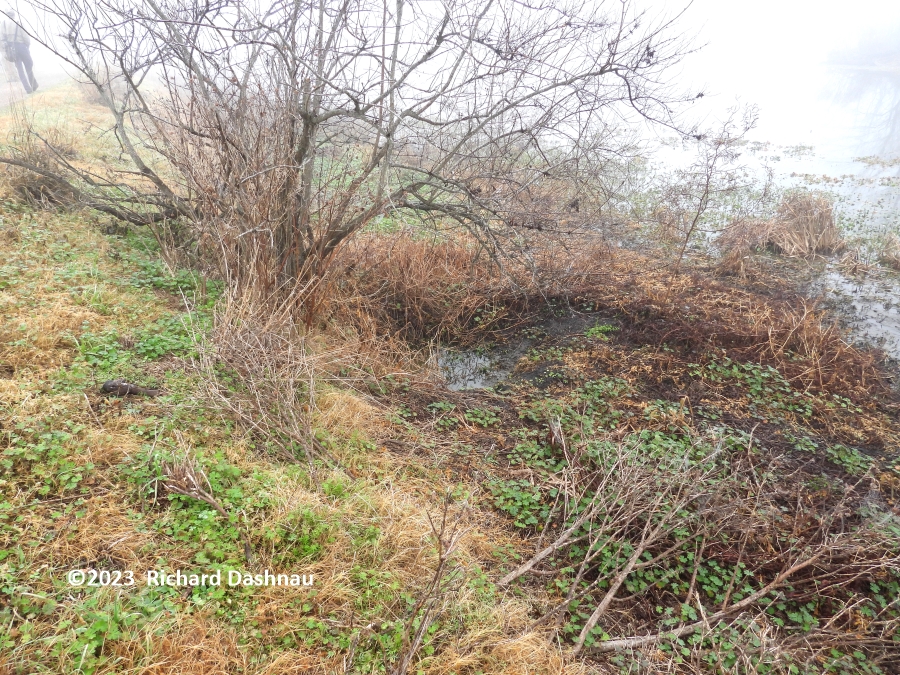
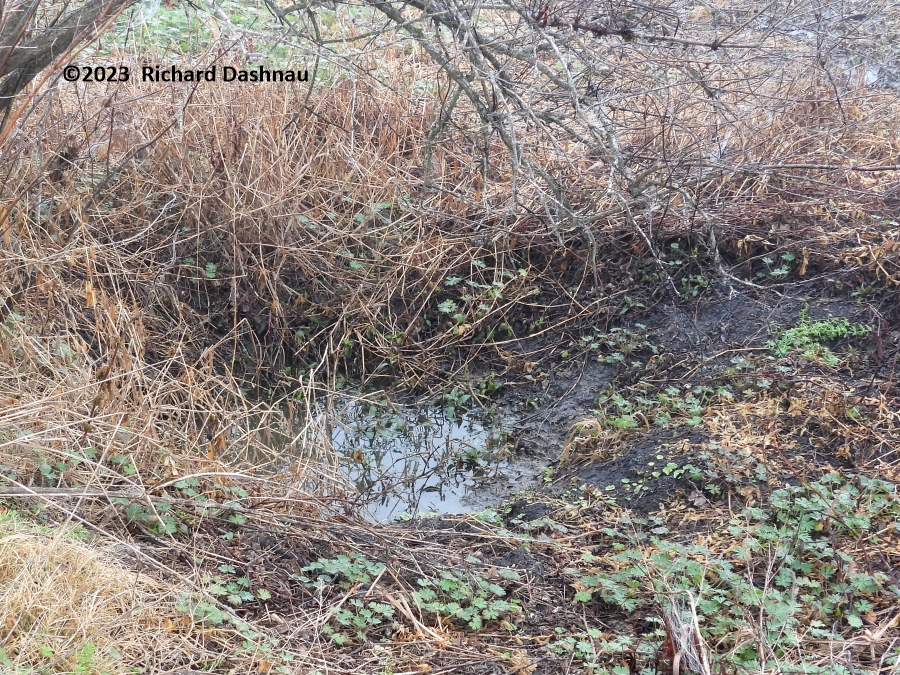
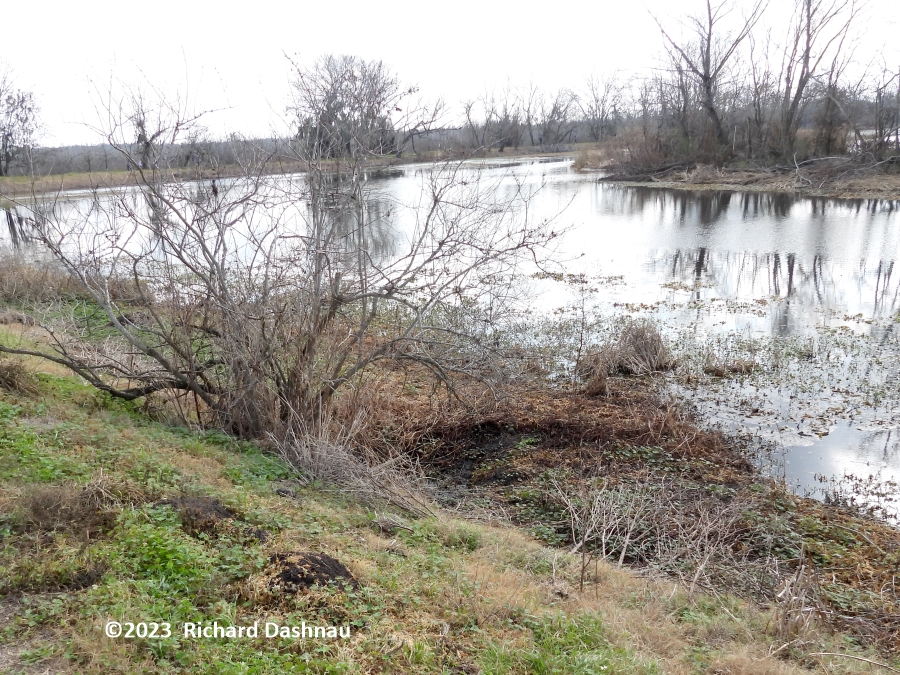
01/30/2022 (1 year ago)
01/01/2023 9:12am
9:12am
12:18pm
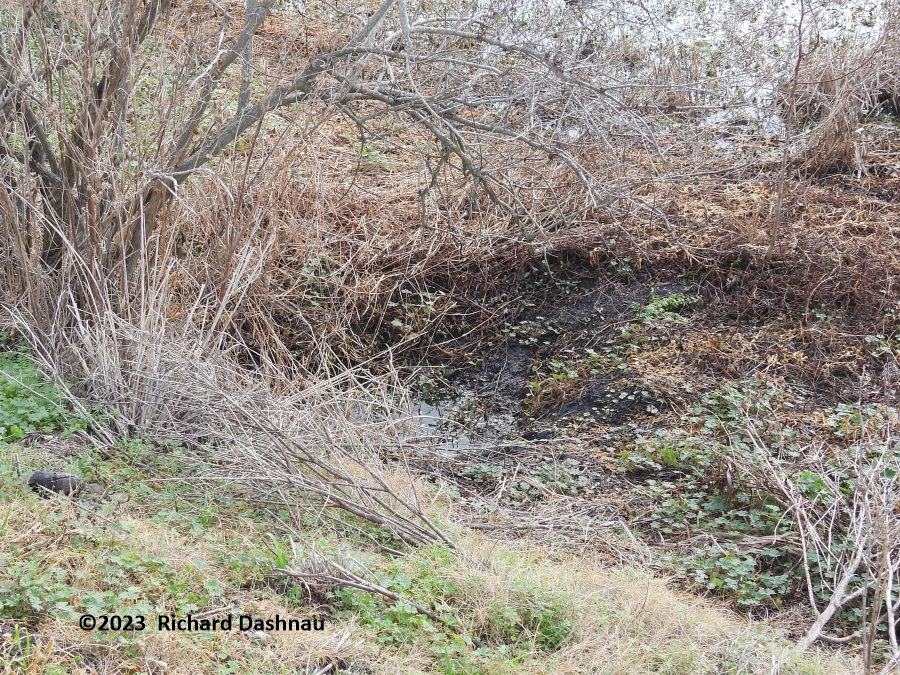
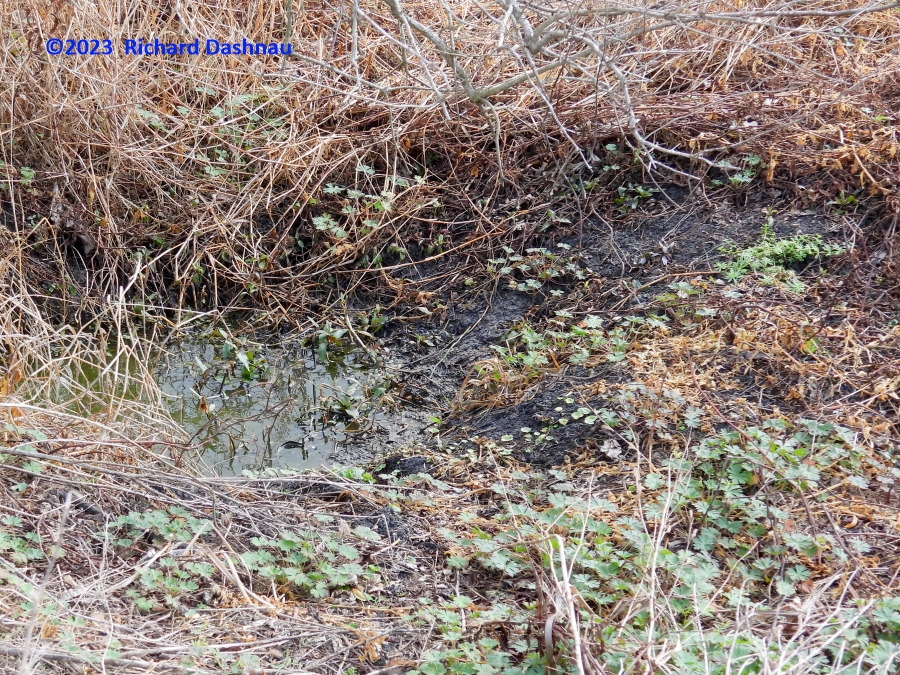
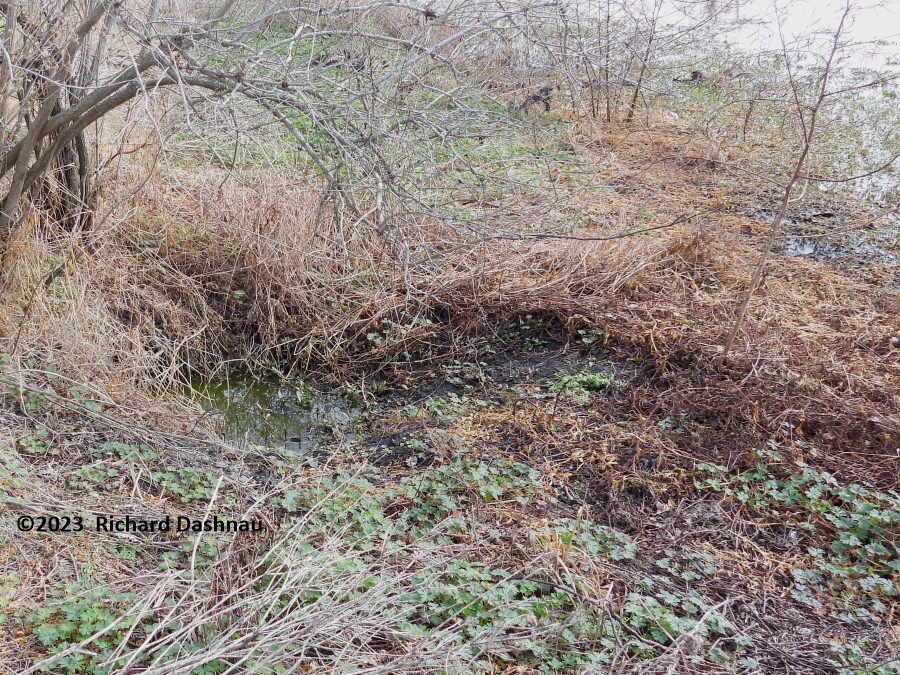
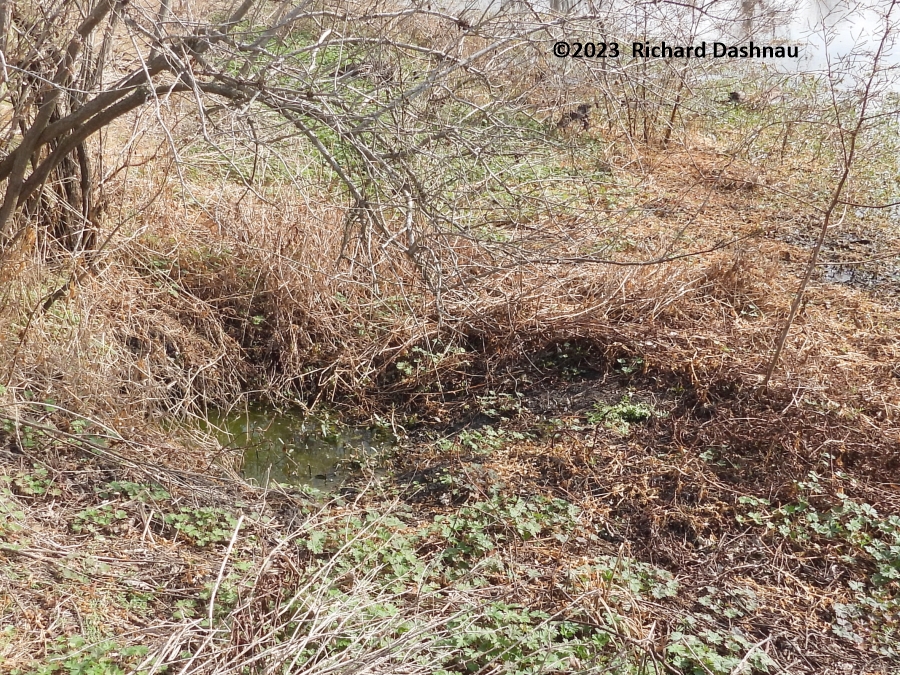
12:18pm
12:18pm
12:18pm
12:19pm
05/28/2023 Brazos Bend
State
Park A week ago 5/18, I had noticed that the den I call the "40 Acre
West Den" by the Buttonbush (Cephalantus
occidentalis)
showed
new signs of use (grass flattened, slide mark in mud). Since
then, I've been stopping by to see if I could find an
alligator
in or near it. There appears
to be a grassy hump
in front of the den, but I don't think it's a nest. After comparing
with older images, I can see that the hump has always been there.
Grass
grew on it, and
now that it's flattened it gives the illusion of a
pile of grass stalks. I believe that it's just a layer of crushed
grass
on top of the mud hump and not a pile of old grass. The 4
images below show the den earlier this year.




01/01/2023
01/22/2023
02/12/2023
03/19/2023
While looking at the bush today, I
noticed the amazing flowers on the Buttonbush (Cephalantus
occidentalis), and decided to take a few pictures of those.




While
I was shooting photos, some butterflies and a few wasps came by. I
think that this was a Black Swallowtail (Papilio polyxenes), and
it's a
male--at least judging
from the colors when I compared with images online. I thought
my photos were nice, so here they are.




And,
this
page shows alligators at the park, on land, near various
landmarks at the park.
Go back to my main alligator page, Alligators
Go
back to my home page, Welcome
to rickubis.com
Go
back to the RICKUBISCAM
page.
Go
back to the See
the
World
page.






































































































































































